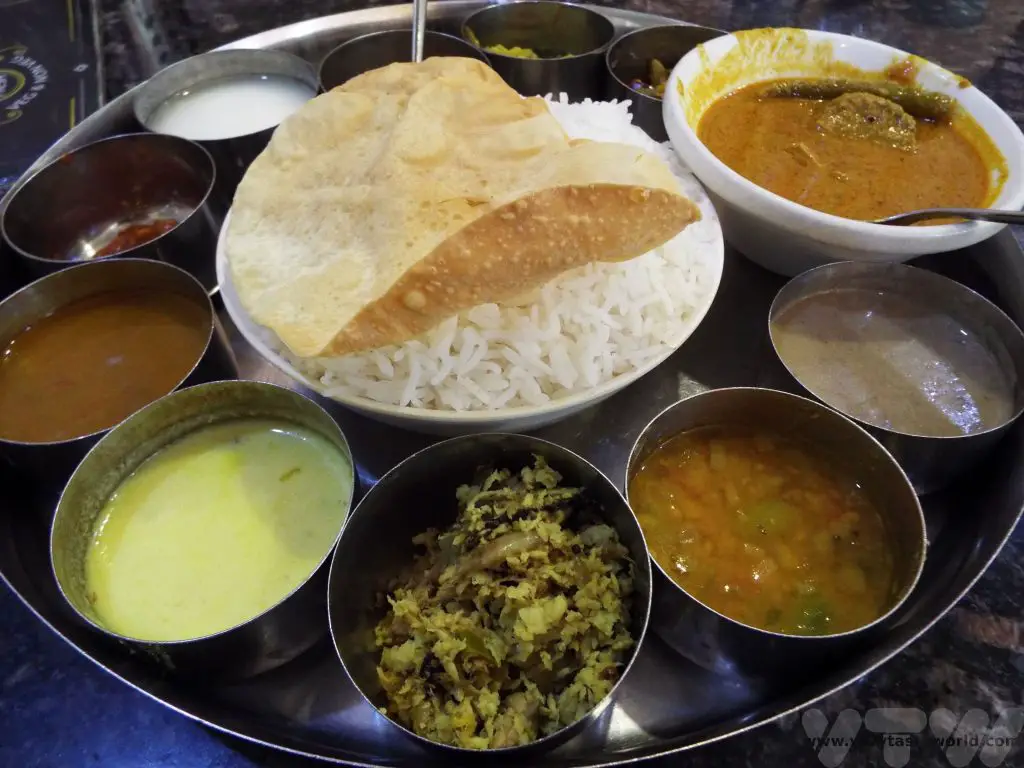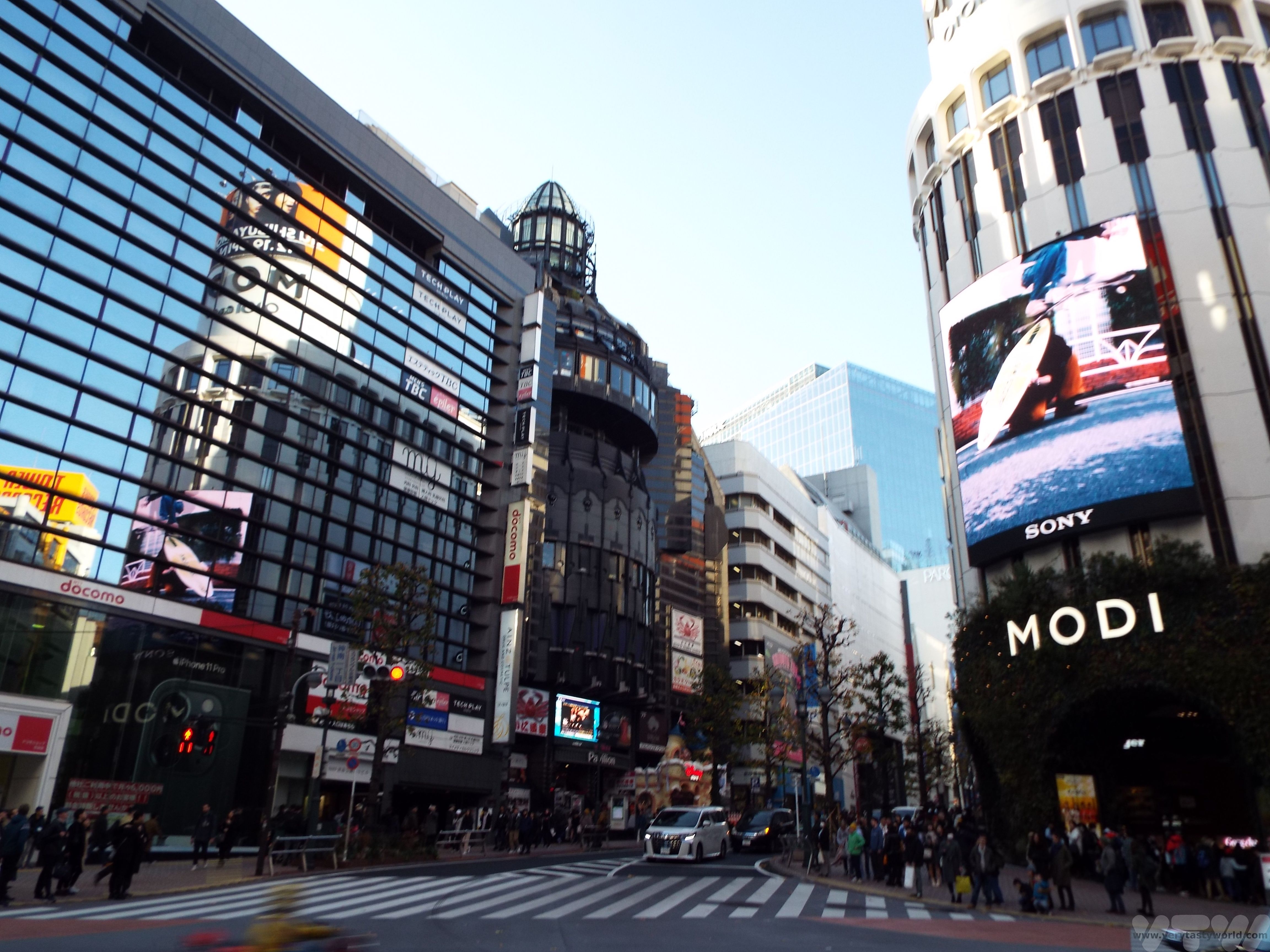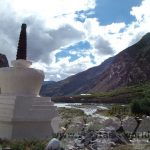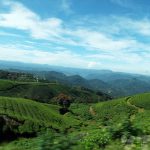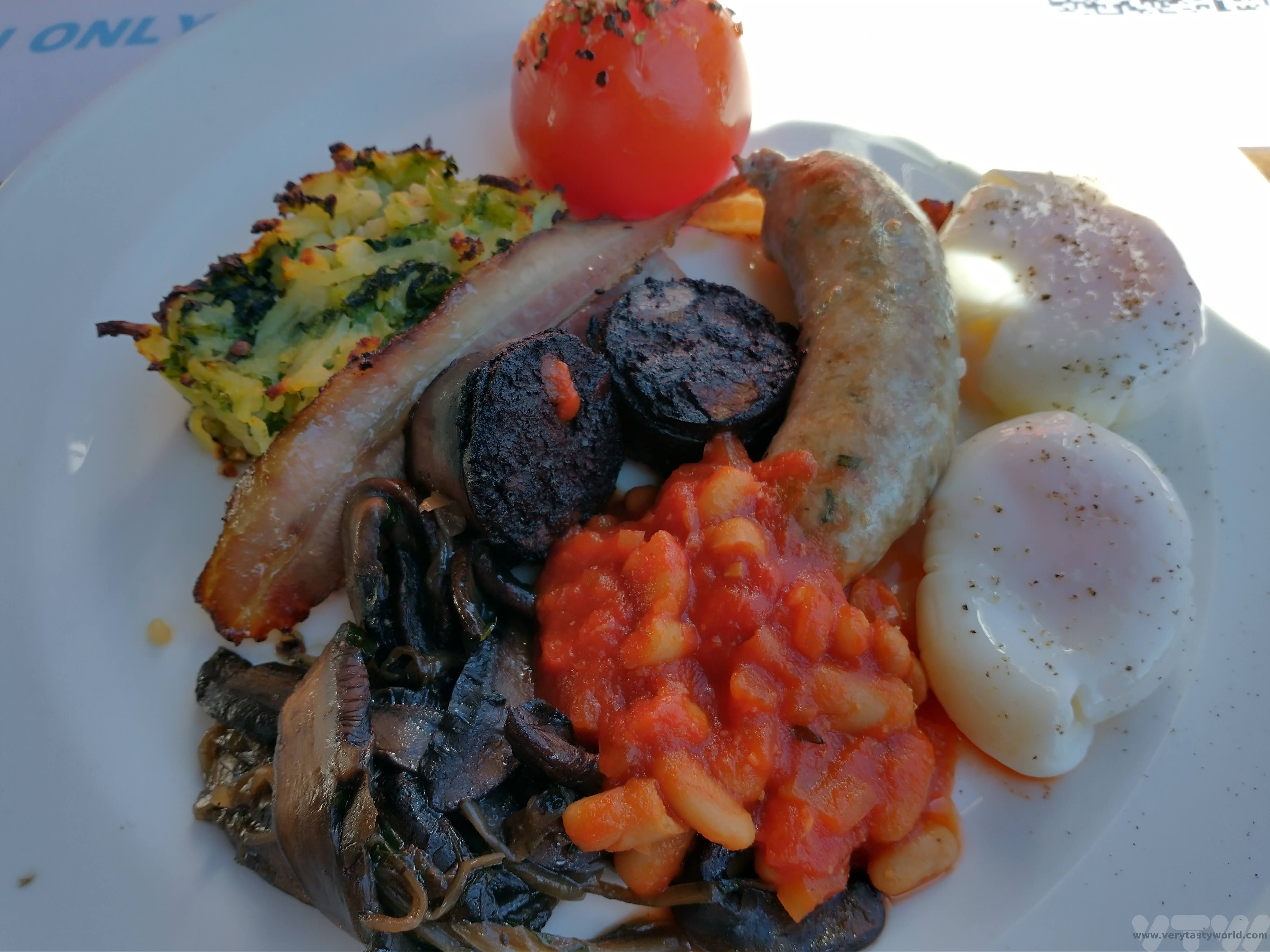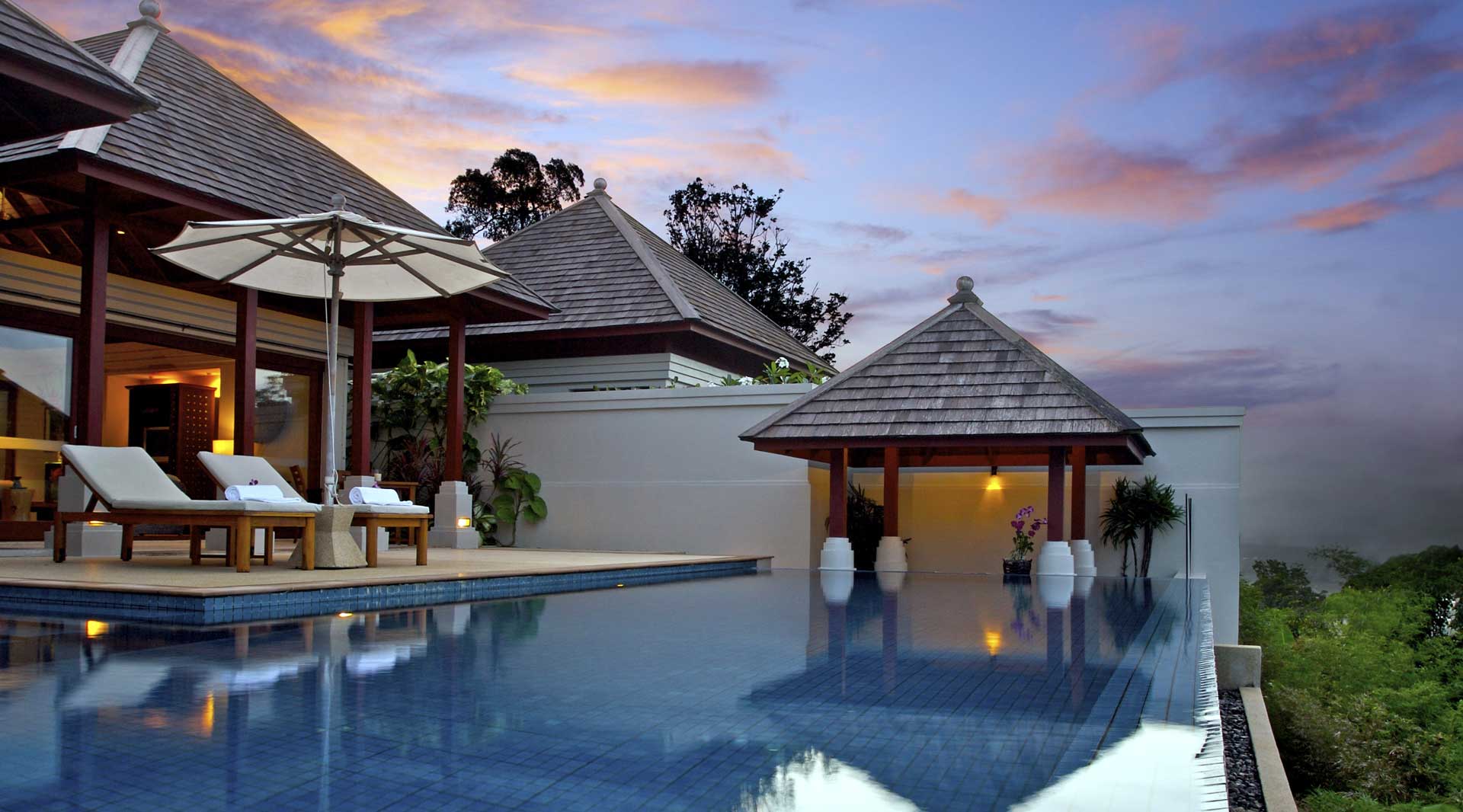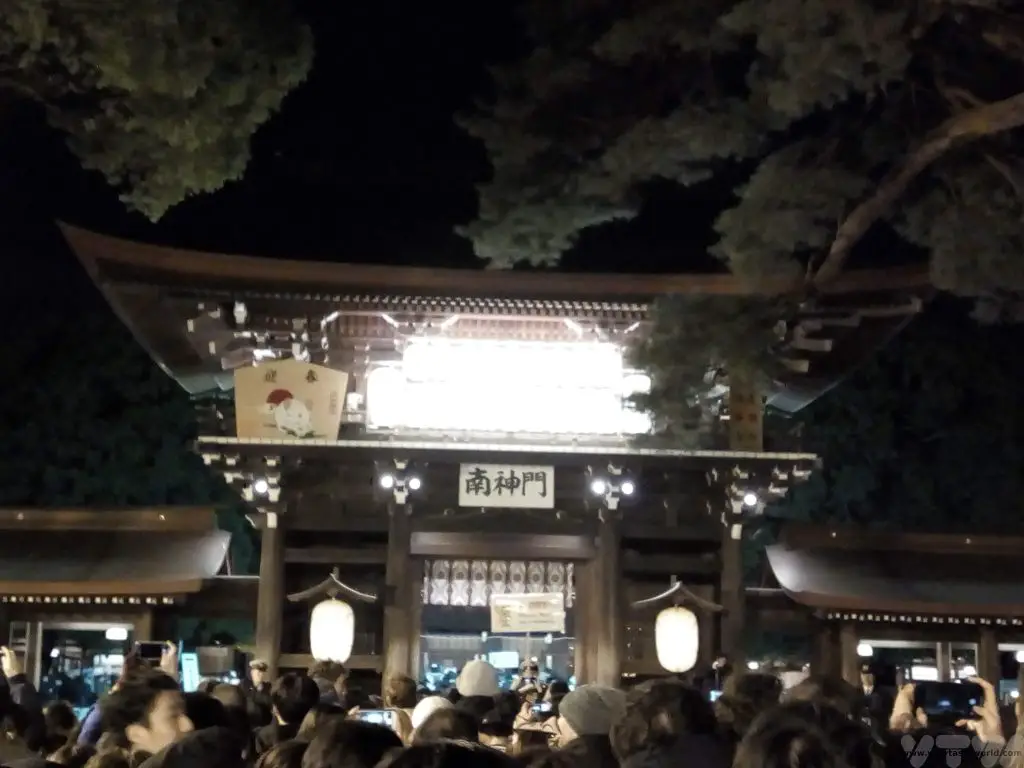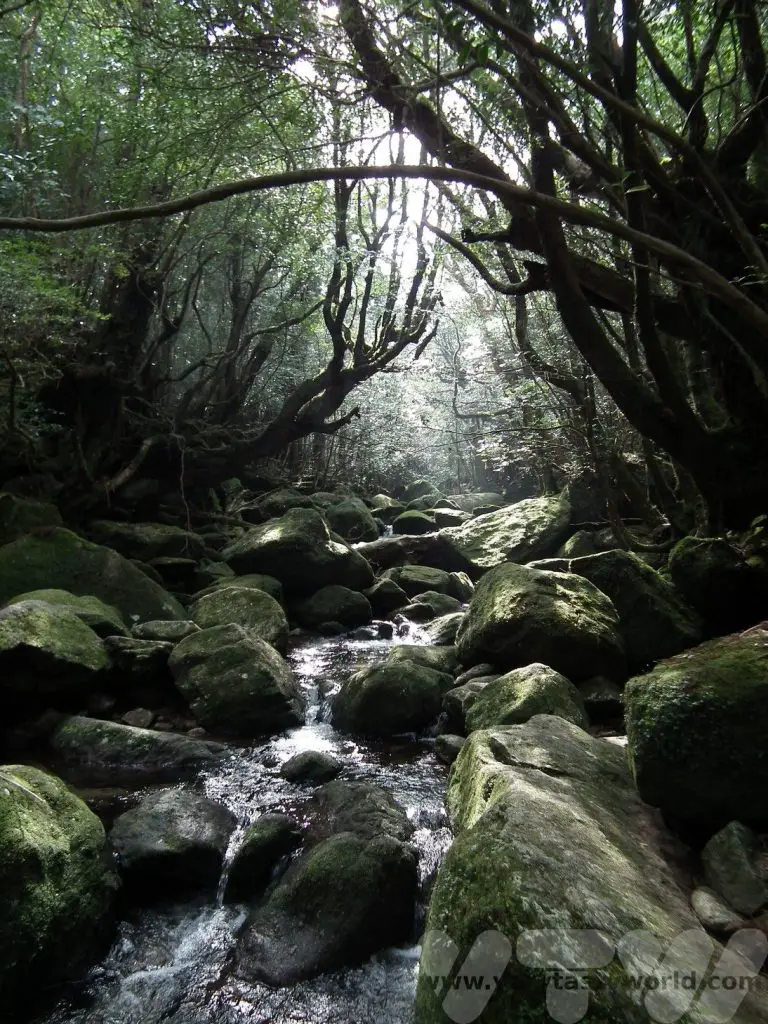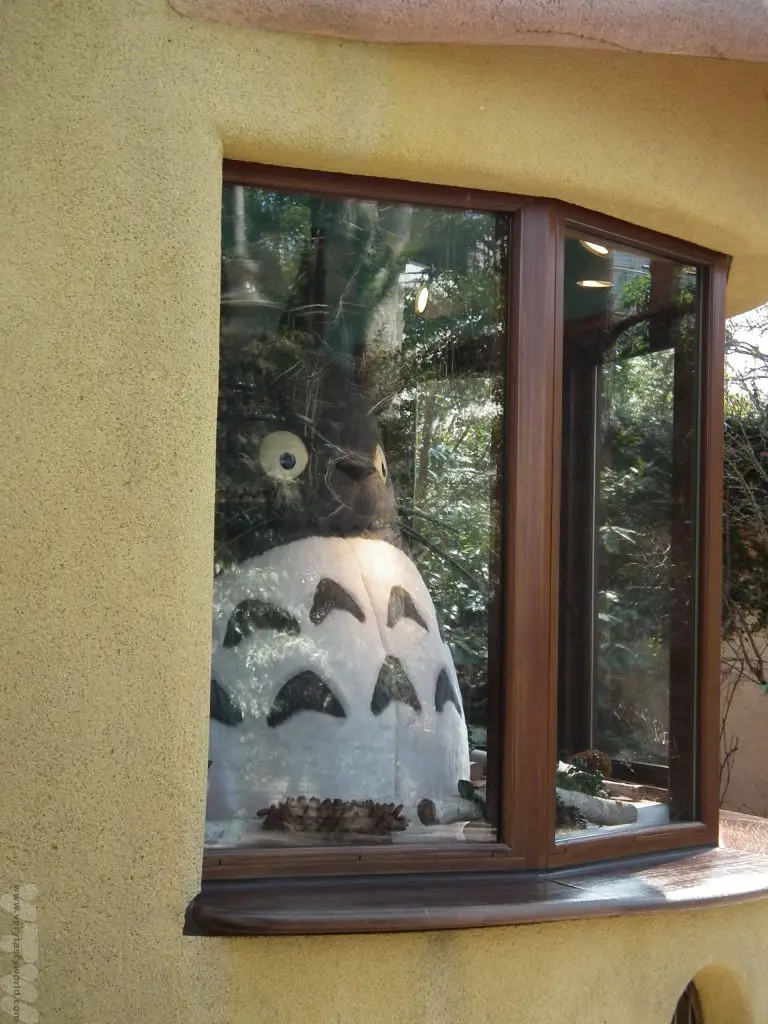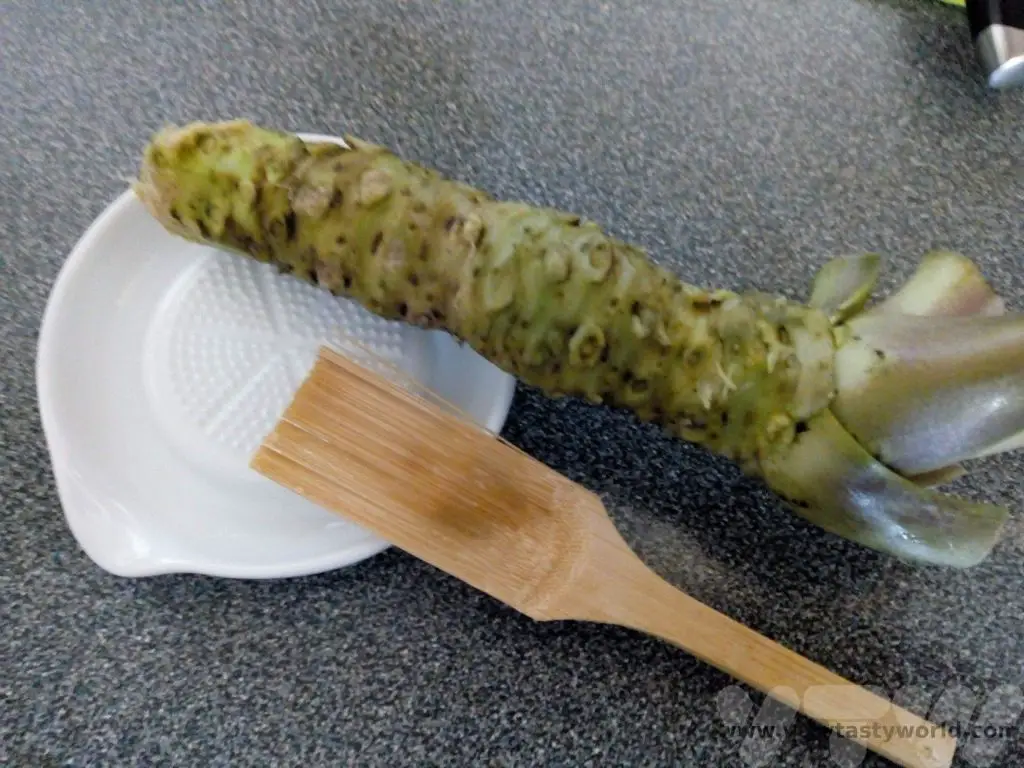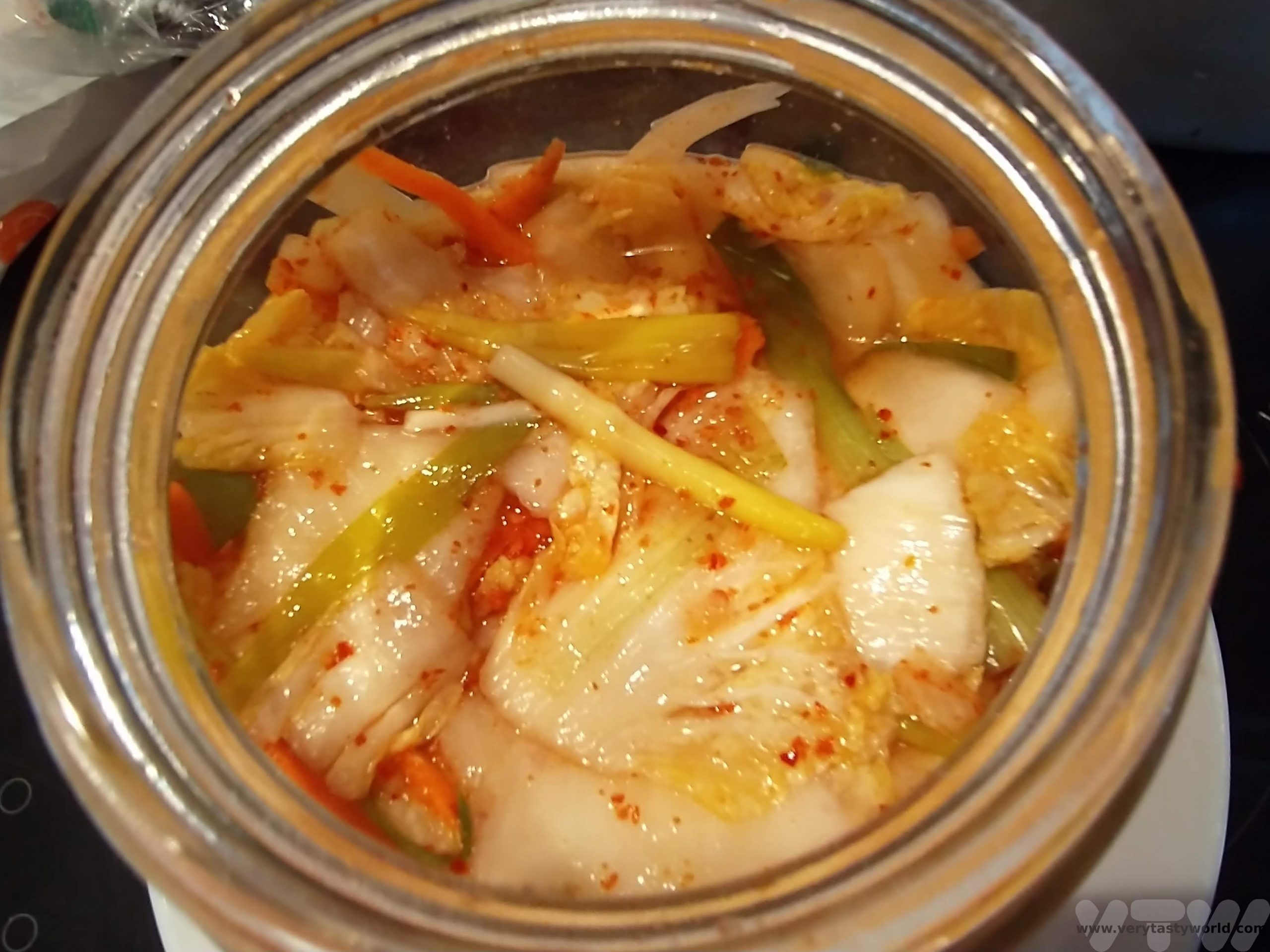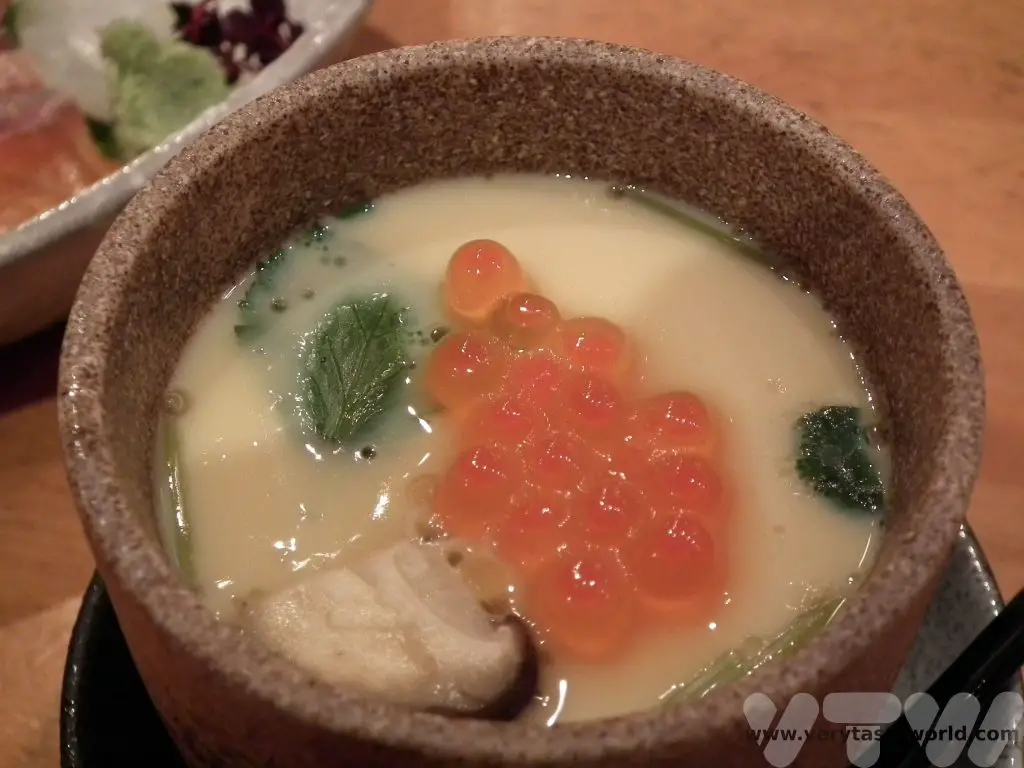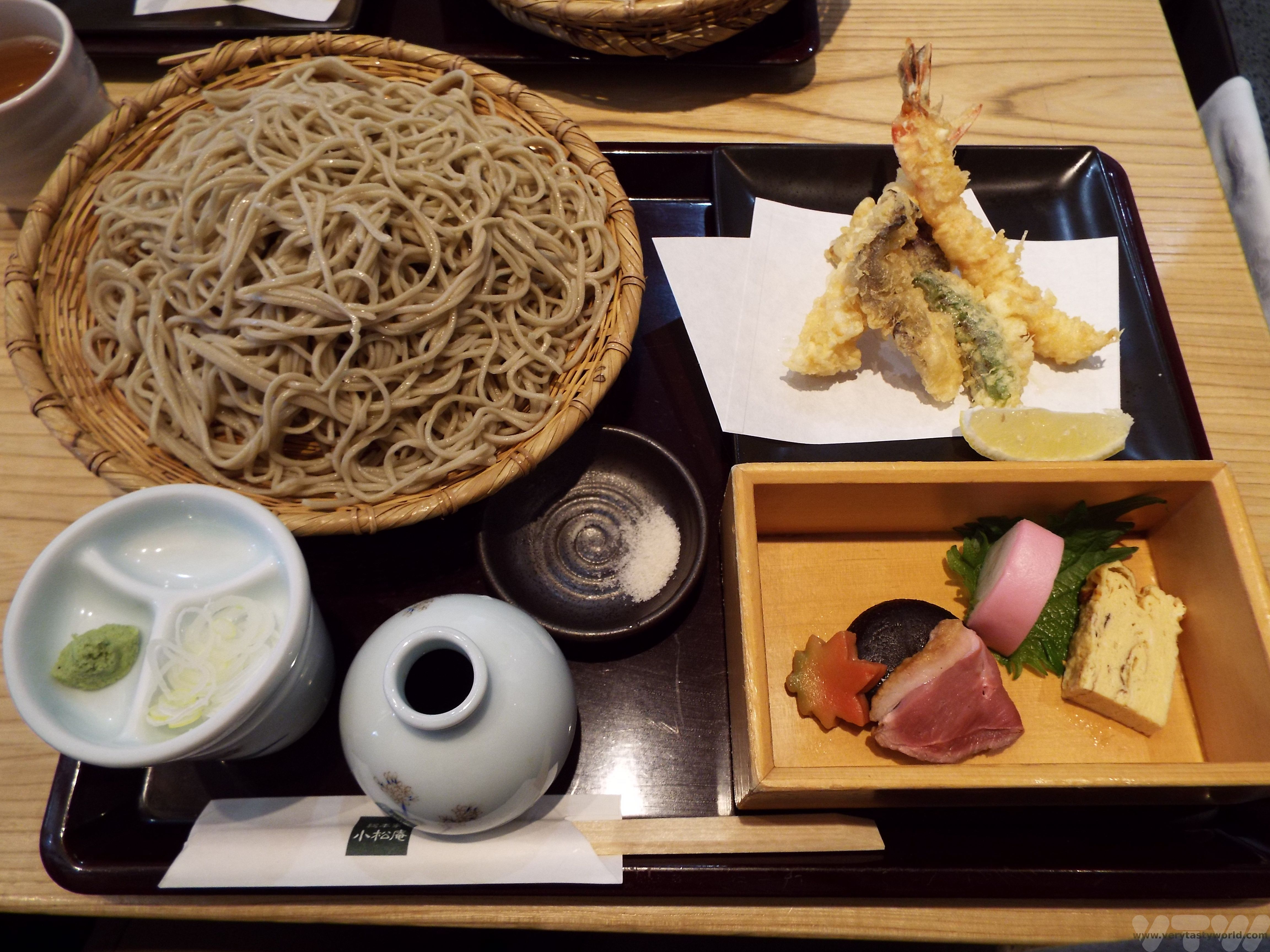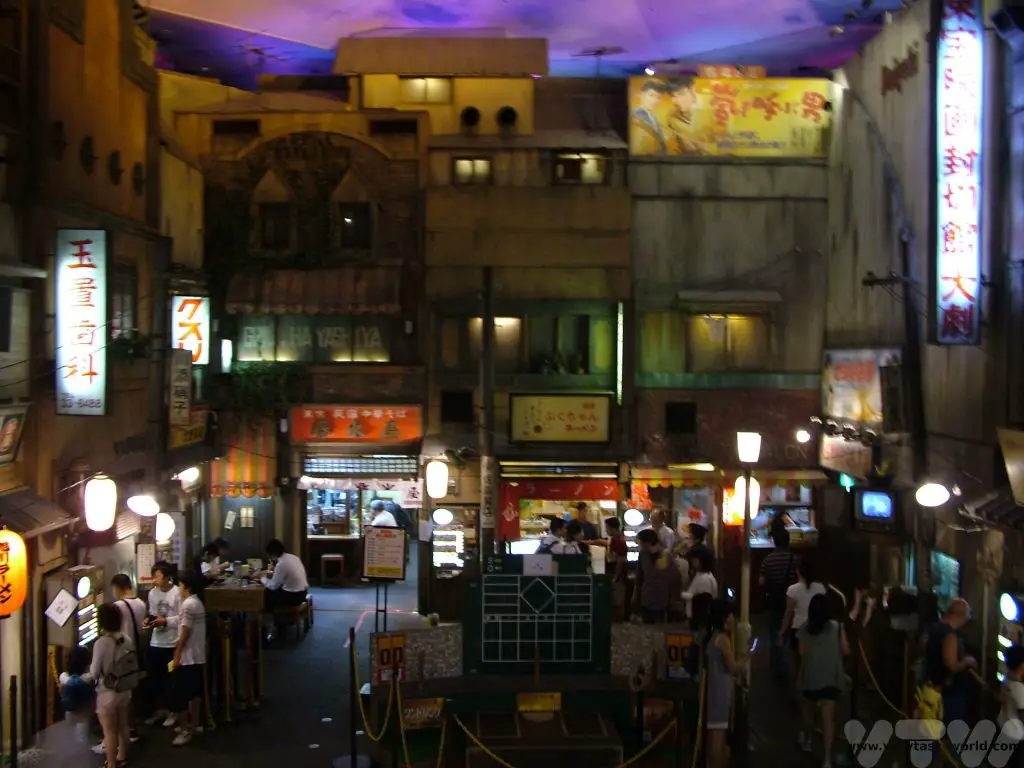World’s Best Breakfasts -Breakfast of Champions!
….And Why It’s Often Okay to Go Off-Menu When Travelling
Many years ago we were excitedly choosing all sorts of delicacies at the breakfast buffet at our hotel in Yerevan, Armenia, when another guest glanced at our plates, shrivelled their noses in a very patronising manner and exclaimed, “Ugh! Salad? For breakfast?” It’s widely considered to be most important meal of the day but so many people seem to be set in their ways when it comes to eating a hearty breakfast. So much that hotels all over the world seem to offer pretty much the same fare. Western visitors are often offered fried food such as bacon, sausage and eggs with bread-based accompaniments and Eastern visitors are usually offered rice or noodle dishes. All these dishes are generally familiar to the tourist and often don’t reflect the traditional breakfasts of the country they are visiting. Here are some of the world’s best breakfasts.
Maybe it’s because people don’t feel so adventurous first thing in the morning, and that’s fair enough, but they may be missing out. Thing is, we’re British and can have bacon and eggs any time we like. (Although, to be honest, we haven’t cooked a fry-up for years as it’s quite a lot of effort.) We’d much rather eat a typical breakfast using local ingredients from the country that we are visiting.
It’s quite common for hotels to ask their guests to pre-order breakfast. It makes sense, they know what they need to order in beforehand and this can help minimise food waste. There is usually a form with tick boxes and you can choose from a variety of typical breakfast offerings. But if you do want to eat like a local, we’ve learned that many hotel restaurants are happy to cook you a regional breakfast. We’ve discovered that very often it’s absolutely okay to go off menu.
It all started in Uganda when we breakfasted at a lodge with a local guide. We were eating standard fare but our curiosity was piqued when something entirely different was brought out for him. On asking, we learned that it was a rolex – a chapati with a layer of omelette on top, then rolled into a spiral cylinder, perfect for munching on. So the next day we asked the lodge staff if it would be possible for us to have a rolex for brekkie and they were happy to oblige. It’s great – tasty and filling – a good start to the day.
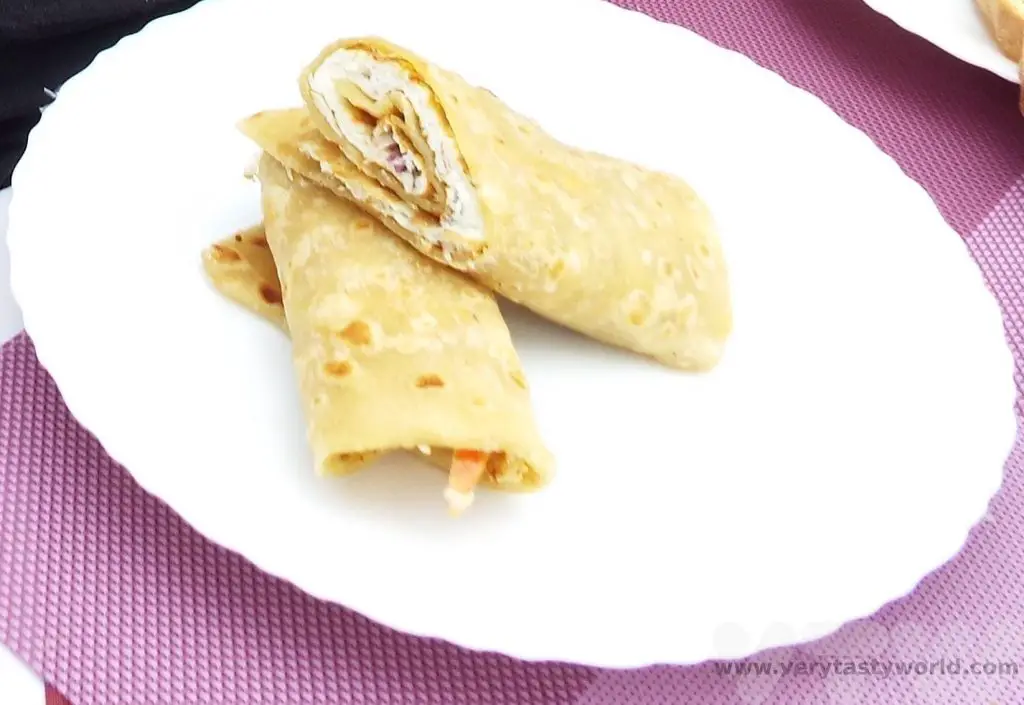
In Nepal we were given a standard pre-order form to complete (eggs, bacon, sausage, toast…) to pre-order breakfast for the following morning. We politely asked whether it was possible to have a local breakfast instead. We didn’t specify any dish – just asked for local food. They were delighted. The following morning we were served a marsala omelette accompanied by a joyous curry and roti with home-made yoghurt. It was delicious.
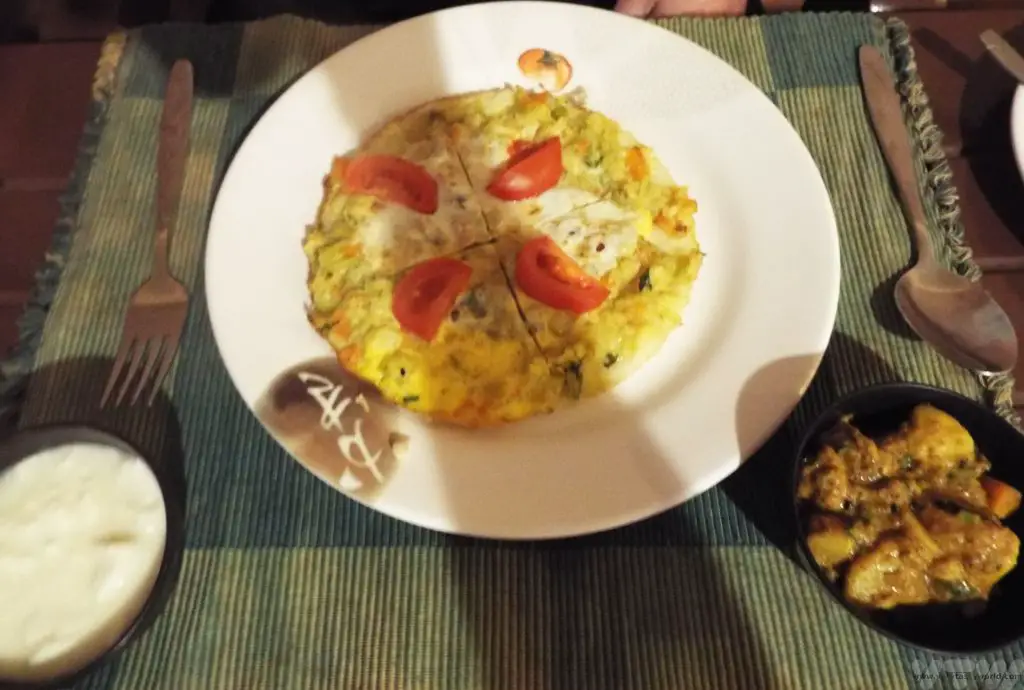
One of the world’s best breakfasts is gallo pinto from Costa Rica. It’s so popular it is often eaten for lunch and dinner as well. Which is just as well because it tastes great and is also really healthy. It comprises rice and beans and is usually accompanied by a fried egg at breakfast. Other accompaniments to start the morning include sausage, fried potatoes and some salad.
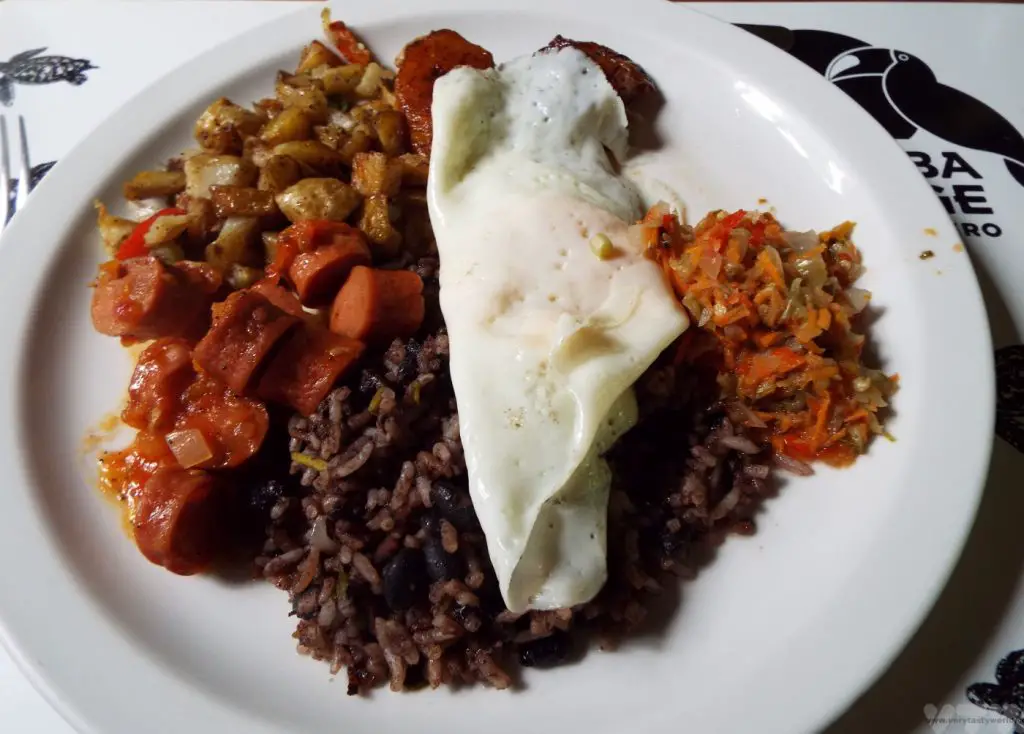
A dosa for breakfast in South India is an absolute joy. This is a pancake traditionally made from rice and dal (lentils) which are ground to form a batter and then fermented. The batter is cooked on a hot plate to form a large pancake and served with chutney – coriander, coconut and tomato are particularly popular.
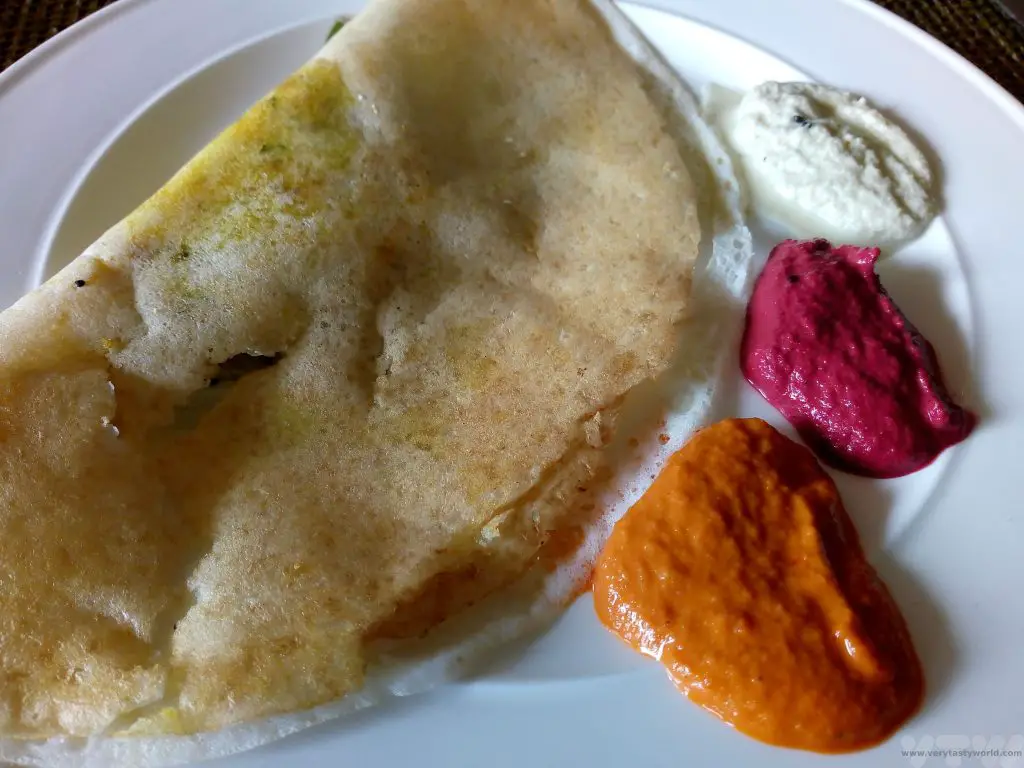
In Vietnam breakfast usually took a buffet form but often there were chefs on-hand to cook some food to order. We were always offered Pho – a tangle of noodles, freshly cooked and served in a yummy broth, topped with meat and vegetables. You pick up a side plate and add herbs, chilli, limes and other delicious items so that you can create your own personalised taste sensation. The liquid of the broth also ensured that we were thoroughly hydrated for the day ahead.
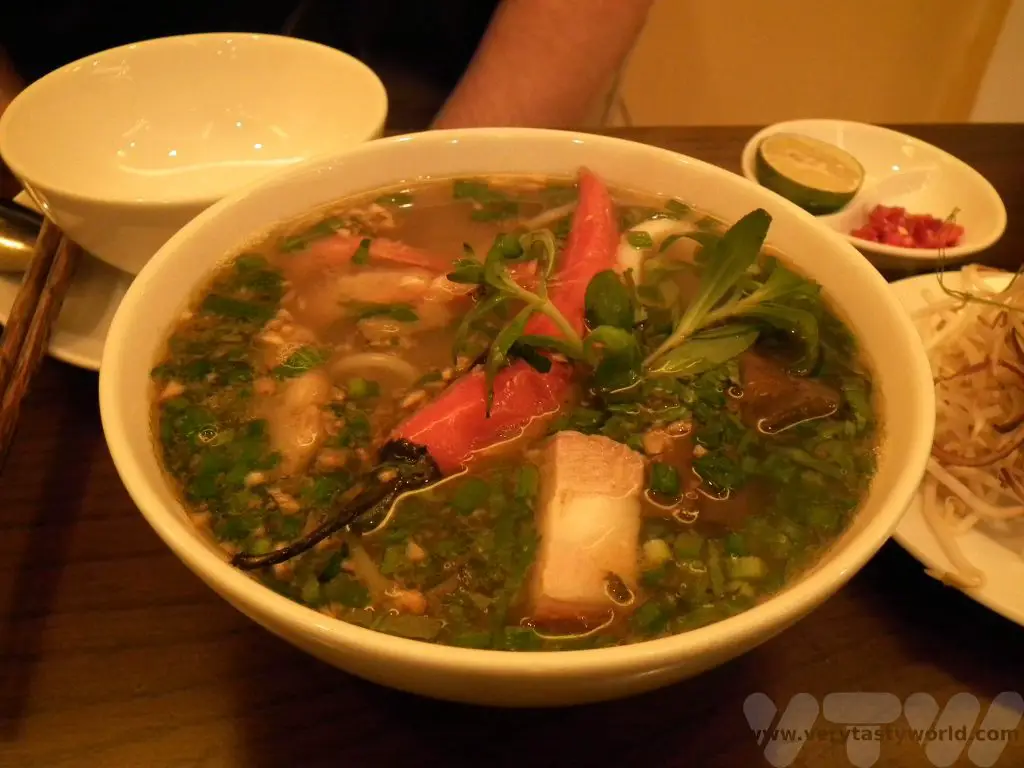
Japan also offers some of the world’s best breakfasts. A Japanese brekkie often comprises grilled fish, vegetables and pickles, maybe with tofu, dumpling and an omelette.
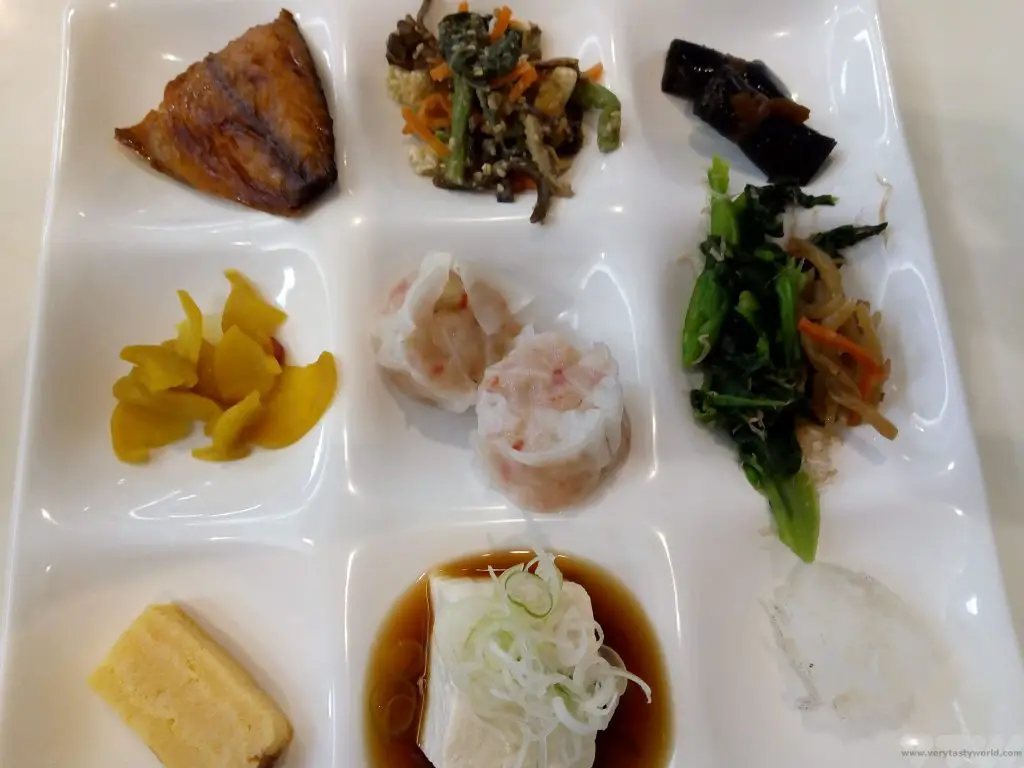
These are accompanied with a bowl of rice, into which you could crack a raw egg mixed with shoyu (soy sauce) – the egg sort of cooks in the heat of the rice – or that famous smelly fermented soybean concoction, natto, maybe with some sliced negi (similar to spring onion). Just grab a slice of nori (dried seaweed), place it over the rice, then using a pincer movement with your chopsticks grab a portion of rice with the nori. Scrumptious. (It’s worth noting that if you are at a breakfast buffet in Japan the eggs on offer may well be raw – be careful when cracking them.)
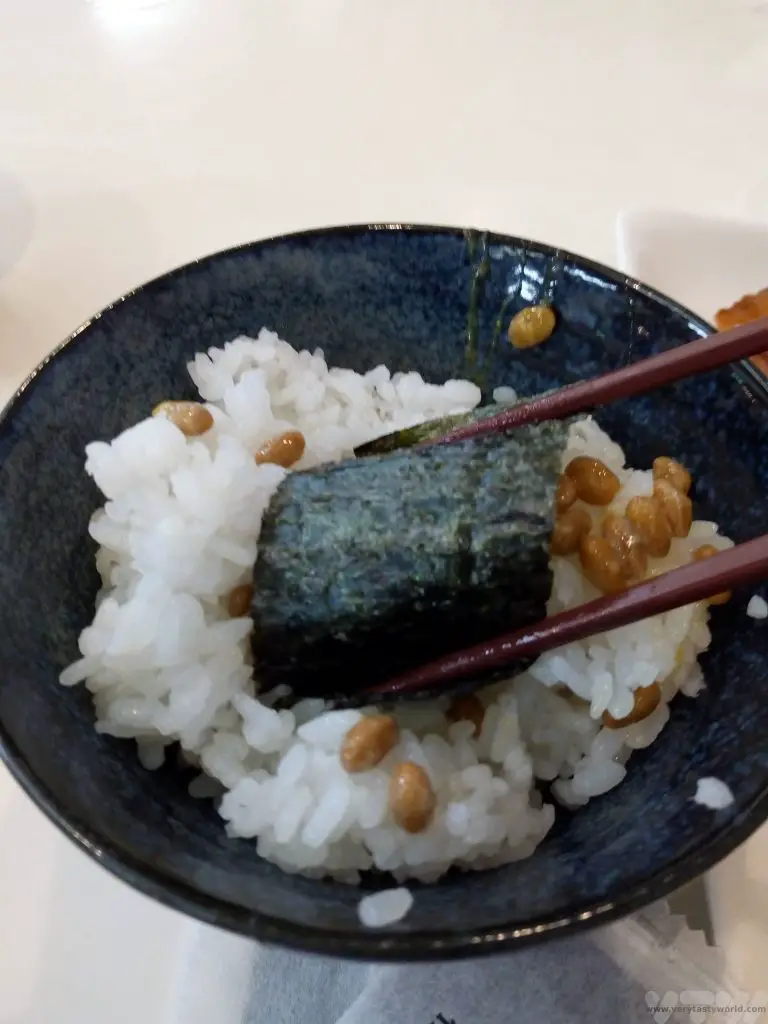
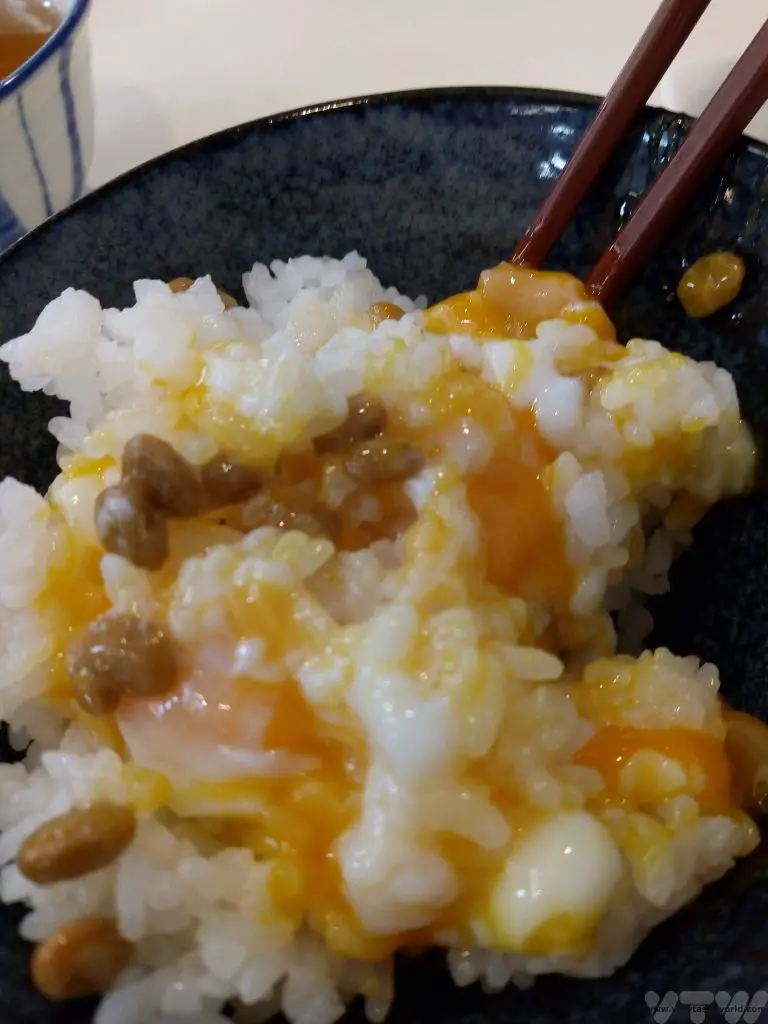
World’s Best Breakfasts – Back At Home
And, of course, whenever we are staying away from home in the UK, we’ll always have an honest-to-goodness fry-up. Sausage, bacon, egg (usually fried, poached or scrambled), black pudding, mushroom, tomato, beans and sometime a hash brown are the usual components.

We recently discovered that the best possible place for a full English breakfast that we’ve ever eaten is actually in our home town. While many top breakfast establishments boast locally sourced food (which is, of course, delicious), The Gourmet Food Kitchen in Fargo Village, Coventry go one step further and actually cure their own bacon and make their own sausages and black pudding. And that’s just the start: The hash brown (never the most fabulous component of breakfasts) is a home-made bubble and squeak, a glorious blend of fried potato and cabbage. The beans have never seen a tin – they are home-made baked beans in a rich tomato sauce. Chef Tony even makes his own rich, tangy and utterly delicious brown sauce to accompany the feast.
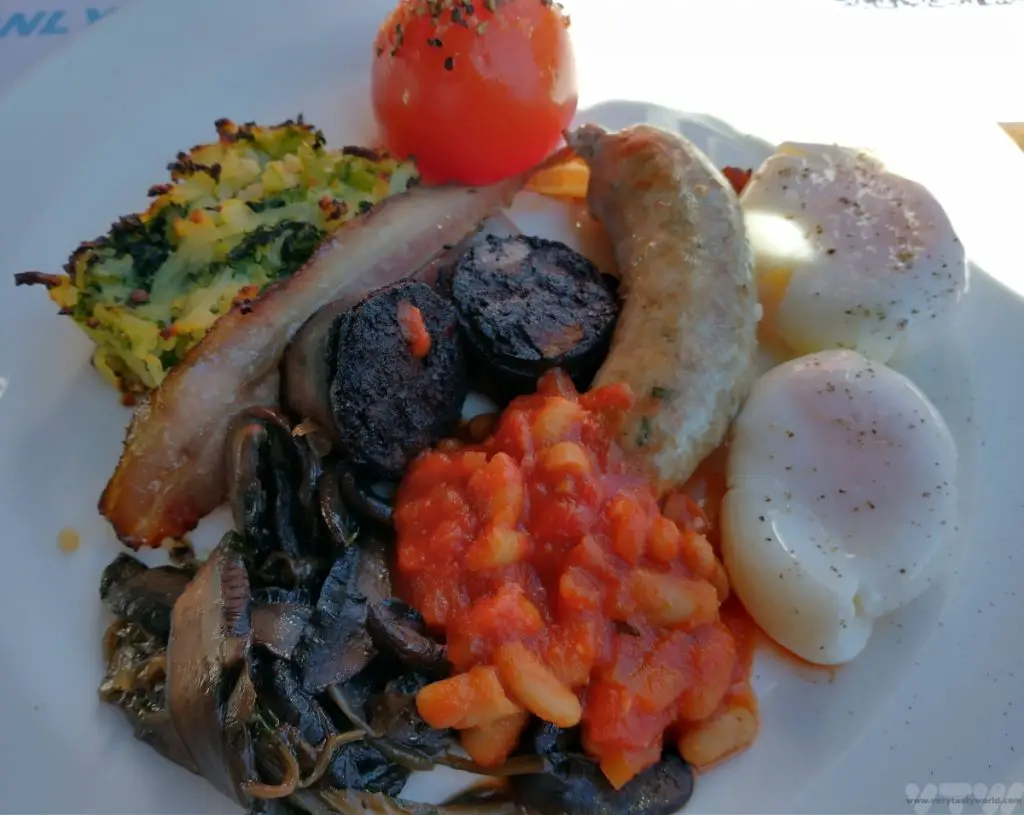
Related Posts You May Enjoy

Japanese Business Hotels – Cheap Accommodation
Developing a Business Plan:
Japan has a reputation for being an expensive country to visit. And while it is possible to spend a lot of money on wonderful accommodation (as it is pretty much anywhere), there are plenty of cheaper options, such as Japanese business hotels.

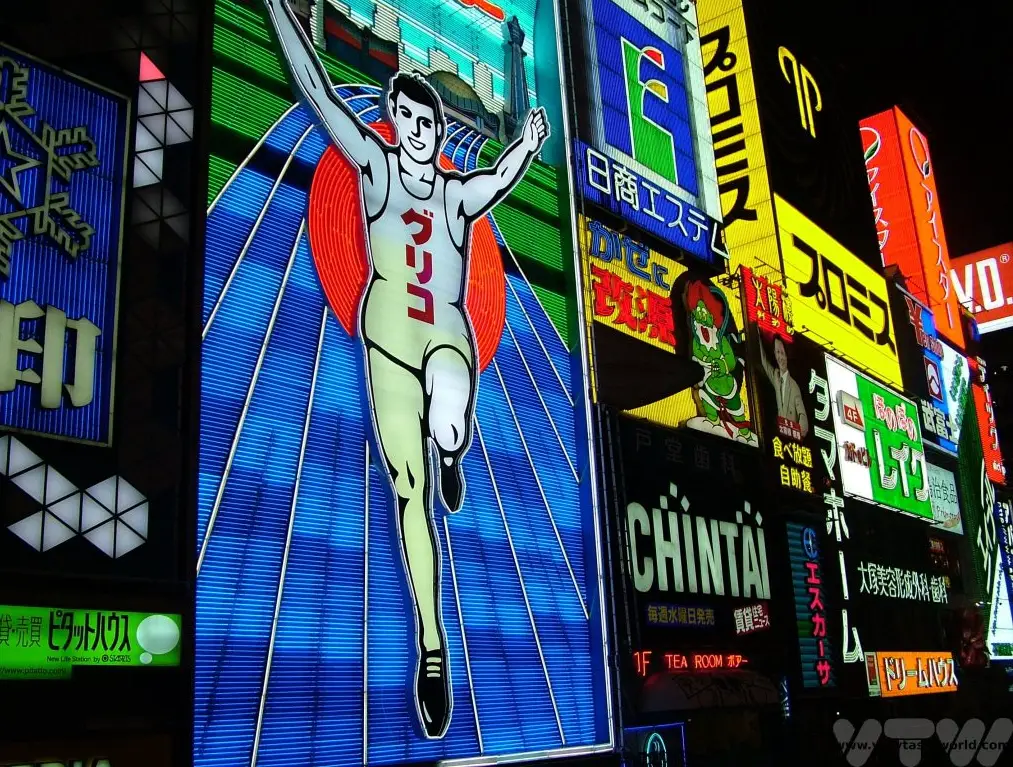
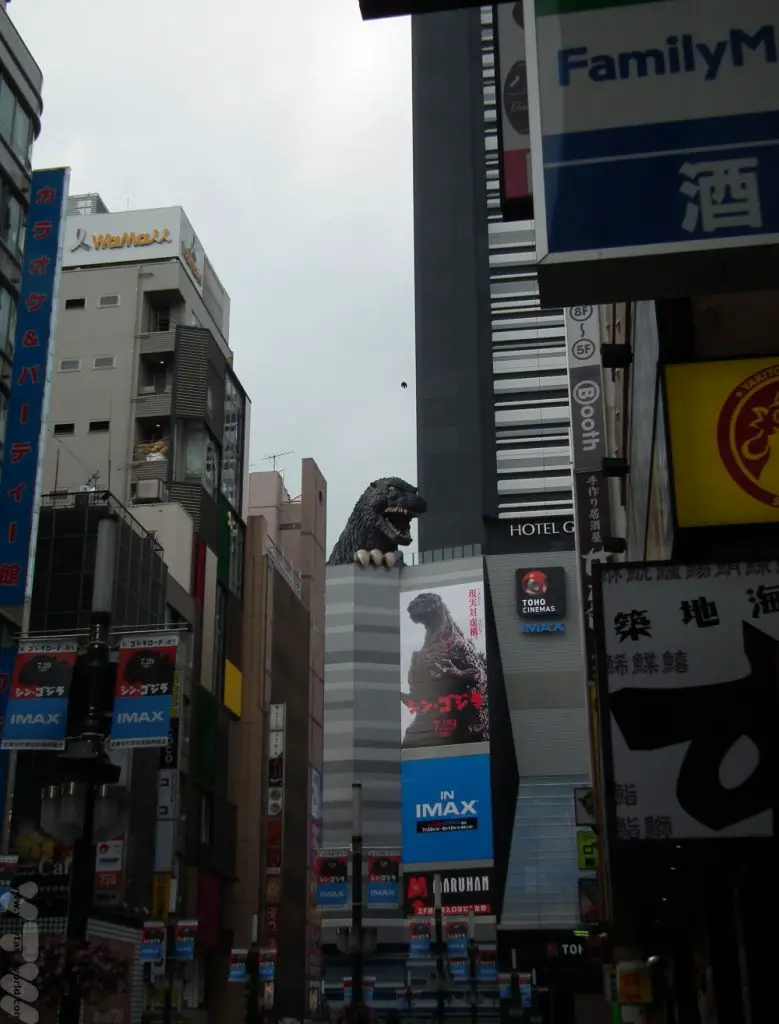
Business hotels are a great way of finding good value accommodation in Japan, especially in cities. Many are located close to railway stations, so you don’t have to drag your luggage too far if you are travelling by public transport (easily the best way to tour around Japan, especially if you have a Japan Rail Pass ). They are primarily designed for salarymen on business trips but are great for tourists too. There are loads of affordable hotels right in the centre of Tokyo; business hotels in other cities can be significantly cheaper.
You can reserve accommodation via the usual hotel booking sites but these days most hotels have an English language website where you can book direct. It’s worth noting that some hotels don’t release dates until quite close to the time of stay (between one and three months) so if you are super-organised and want to ensure you have your accommodation booked early the booking sites still offer a pretty good deal – and a guarantee that you can stay there. Indeed, some may offer free cancellation up to a few days before your stay so you could book up early and change your plans if you need to.
Japanese Business Hotels – What To Expect
Business hotel rooms are small. There’s no escaping that fact. Think of all the estate agent euphemisms about describing tiny spaces: “small but perfectly formed”, “compact and bijou”, “cosy”… We’ve stayed in some rooms where you could barely swing a kitten, let alone a cat.
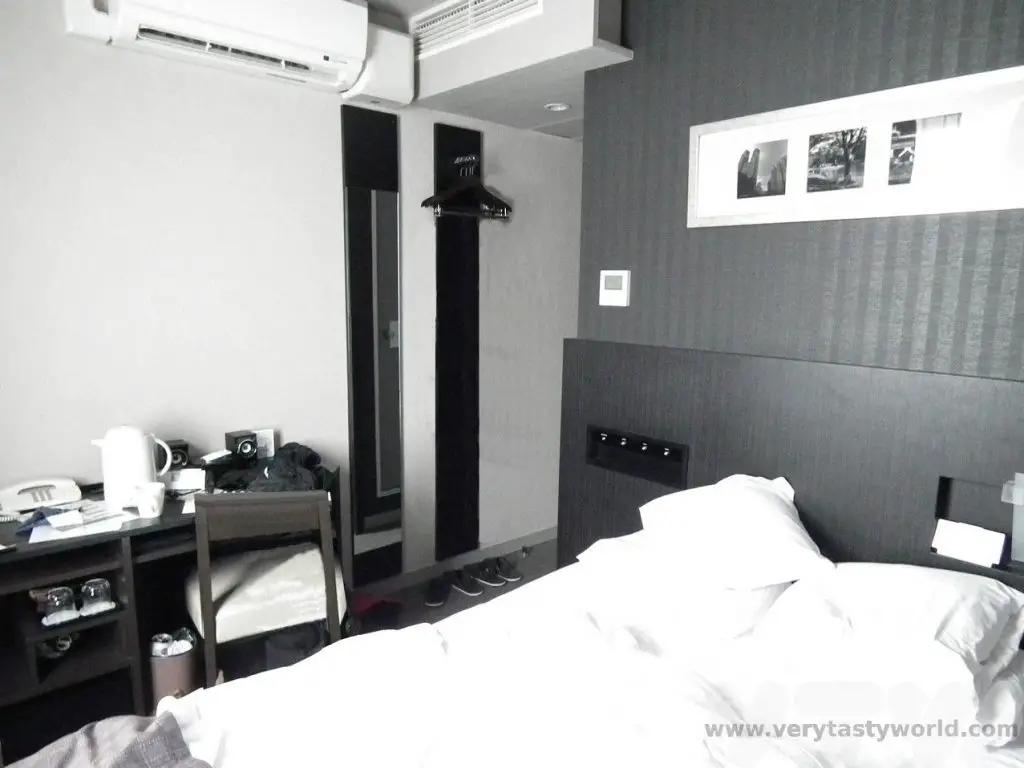
Sometimes the hotels themselves are tiny. You might walk into a compact lobby that has just a front desk and an elevator to the floors above. But, the thing is, you’re in Japan! Why would you want to spend time in your hotel when there are amazing vibrant neon cities or charming towns to explore?
If the room is small then the bathroom is minuscule. It’s a pre-fabricated plastic shell. But everything you need is in there. Bath/shower, basin and… the toilet.
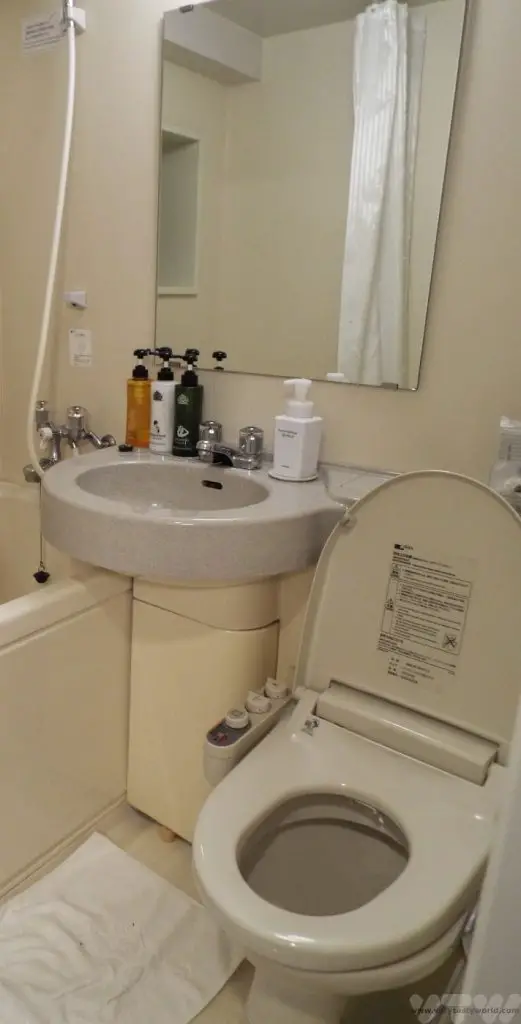
Japanese toilets are an experience in themselves. When you discover that your toilet has a control panel you know that your bathroom experience is going to be… interesting. Don’t worry, it’s fine, you can get away with answering the call of nature then simply pressing a button (look out for the kanji 大 (big) or 小 (small) to get the required level of flush) but if you’re feeling more adventurous bidet options are very common, so be prepared for a jet of warm water if you select the right option. Of course, the instructions may be in Japanese, in which case you might be taking pot luck. This kanji means stop: 止. Some toilets are sophisticated enough to have seat warmers or even make a sound of tinkling water to disguise those undesirable body sounds emitted while using the loo.
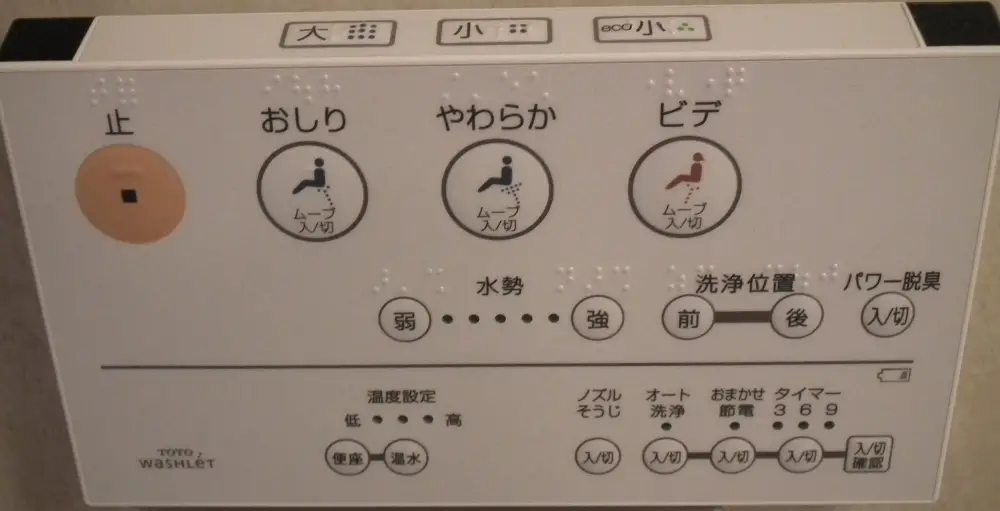
The bathroom will also contain a basket of useful toiletries which are free for your use. These include a toothbrush/toothpaste set, razor and shaving foam, a comb and other little items. So you really don’t have to worry if you forgot to pack your toothbrush!
Indeed Japanese business hotels manage to pack a huge amount of facilities into such a compact space. And they genuinely supply everything you need.
Most rooms will have a fridge. They are small but great for storing a beer or sake (or two) and, also, you might want to pick up a breakfast bento at the local konbini convenience store.
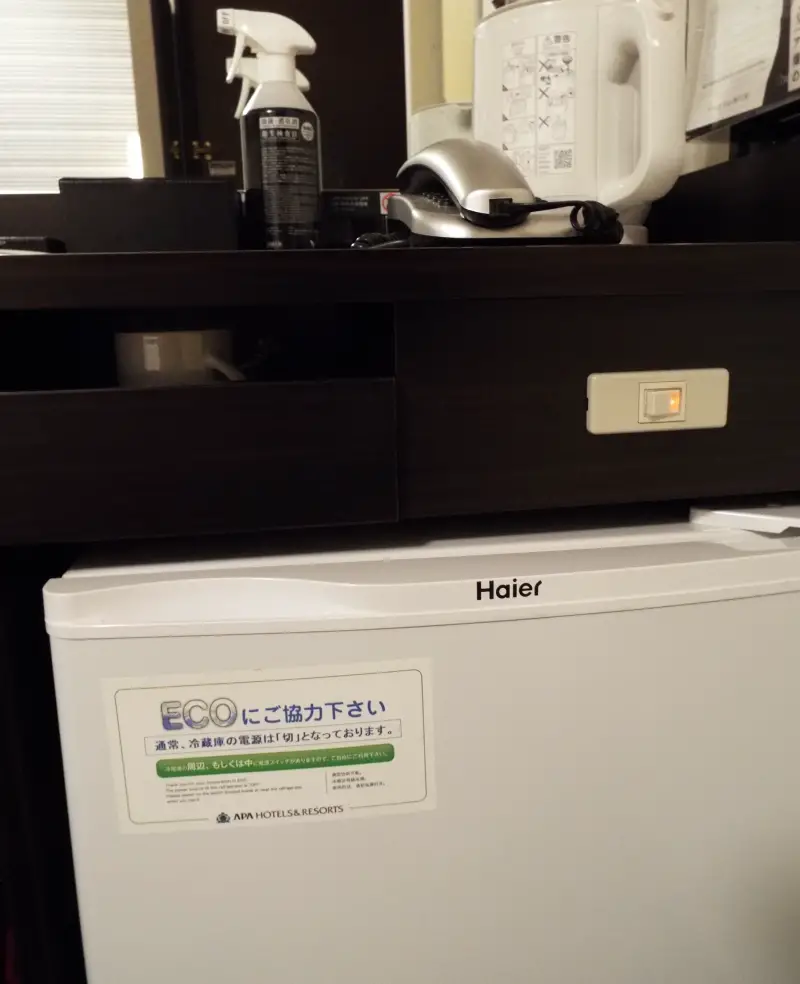
Most business hotels will supply disposable slippers (using outdoor shoes inside is usually a no-no in Japan) and sometimes there will be a yukata (light cotton kimono) for relaxing in.
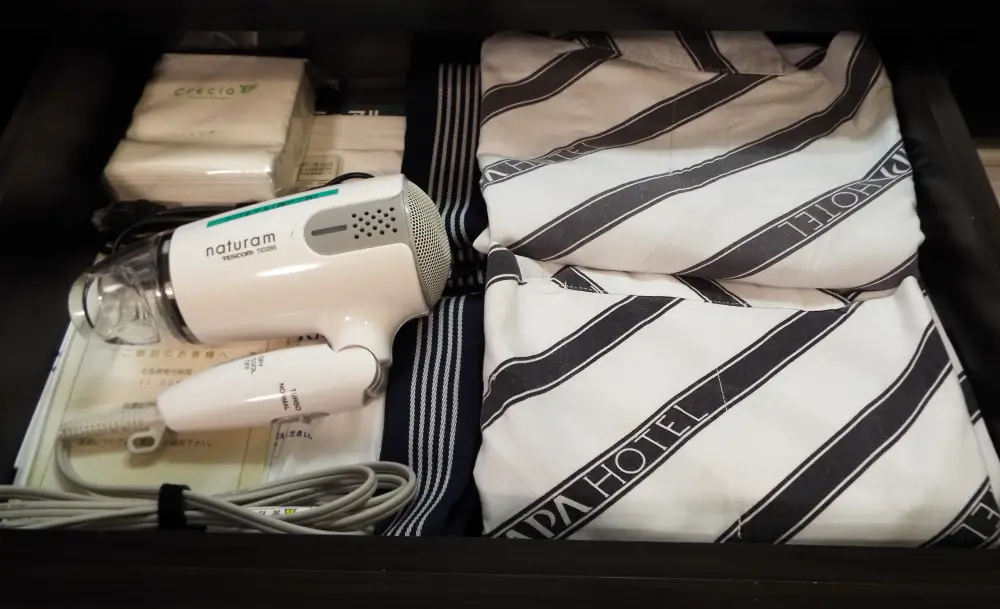
There’s always a TV as well as a kettle and cups along with sachets of tea so that you can enjoy a hot beverage, if you can work out how to use the kettle (fill with water and press the buttons bearing in mind that one will probably dispense very hot water, if indeed you’ve managed to heat it).
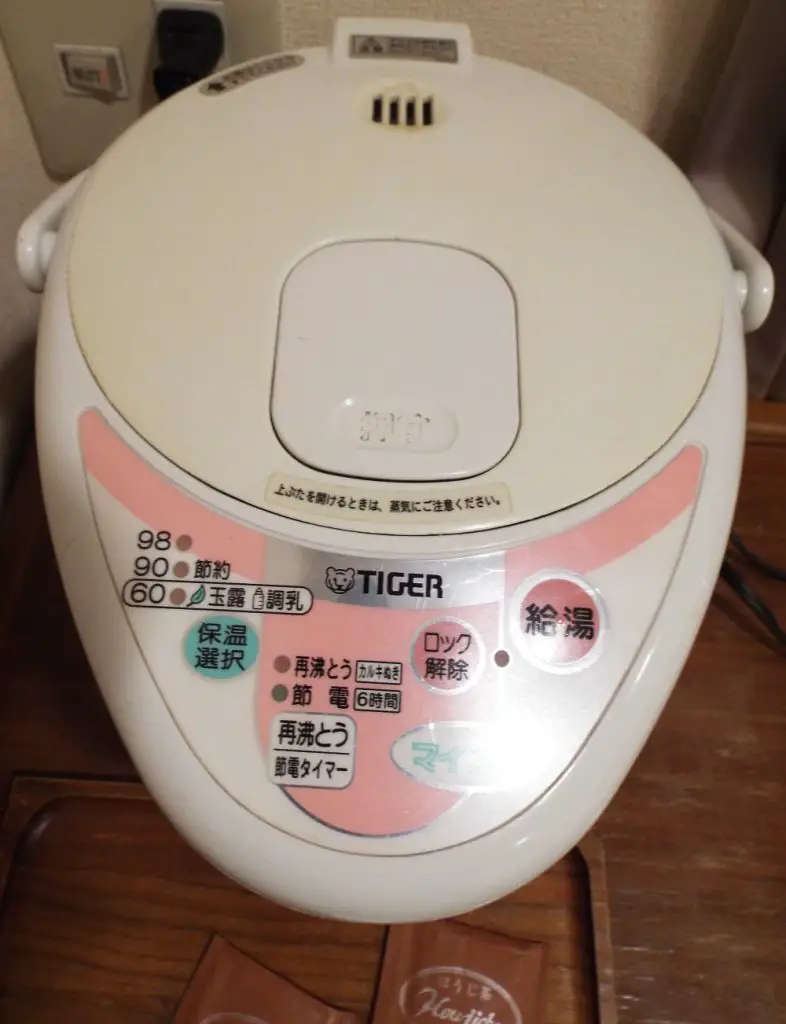
One problem we have found is that it can be tricky to store your luggage. Some beds have enough space to push your luggage underneath and this works particularly well if you have squishable soft bags. Big, hard cases are not ideal, but there is a solution if you don’t need to have all your luggage with you all the time. You can forward luggage to another hotel via Takkyubin (described here) which is an amazingly efficient and great value service. We often found that keeping one ‘big bag’ (we always ensure that we have a mix of our clothes/undies for each of us in both bags rather than packing a separate bag per person – just in case luggage gets lost on the flight out) and forwarding the other onto another hotel means that you only need to worry about storing one bag in the room.
It’s not common for Japanese business hotels to offer a substantial breakfast and many won’t offer food at all. Some may have a small café area where you can pick up a tea or coffee, others may offer a basic breakfast – such as rice balls (onigiri) and a cup of green tea. There will almost certainly be vending machines so that you can purchase food (snacks or cup noodles) and drinks (soft drinks, canned coffee or beer). And you usually won’t be far from a convenience store (konbini) where you can buy pretty much anything you might need! We often pick up a bento (boxed meal) for breakfast – at a few hundred yen they are cheap and filling and can be stored in the room’s fridge. There’s usually a great variety to choose from.
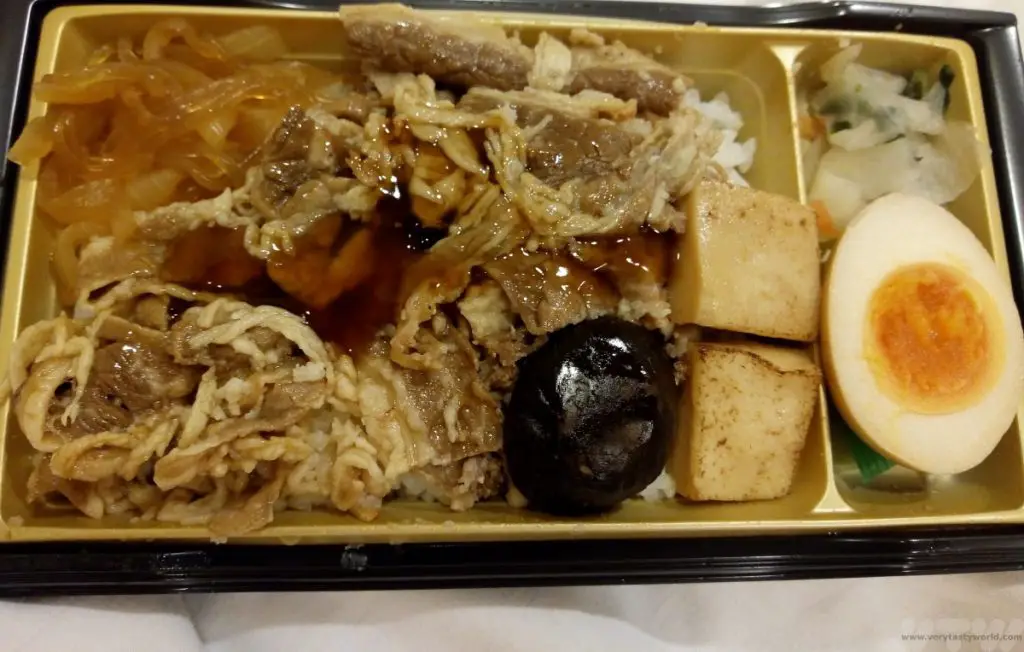
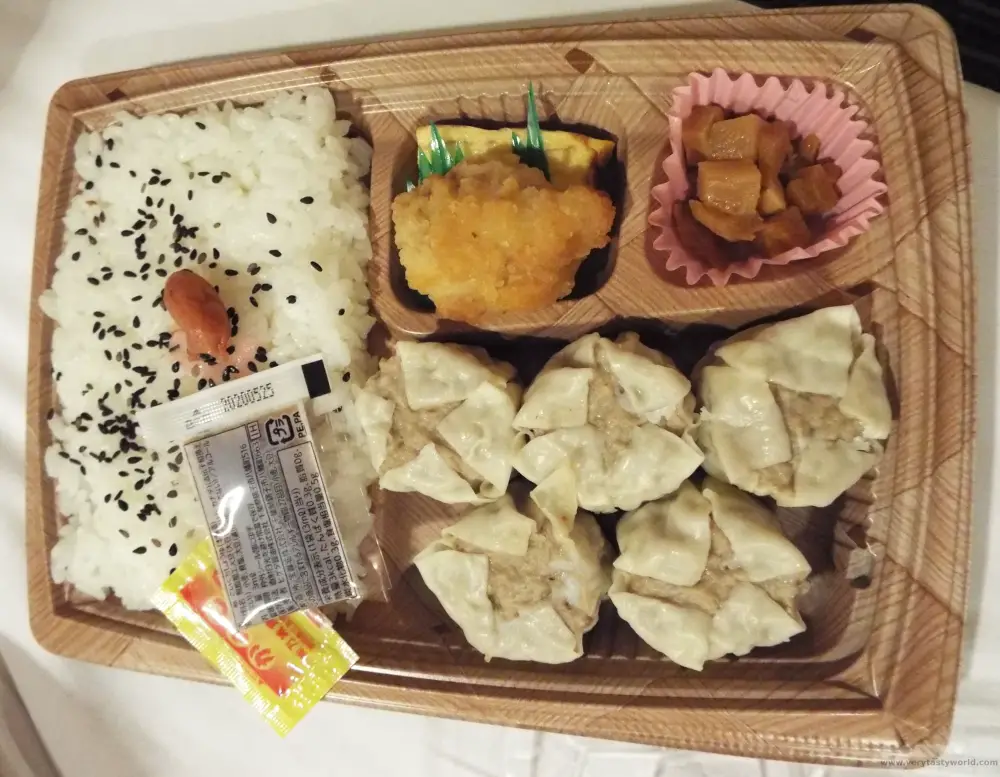
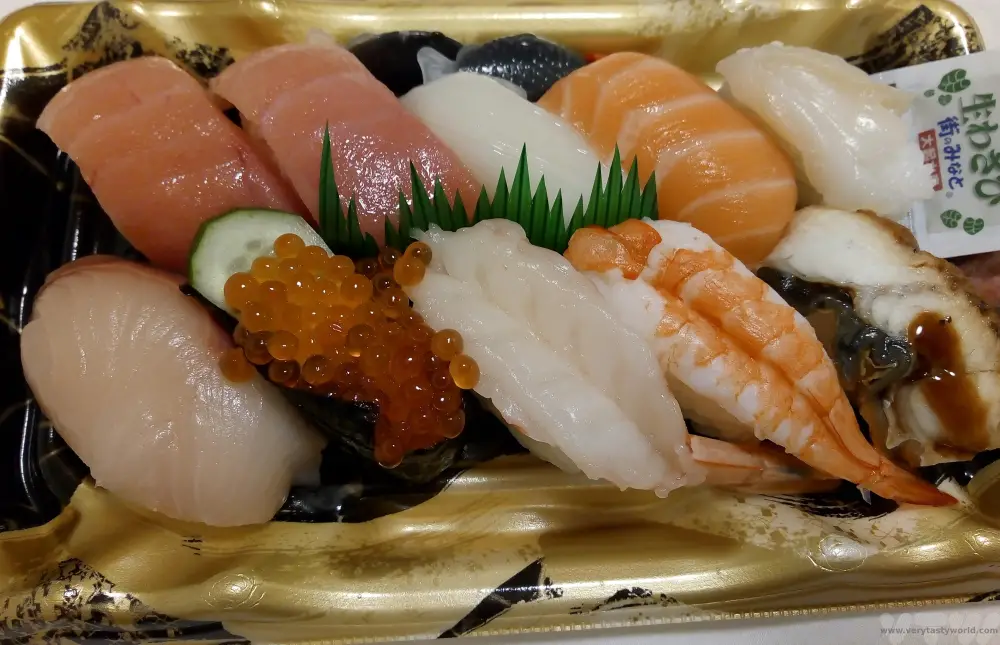
Japanese business hotels are undoubtedly great value but it is also nice to experience other types of accommodation. Ryokan are traditional inns which often offer a suite of rooms with a tatami (reed) mat floor, futon and amazing breakfasts and dinners – it’s a real experience although, of course, they are usually more expensive.
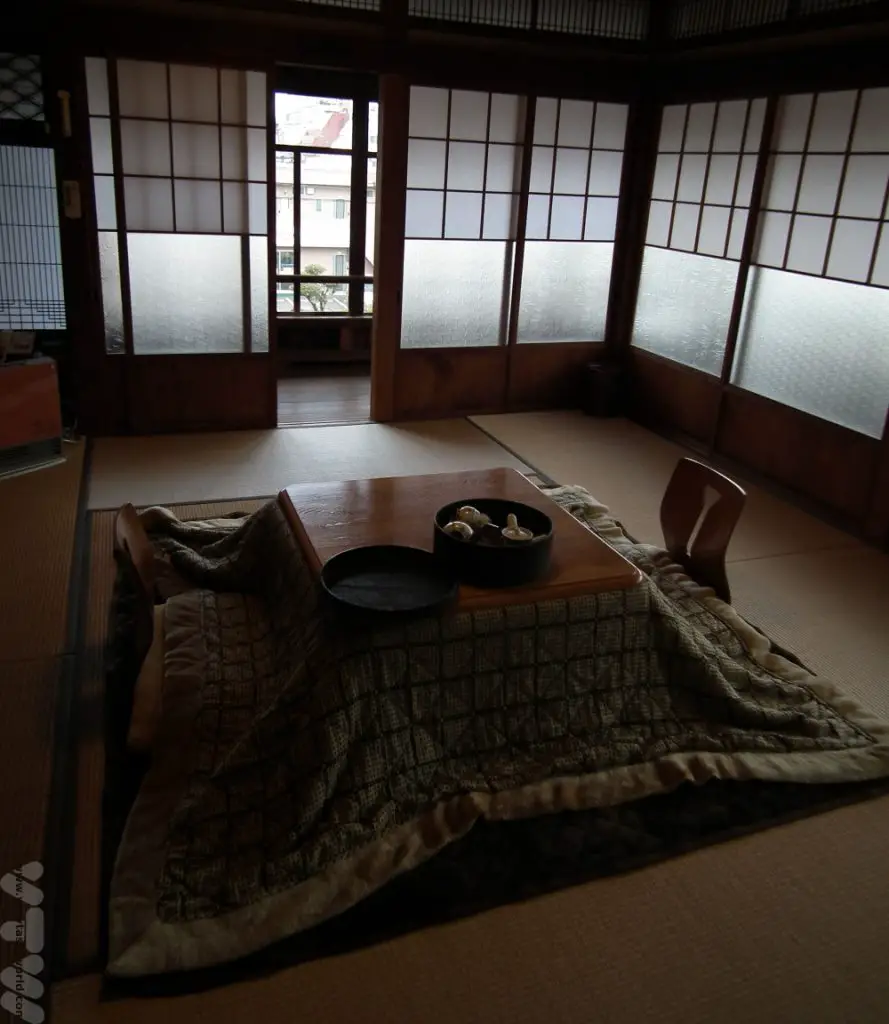
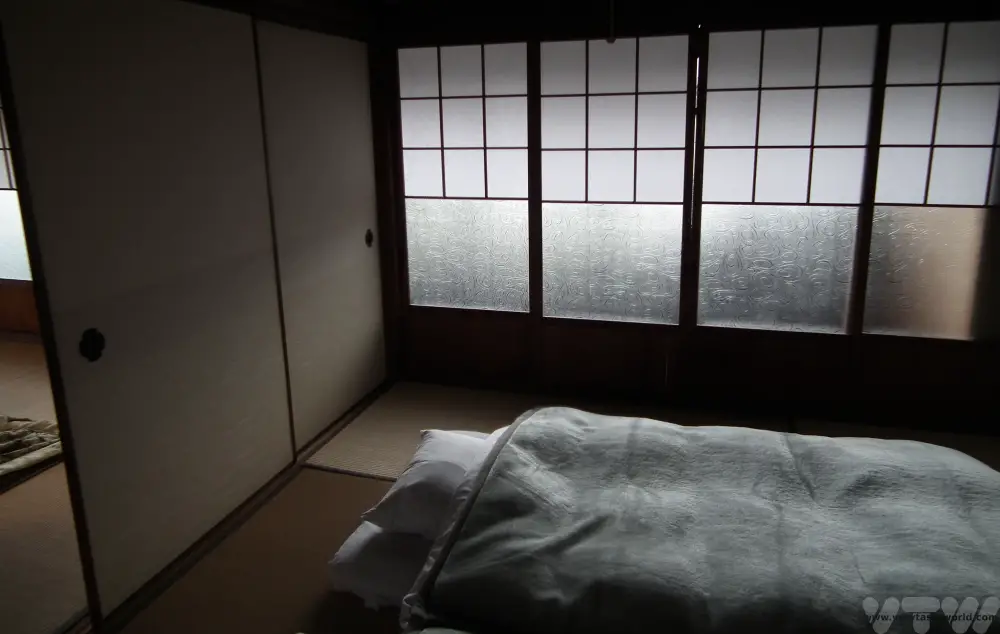
Minshuku are Japanese B&Bs – usually family run, they also offer Japanese style accommodation. They are fun, friendly and often cheaper than ryokan. It is also possible to visit family homes in some areas. AirBnB has been increasingly popular as a choice of accommodation in Japan too. There are also cheap dorm rooms for backpackers and the famous capsule hotels, whereby you can sleep inside a tube for the night, all mod-cons provided, albeit within an incredibly compact space. It’s worth noting that the budget accommodation options are often sex-segregated. When we travel around Japan we tend to choose business hotels for the majority of our stays, in order to keep the budget low, and then treat ourselves to a few nights’ splurge at a ryokan.
Related Posts You May Enjoy

- Recipe: Simmered Shiitake Mushrooms
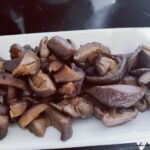
- How to Use Public Transport in Japan

- RECIPE Oyakodon Donburi

- Planning a Trip to Japan
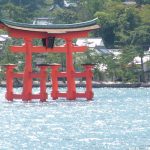
- The Makanai: Cooking for the Maiko House
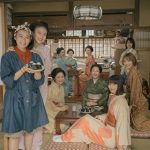
- Setsubun Food – Bean Throwing Day
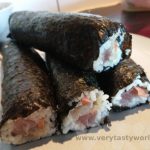
- The Gassho Farmhouses of Rural Japan
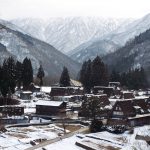
- Recipe: Japanese Simmered Pork Belly – Buta no Kakuni

- RECIPE: How to Make Umeboshi

How To Make Miso Paste
One of the great things about travelling around Japan is getting to sample the regional variations in the food. We had visited a miso/soy sauce factory in the western city of Kanazawa but, on our way, we had taken a detour to visit the snow monkeys at Yudanaka and also had the opportunity to visit the nearby town of Obuse in Nagano prefecture. And we also wanted to learn how to make miso paste.
Obuse is a pretty little town with some interesting museums – notably an exhibition space dedicated to artist and printmaker Hokusai who was famous for his ukiyo-e (floating world) pictures from the Edo period. His best known work is probably The Great Wave off Kanakawa, one of the 36 views of Mount Fuji series. When we visited, they had on an exhibition which contrasted the Thirty-six Views of Mount Fuji with the One Hundred Views of Mount Fuji series.
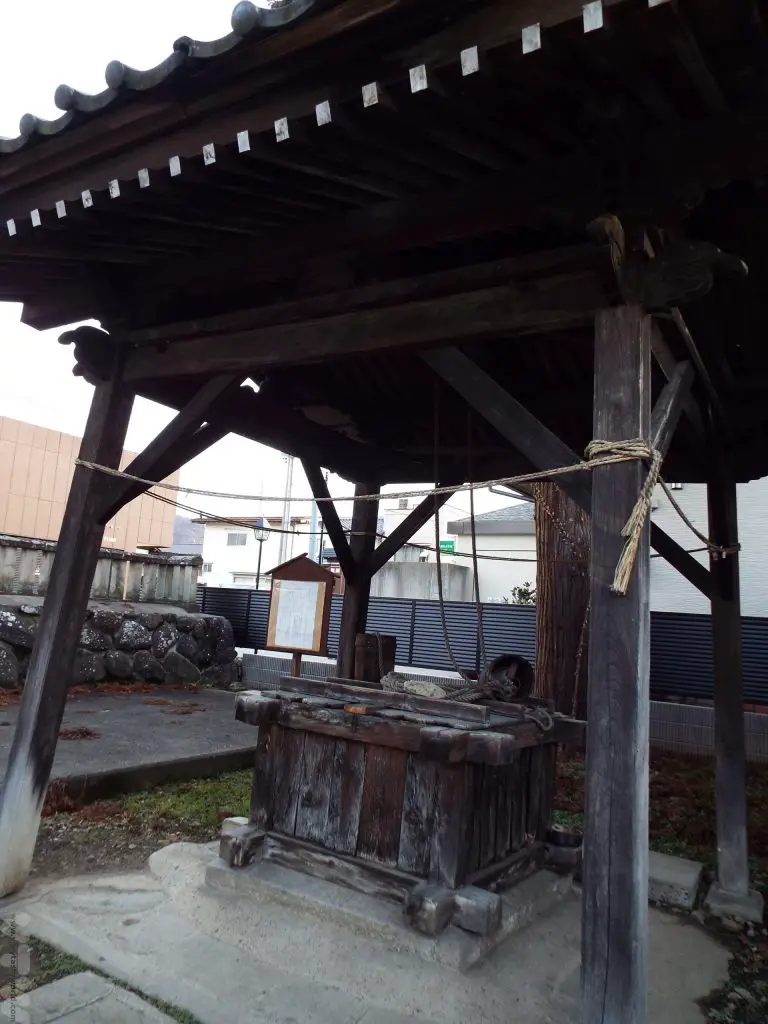
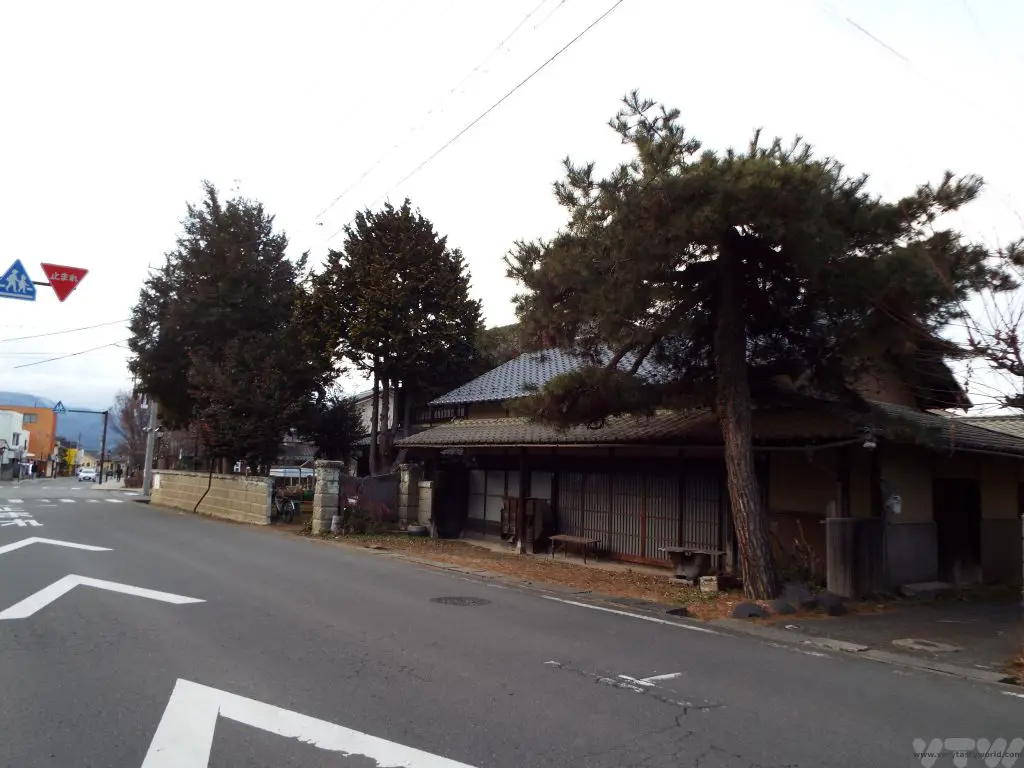
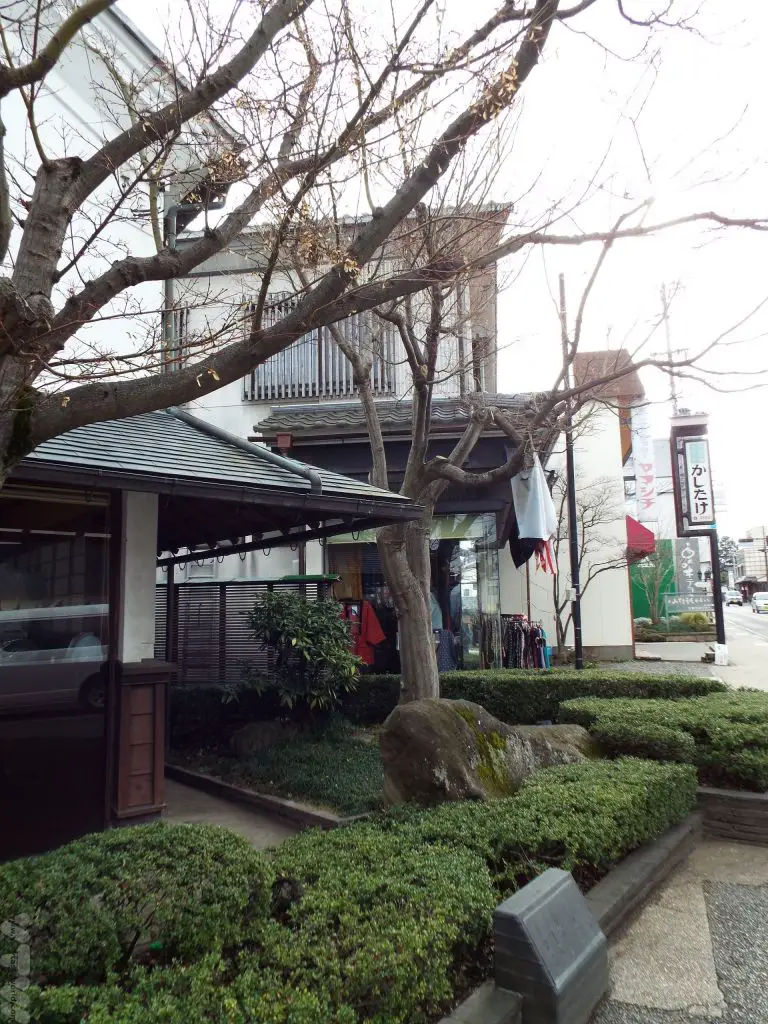
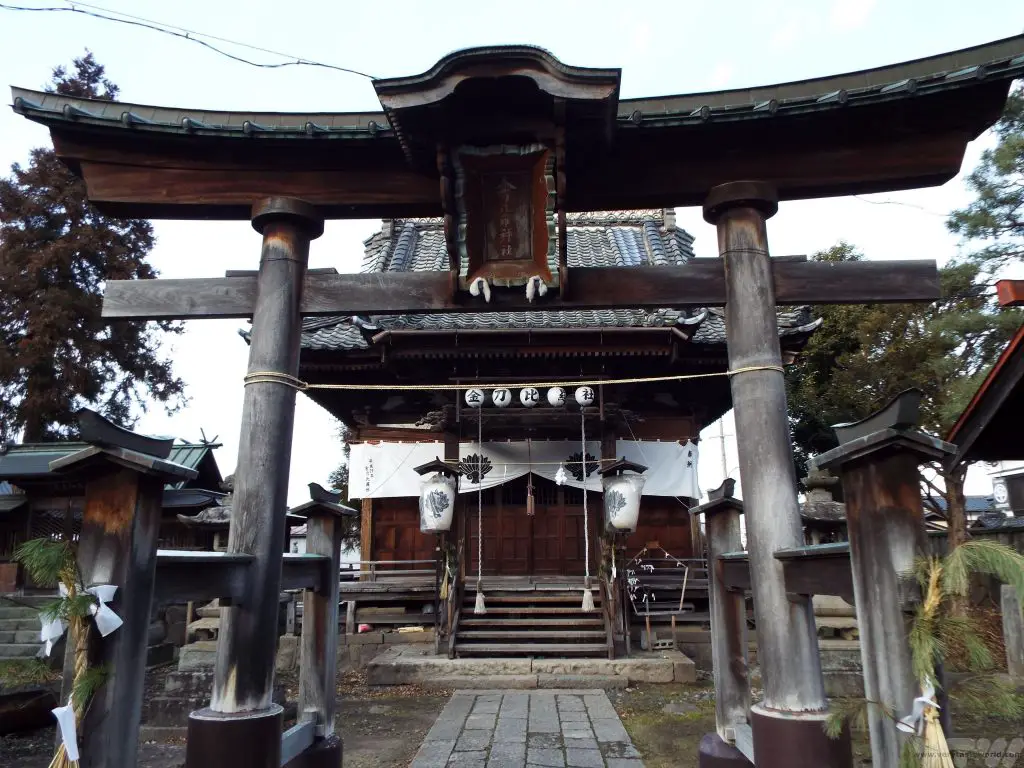
We were pleased to discover that the town also had a shop dedicated to miso.
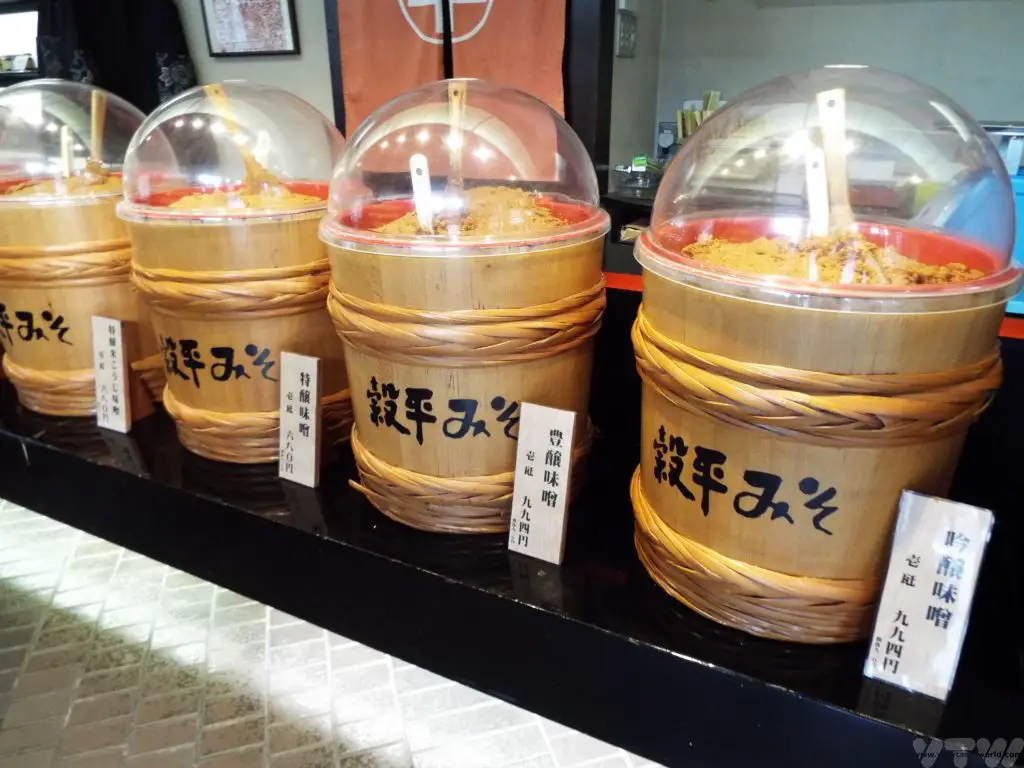
The delightful owners were very happy for us to sample their wares and it was great to be able to compare flavours of the different types on offer. We bought some packets of miso to take home with us.
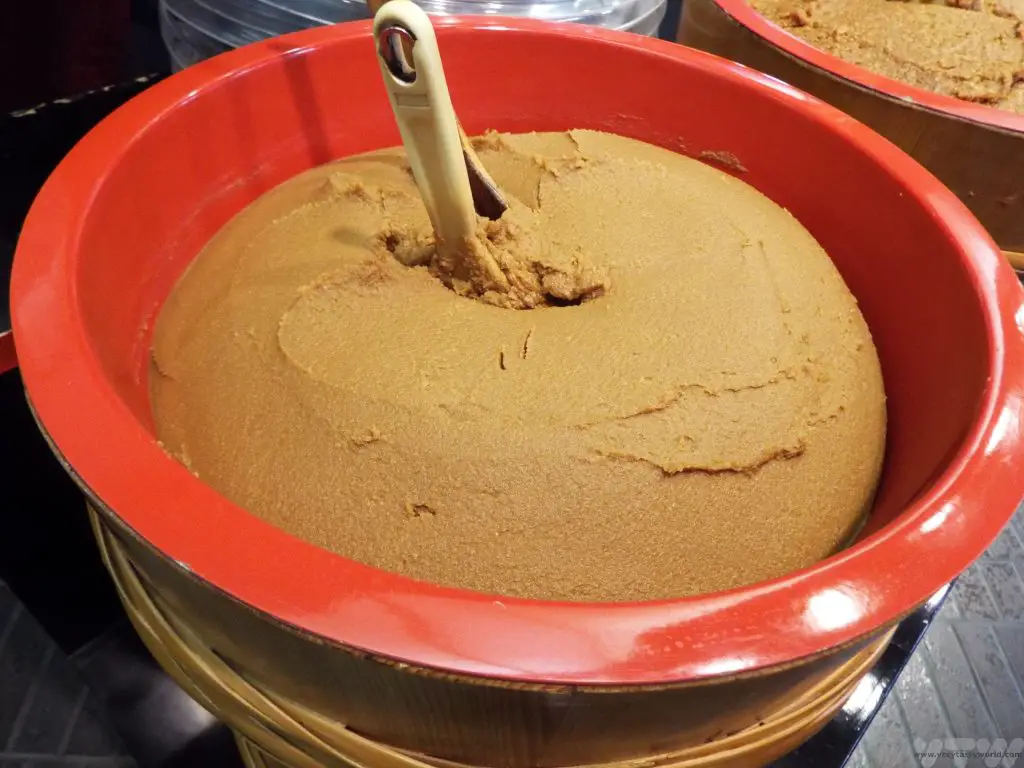
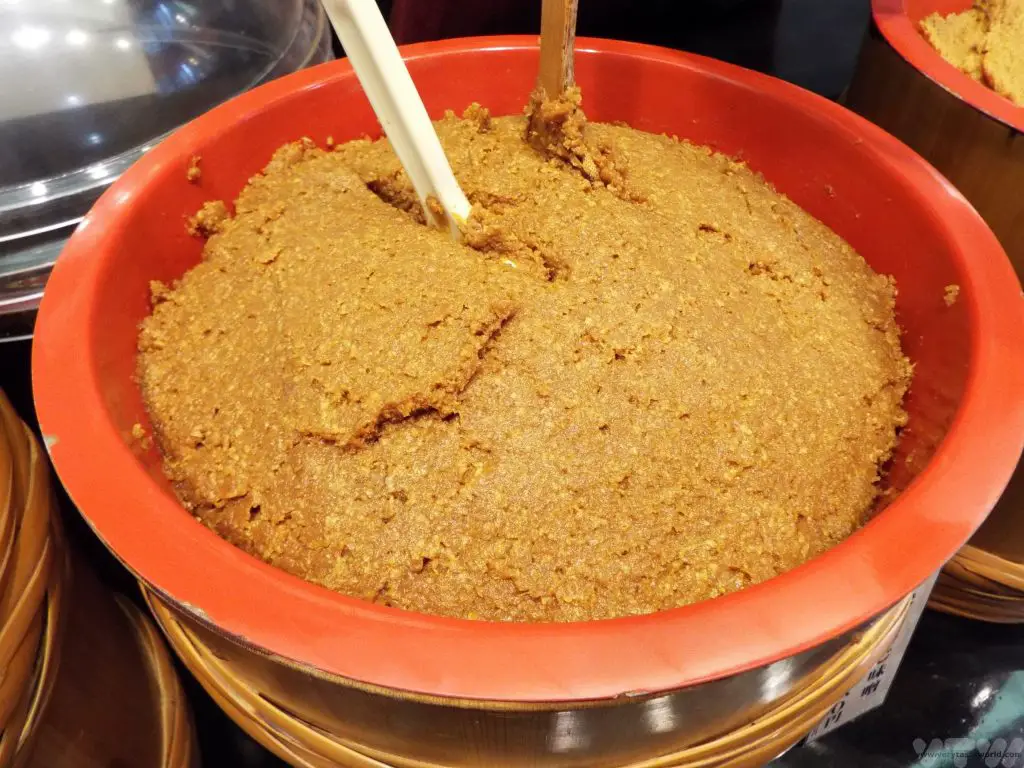
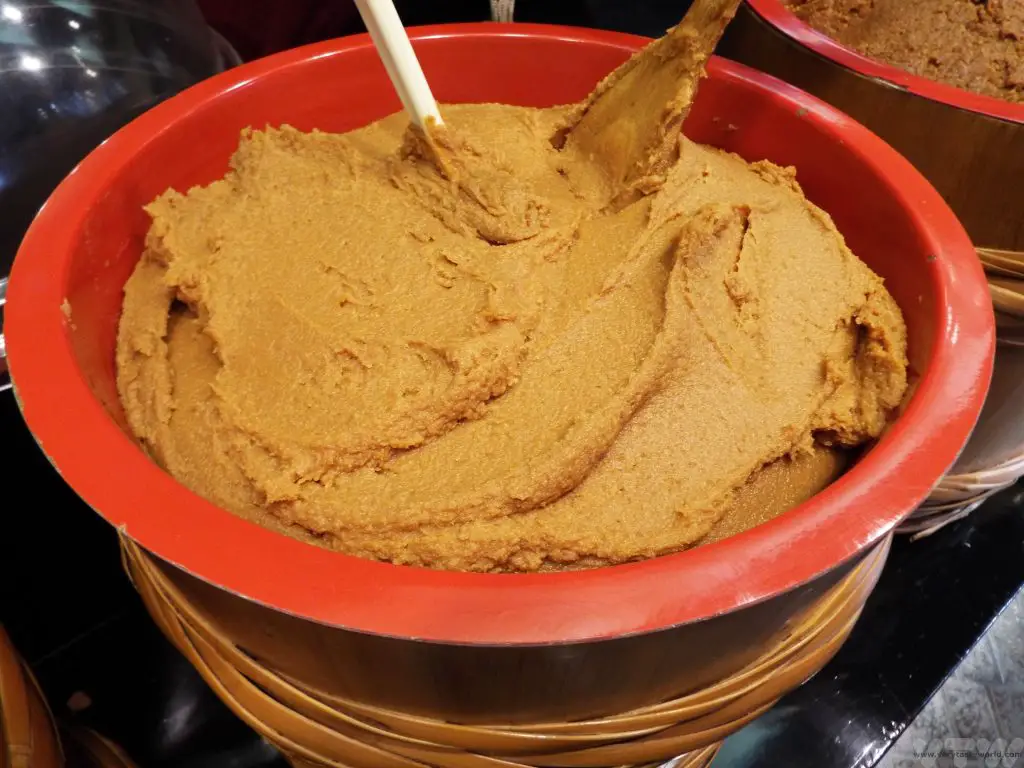
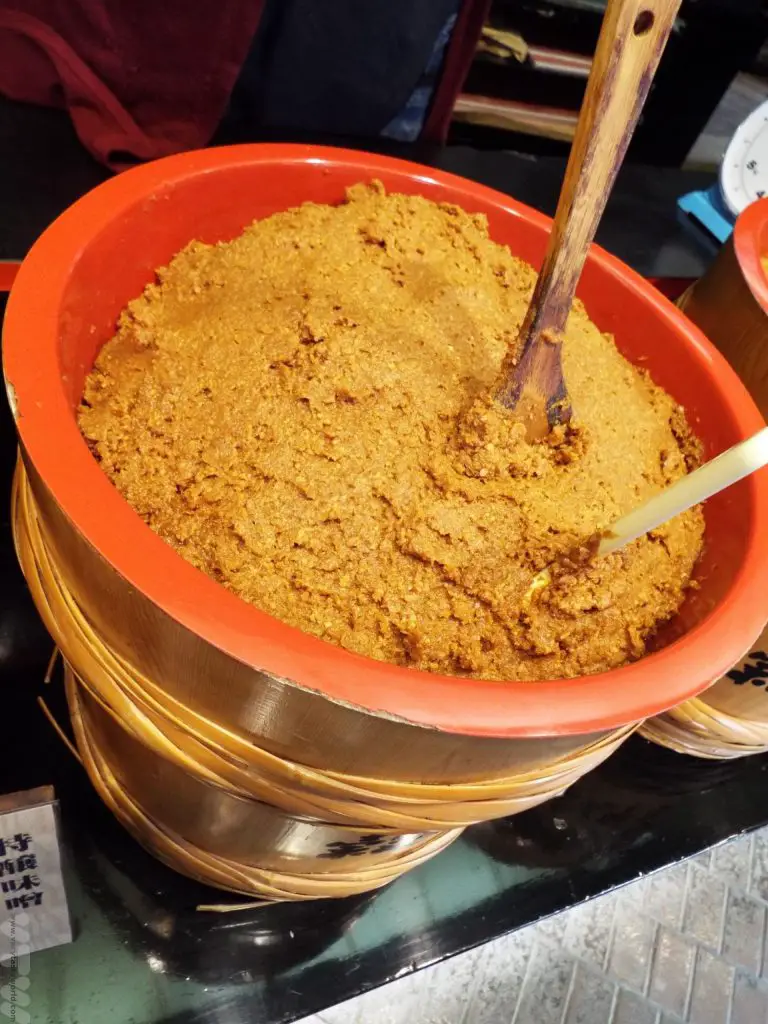
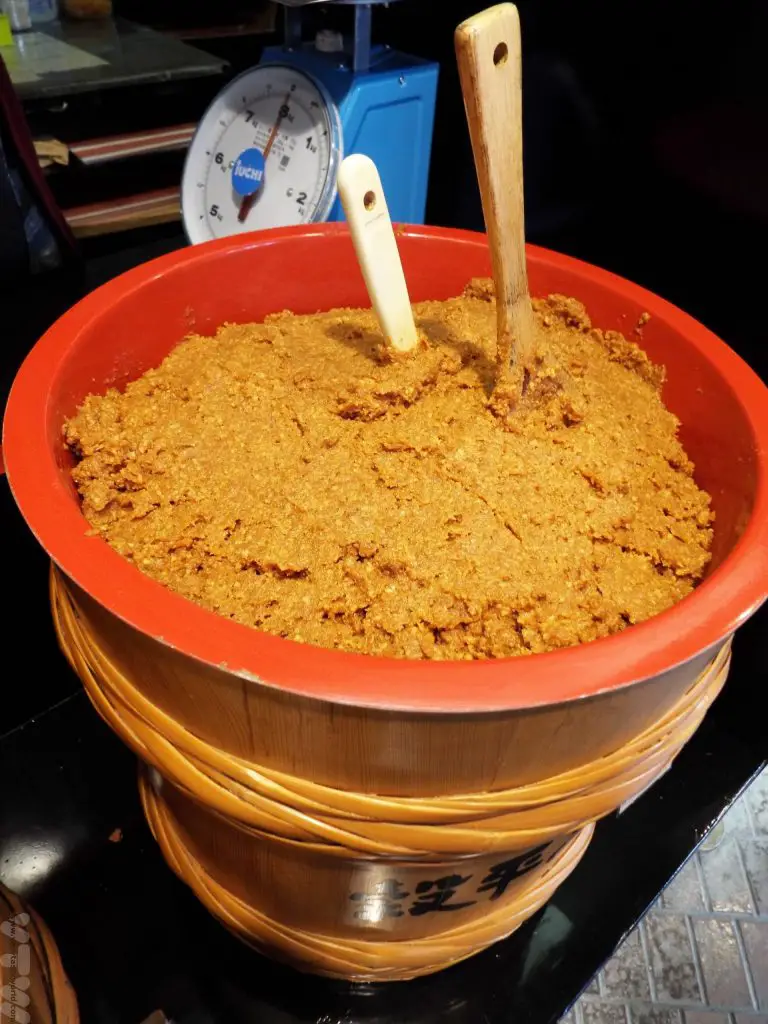
How To Make Miso Paste
We had long wanted to experiment with making miso but, while it’s easy to get hold of soy beans, obtaining rice koji is more difficult in the UK. We were able to buy some inoculated koji in Japan and have later discovered a number of suppliers in the UK and EU from whom koji can be obtained. We used pre-inoculated koji. If you are really hardcore, you can obtain the spores, then steam the rice and let the mould grow on it to create your own koji.
That is for another time though. We started with the simple approach using koji that we had bought in Kanazawa…
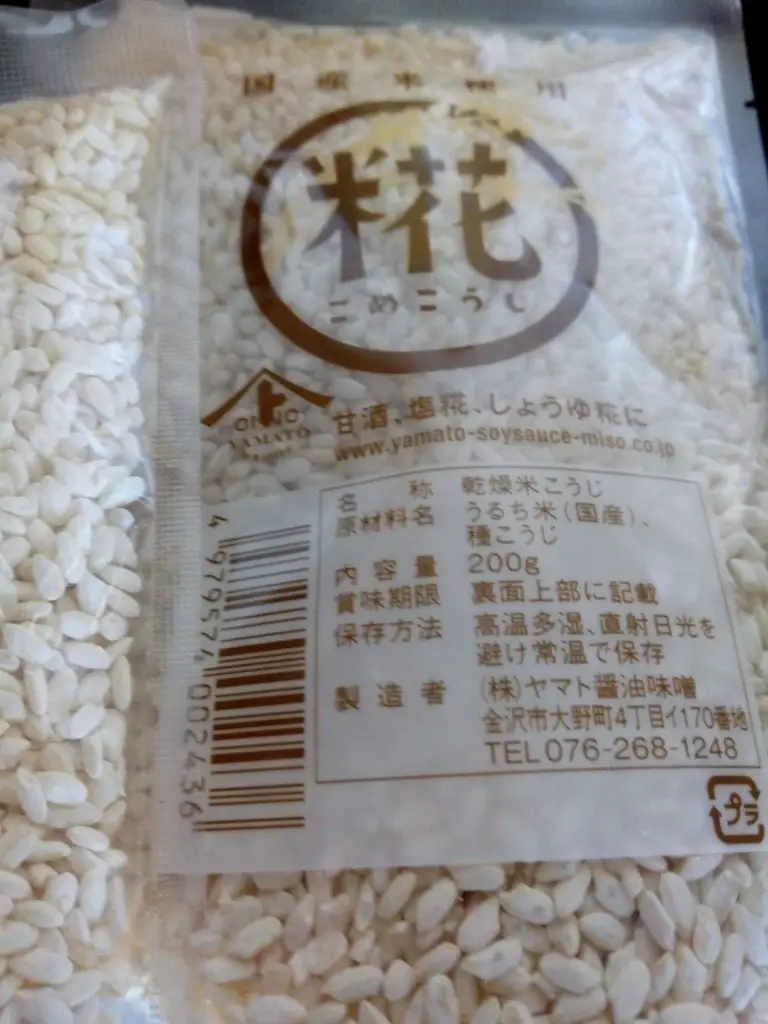
The best book in the world for learning how to make Japanese preserves, pickles and ferments is Nancy Singleton Hachisu’s Preserving the Japanese Way: Traditions of Salting, Fermenting, and Pickling for the Modern Kitchen. We have tried and tested loads of recipes from this book and can wholeheartedly recommend it. We followed the miso recipe.
Organic soy beans were soaked overnight and then boiled for a couple of hours until soft.
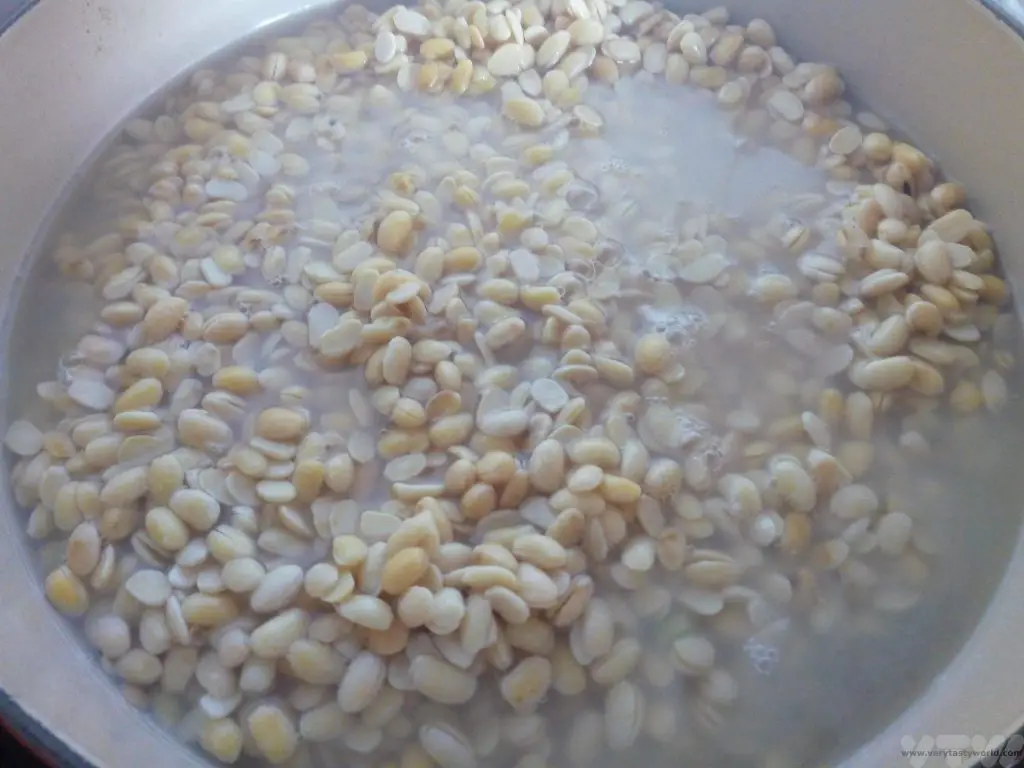
One thing we realised that we needed to obtain – a bit too late at this stage – was a proper blender. The soy beans were mashed by any means necessary – in the end a combination of a potato masher and hand blender produced the best results from all the available gadgets in the kitchen but the beans were still a bit chunky – we didn’t achieve a really smooth paste. But that was okay, miso doesn’t have to be totally smooth. In fact, chunky miso has a very pleasant nutty texture. But a blender was duly ordered for future use.
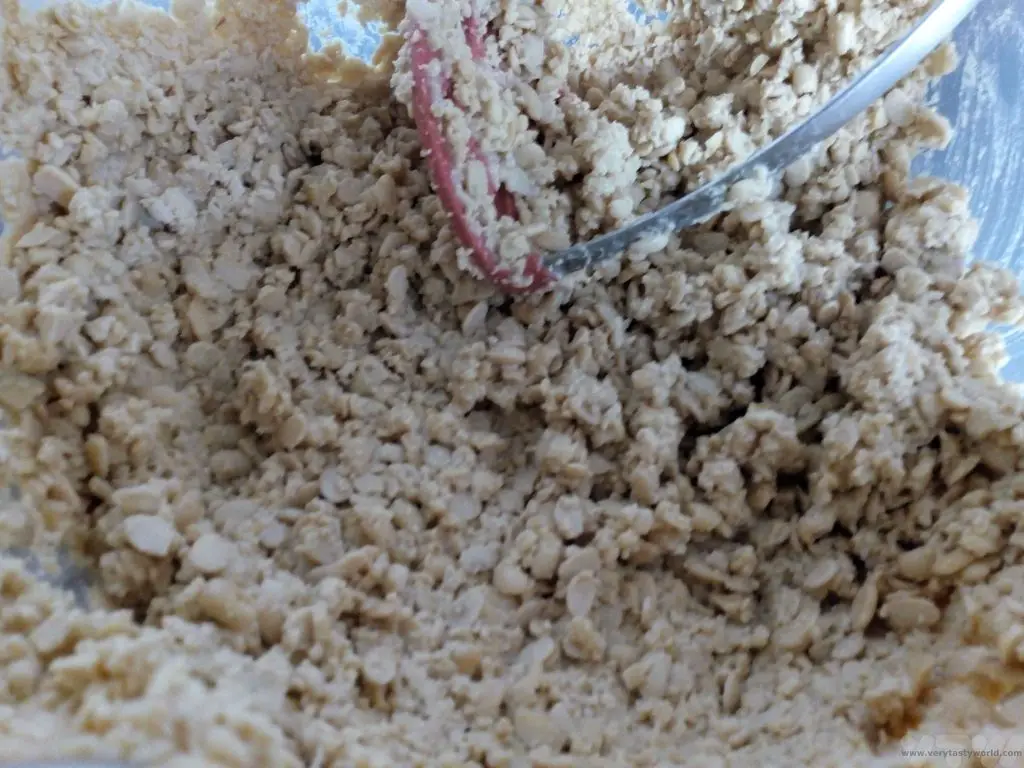
After the beans had cooled we mixed in the rice koji and salt – giving everything a really good squash together. It’s a very hands-on approach. (Make sure hands are clean, of course, a good way to do this is to spray them with white vinegar.)
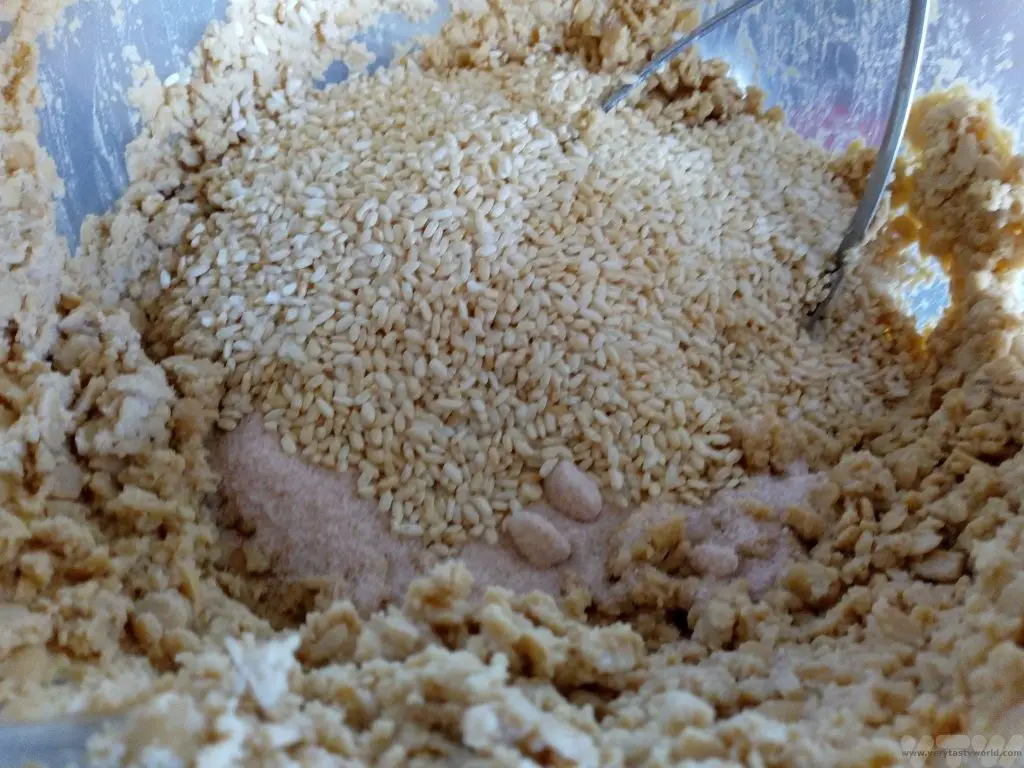
Then you get a big container, in this instance we found some food-grade plastic tubs, which we cleaned thoroughly and wiped with (cheap) vodka, grab a ball of mixture and throw it into the container. You need to have a good aim. The point of the throwing is that the mix splats together and doesn’t allow air bubbles. It’s really important that the mix is compact. If your splatting ability isn’t as accurate as it could be, make sure you really pack the miso together afterwards – a good squish with your fists will help.
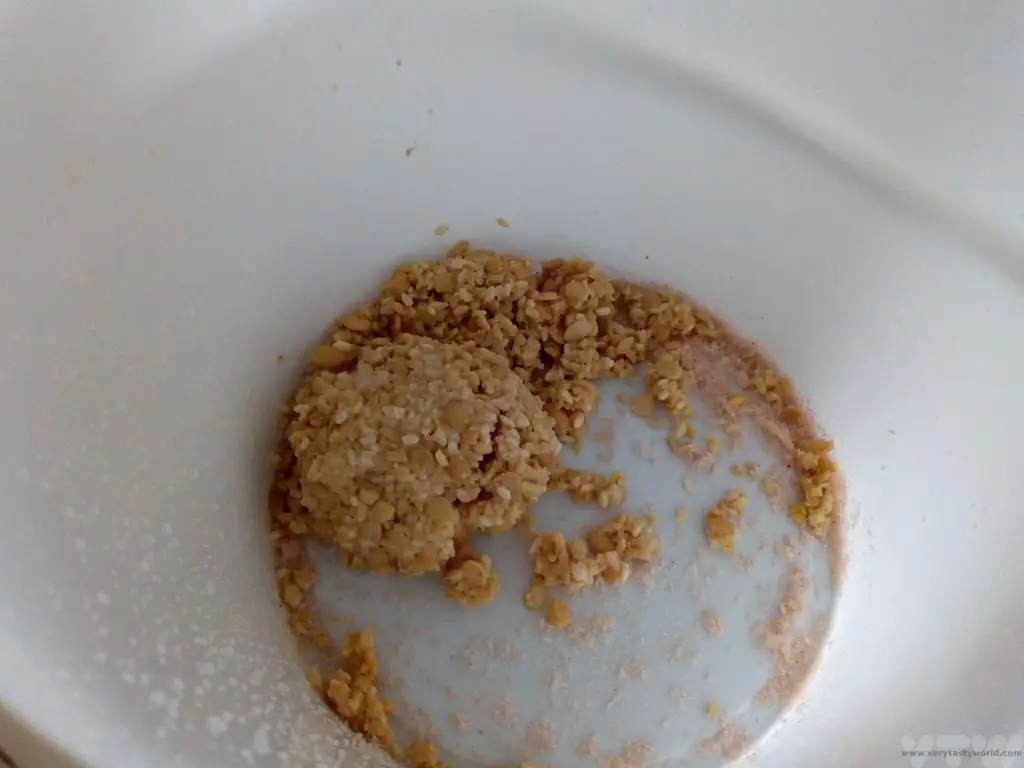
When the mixture is thoroughly squashed and compacted, sprinkle salt over the surface of the mixture, find some heavy weights and crush the miso to push it all together.
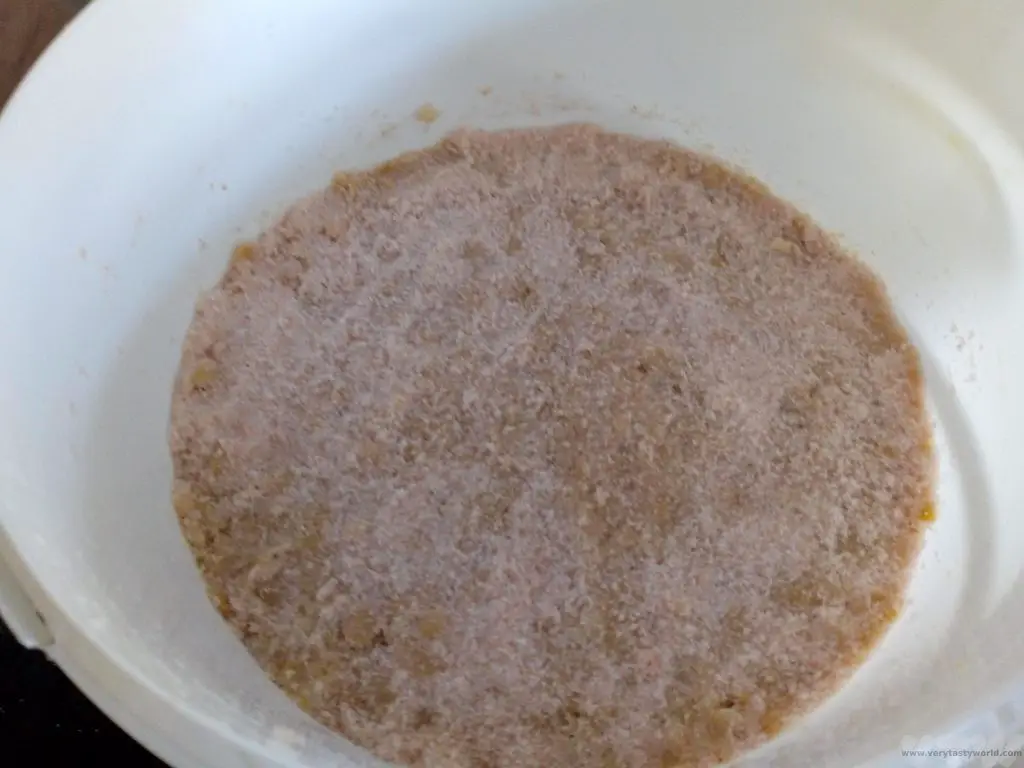
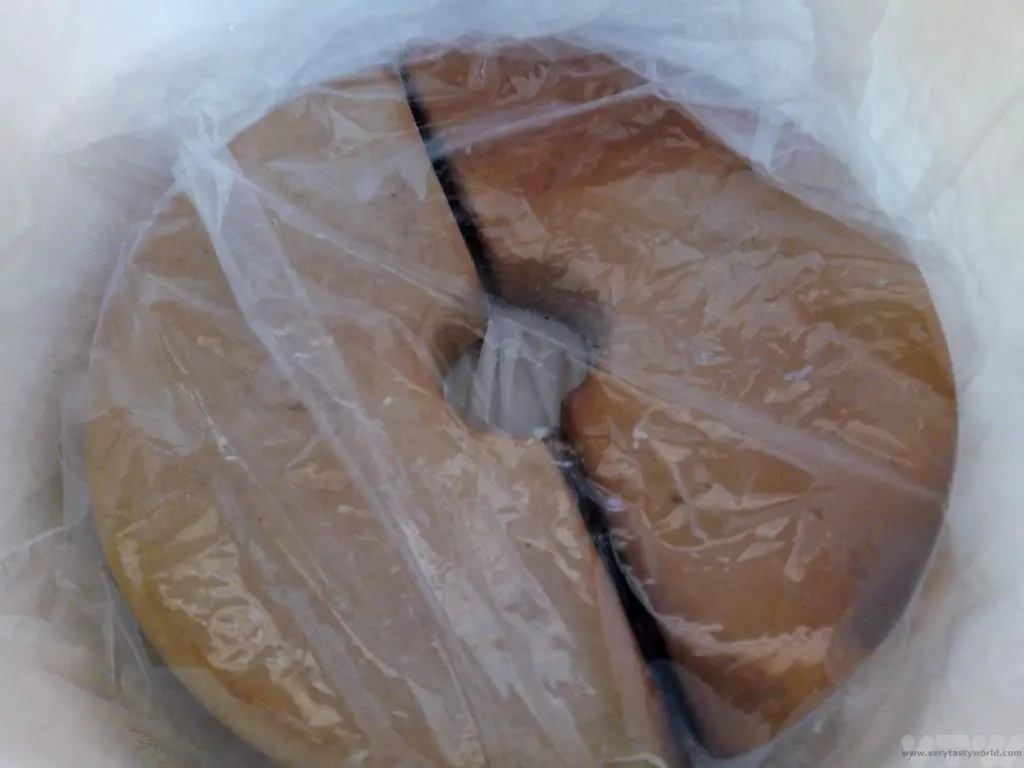
Then it’s simply a matter of time. Miso production in Japan is usually started in spring when temperatures are low. We started in April. The hot, humid summer is essential for the maturation of the miso and this is quite difficult to replicate in the UK, which has summers that can best be described as variable. However, we are lucky enough to have a greenhouse in our garden so our miso spent several days at a temperature that tried to emulate Japan’s summer heat although it didn’t get close to its oppressive humidity. It worked though – after the summer, on opening the lid we could definitely get that distinctive miso aroma. We knew we were on the right track.
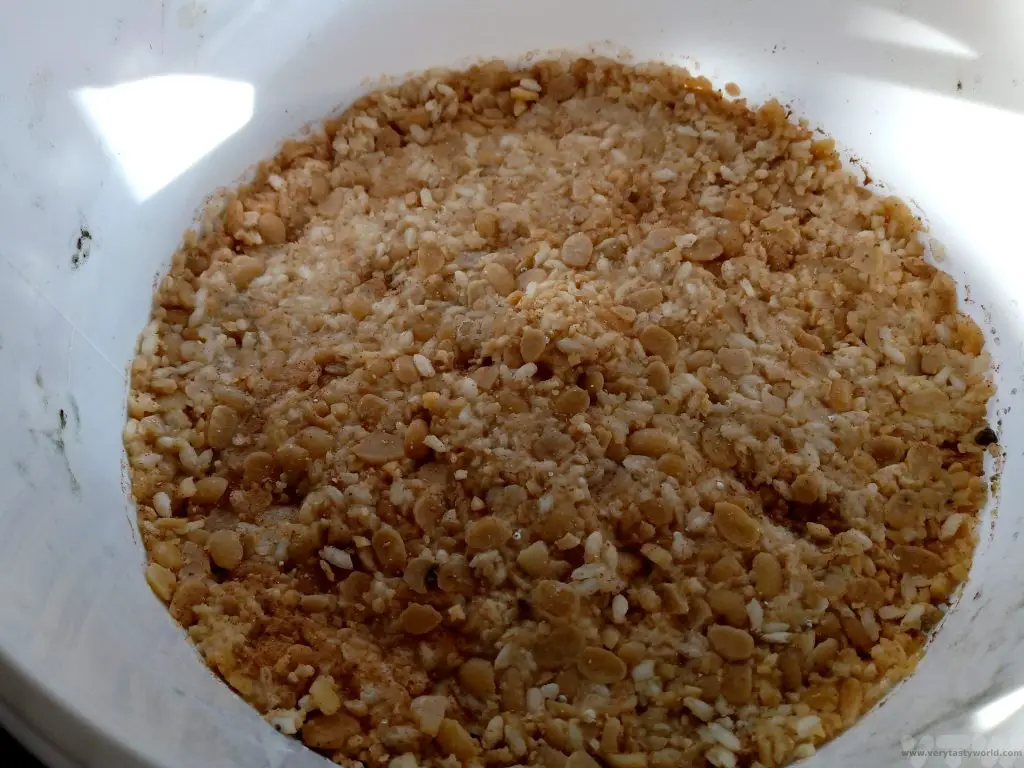
We waited a few more months – until late October – and finally plucked up the courage to scrape the scary-looking surface of the miso and dive in.
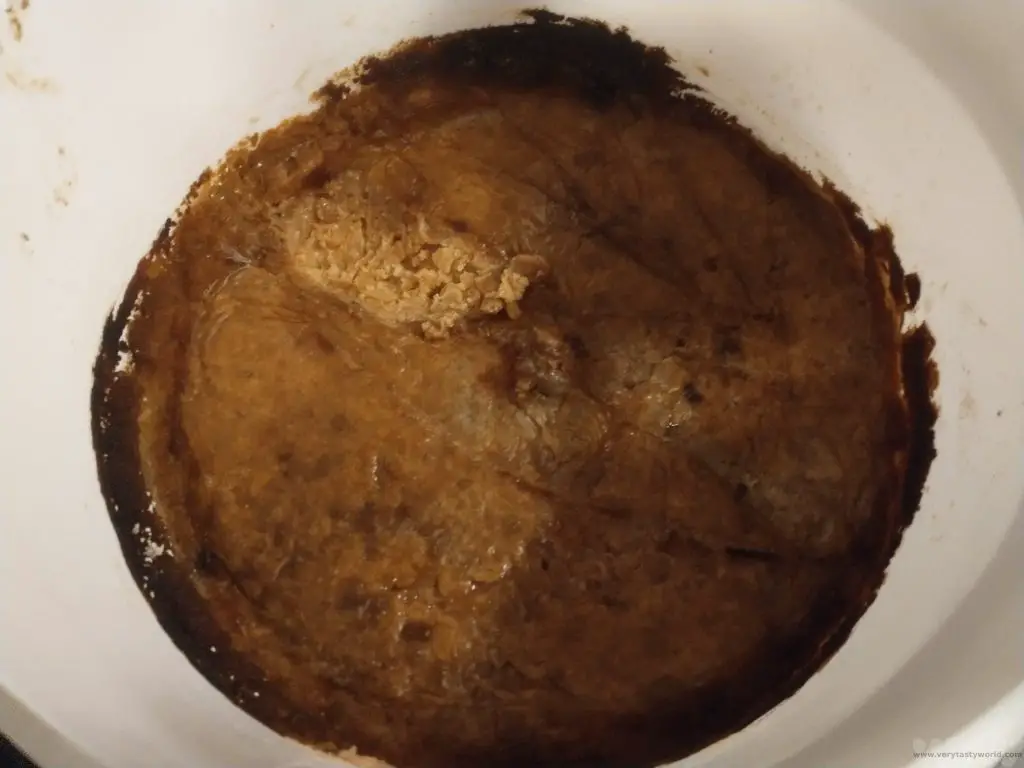
An initial taste revealed it to be really delicious – salty and savoury with a heady aroma. We do a lot of food preservation via a lacto-fermentation process and are generally a bit scared of mould which is considered to be a Bad Thing. If food goes mouldy, it is dangerous and should be chucked. With the miso, the covering of the weight did develop some mould so we were cautious. But it hadn’t affected the food, so all was well.
It turned out that we had managed to ferment about 3kg worth! That will keep us going for a while. We carefully washed some old plastic tubs from takeaway food – these are brilliant for storage – decanted the miso from the tub and put it into the fridge for future use. As a fermented food, it should have a very good shelf life.
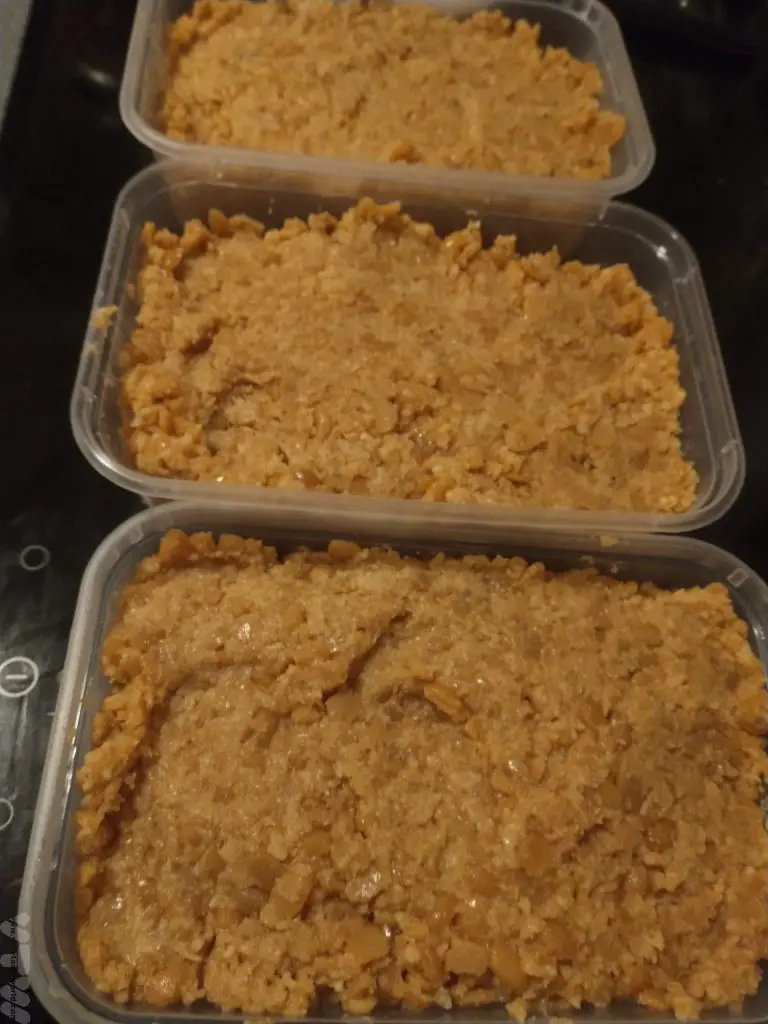
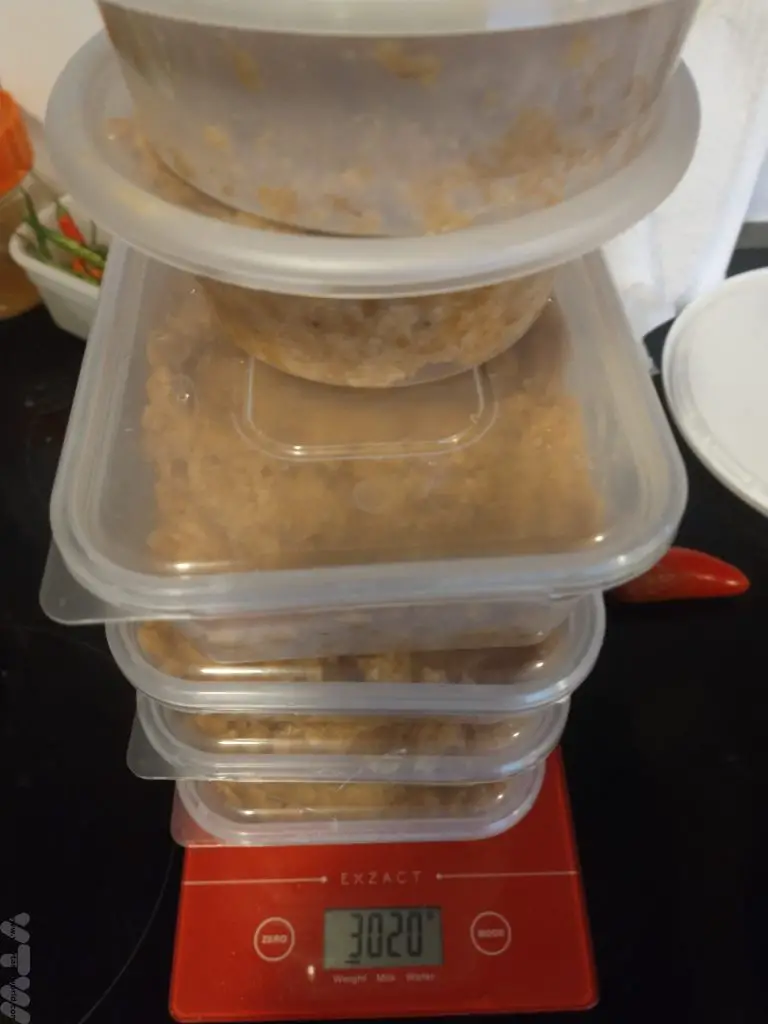
The first thing we made with the miso was soup – the traditional accompaniment to many Japanese meals. Our miso was so delicious that it was possible to make a nice drink by simply pouring boiling water onto the paste, mixing and devouring, but that was too crude an approach.
The very best miso soup starts with a dashi, which is a soup stock. There are several types of dashi. You can get instant powdered dashi and just add water but it’s really easy to make your own using ingredients that are generally easy to find from Asian supermarkets. The process is very simple and much quicker than traditional stock making in European cuisines, which generally require ingredients such as meat, vegetables and spices to be boiled for several hours. And it’s definitely worth the not very considerable effort.
Dashi usually only uses a couple of ingredients. The dashi we made used kombu (kelp – a seaweed) and katsuobushi (bonito flakes, which are skipjack tuna flakes that have been simmered and smoked, then dried in the sun to ferment and finally shaved to wafer thin slices). Katsuobushi, like many fermented fish products (think Thai nam pla – fish sauce), smells somewhat stinky and rather unpleasant when you open the packet, but somehow it adds a magical quality to the finished stock. Other dashi ingredients could include dried shiitake mushrooms or dried anchovies. Dashi definitely puts the “mmm” into umami.
We simmered kombu and bonito for 20 minutes, skimming off any froth from the surface of the broth. Then we sieved the broth and kept the solid materials. A bit like olive oil, this was the primary dashi, but it’s possible to resuse the dried base ingredients to make another dashi.
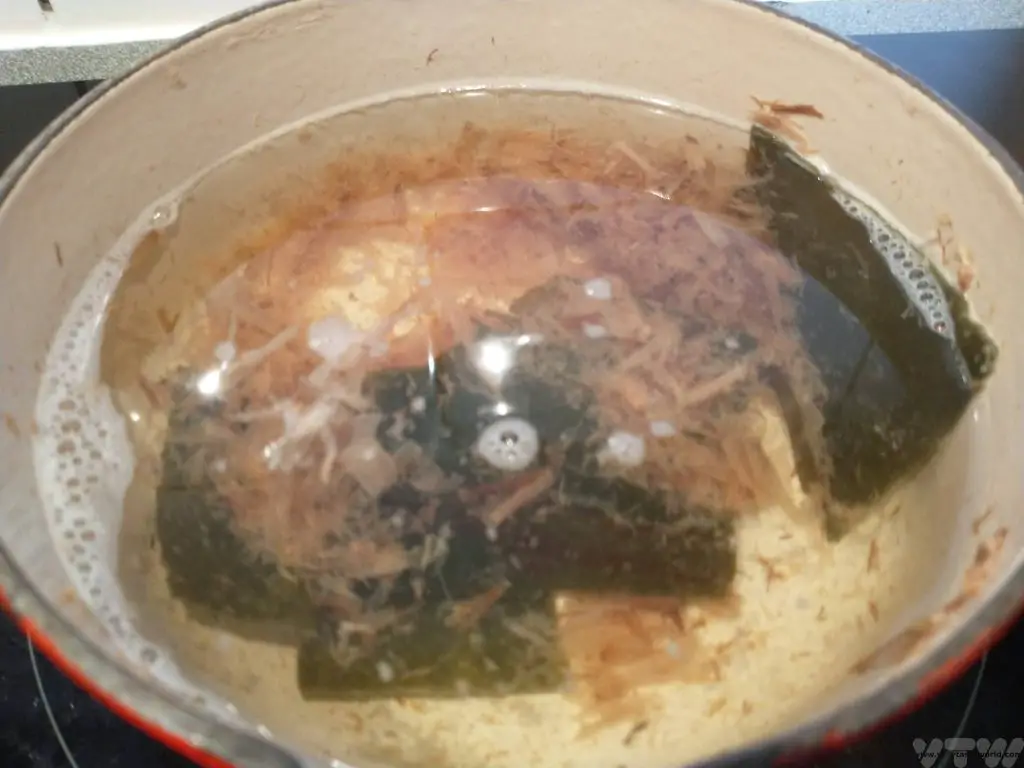
When the dashi is ready add a tablespoon of miso paste and bring to the simmer.
Miso soup usually has some additional ingredients such as negi (like spring onions), tofu, mushrooms or wakame seaweed.
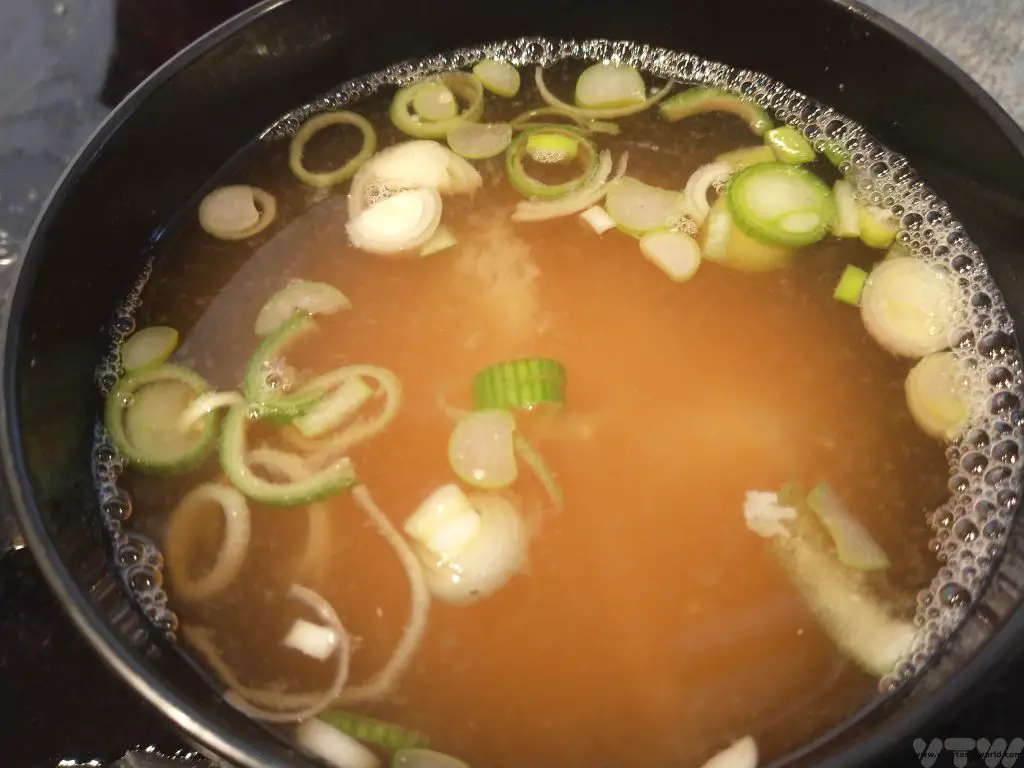
You can find our detailed recipe for making miso soup here.
And here is a link to the highly recommended Preserving The Japanese Way book.
Please note that this post contains affiliate links. If you click the link and decide to make a purchase we will earn a small commission, at no cost to you, which helps towards running this site.

- Recipe: Simmered Shiitake Mushrooms

- How to Use Public Transport in Japan

- RECIPE Oyakodon Donburi

- Planning a Trip to Japan

- The Makanai: Cooking for the Maiko House

- Setsubun Food – Bean Throwing Day

- The Gassho Farmhouses of Rural Japan

- Recipe: Japanese Simmered Pork Belly – Buta no Kakuni

- RECIPE: How to Make Umeboshi


- RECIPE Oyakodon Donburi
- Zero Waste Recipes Before Your Holiday
- RECIPE: Vegetable Biryani Tamil Nadu Style
- RECIPE: Vegan Wild Garlic Pesto
- Recipe: Venetian Pasta Sauce
- RECIPE: Biryani Raita Recipe
- RECIPE: How to Make Costa Rica’s Gallo Pinto
- Recipe: Japanese Simmered Pork Belly – Buta no Kakuni
- RECIPE: How to Make Umeboshi
Recipe: Miso Soup
Miso soup is a traditional Japanese broth made with miso (fermented soy bean paste), dashi (a simple but delicious stock) and a variety of other ingredients of your choice. It’s the perfect accompaniment to so many Japanese dishes. Here’s our miso soup recipe.
Ingredients
3 sheets of kelp seaweed (kombu)
1 packet of bonito flakes (40g)
1 litre water
1 tbs miso paste (home made or shop-bought)
Optional:
spring onions
block of silken tofu
wakame seaweed
enoki mushrooms
Method
It should be possible to buy kombu (kelp) and bonito flakes from Asian supermarkets. The dashi really adds to the deliciousness of the soup but if you can’t get hold of the ingredients, you can make a vegetable/fish stock and skip to the step where you add the miso paste.
Make the dashi: Put kombu and bonito flakes into a saucepan of water.
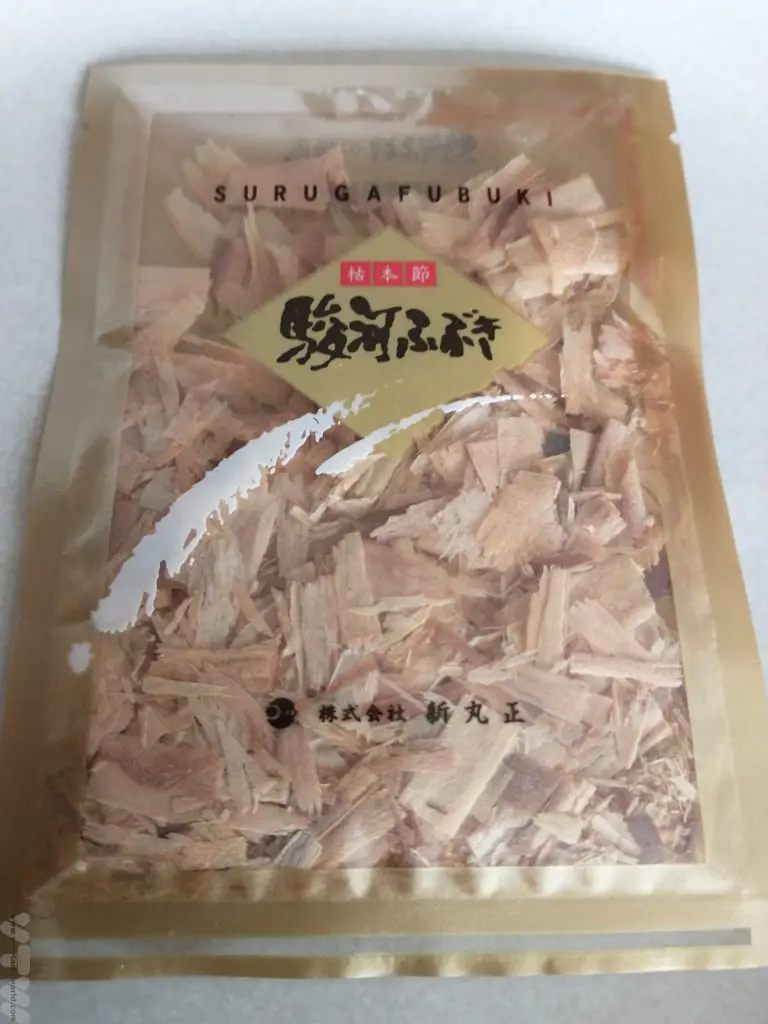
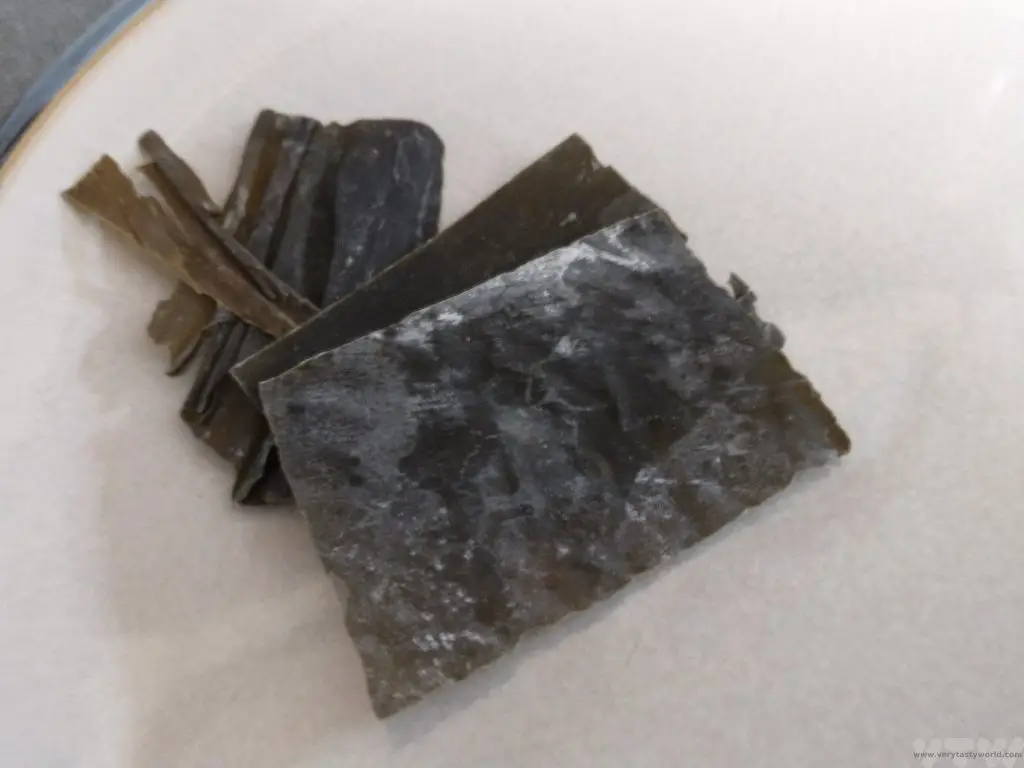
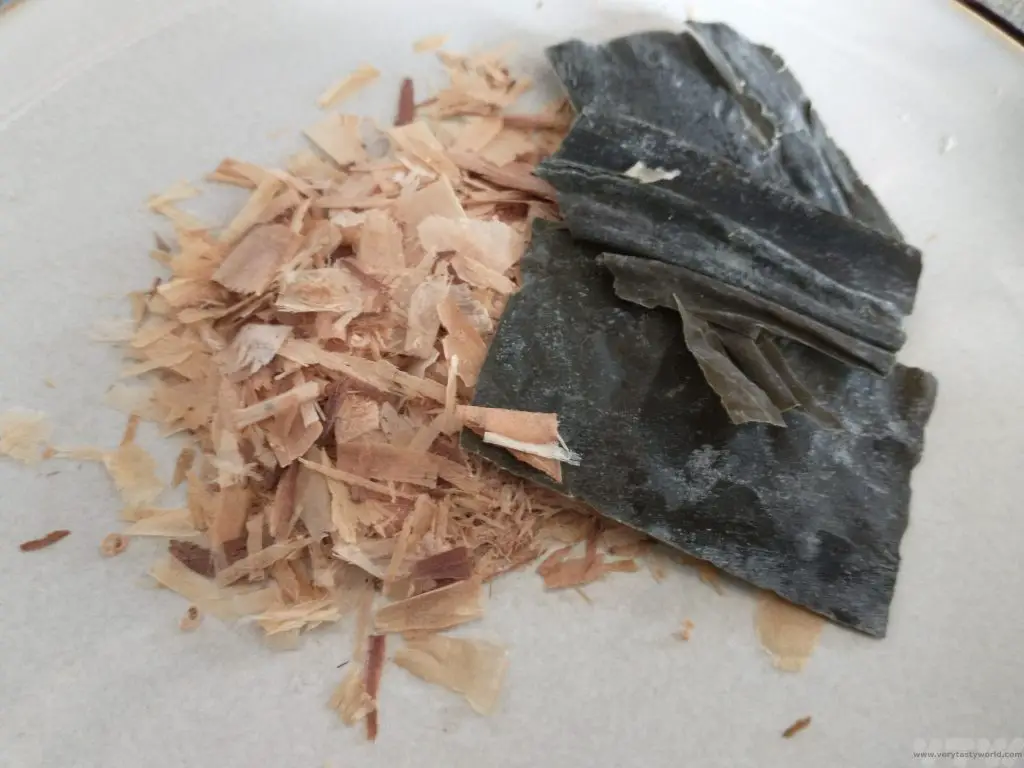
Bring to a simmer. Skim off any froth.
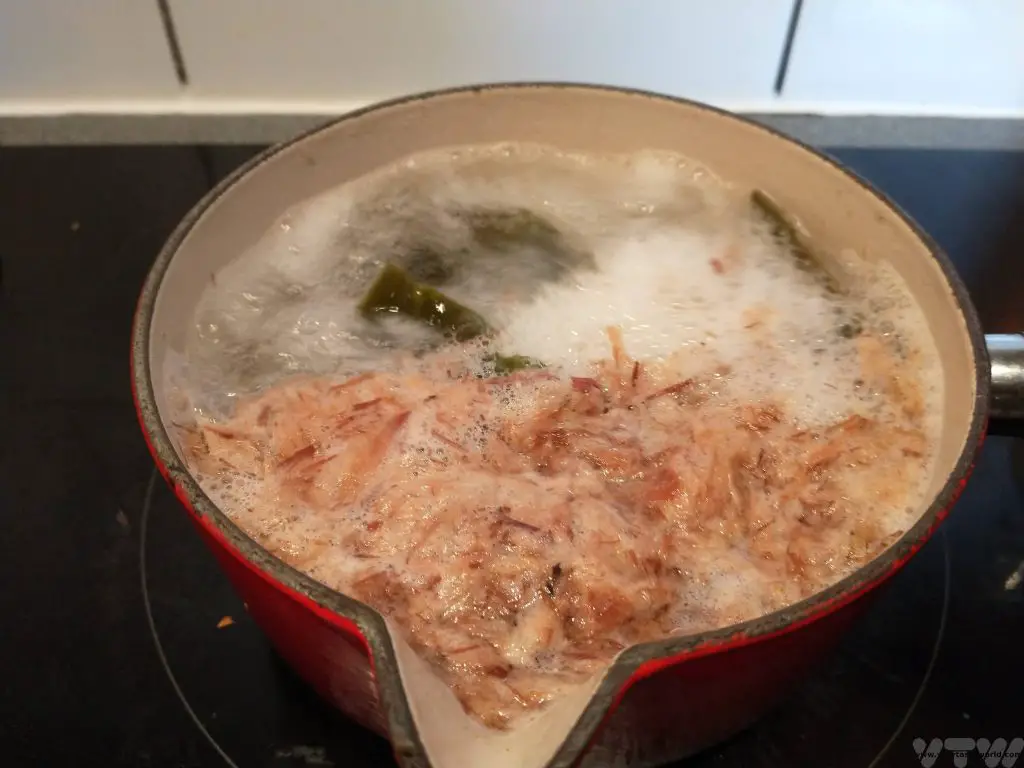
After 20 minutes, you should have a clear broth

Sieve the solids from the broth. Keep the solid ingredients. You can dry these out and use them again to make a secondary dashi.
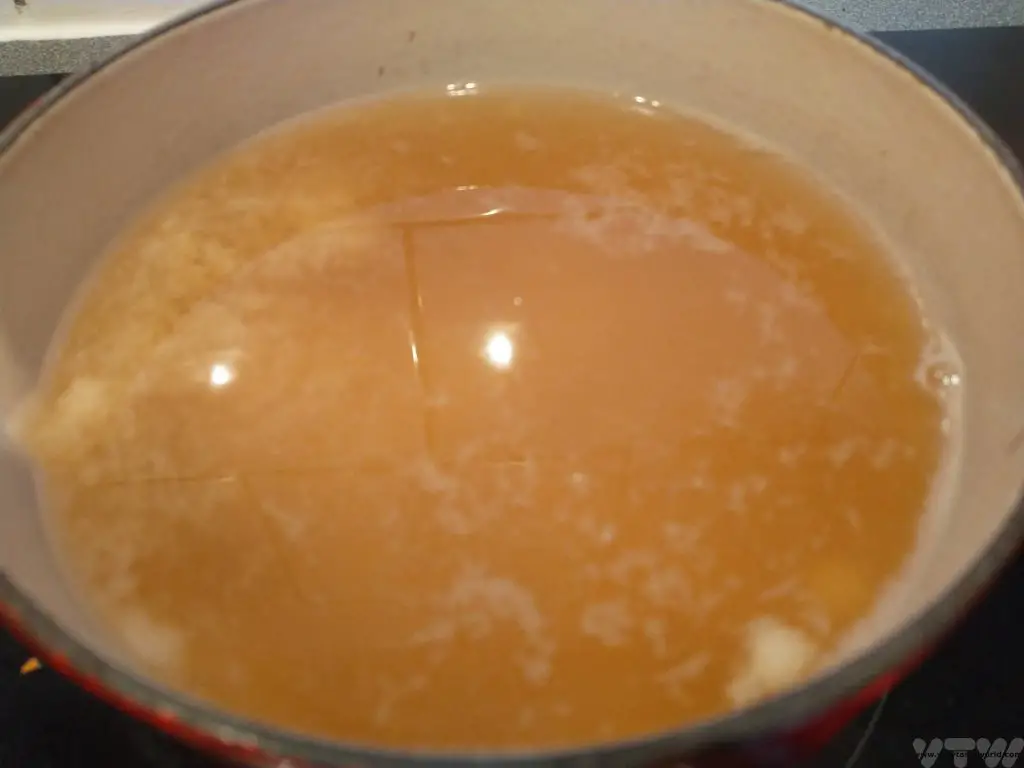
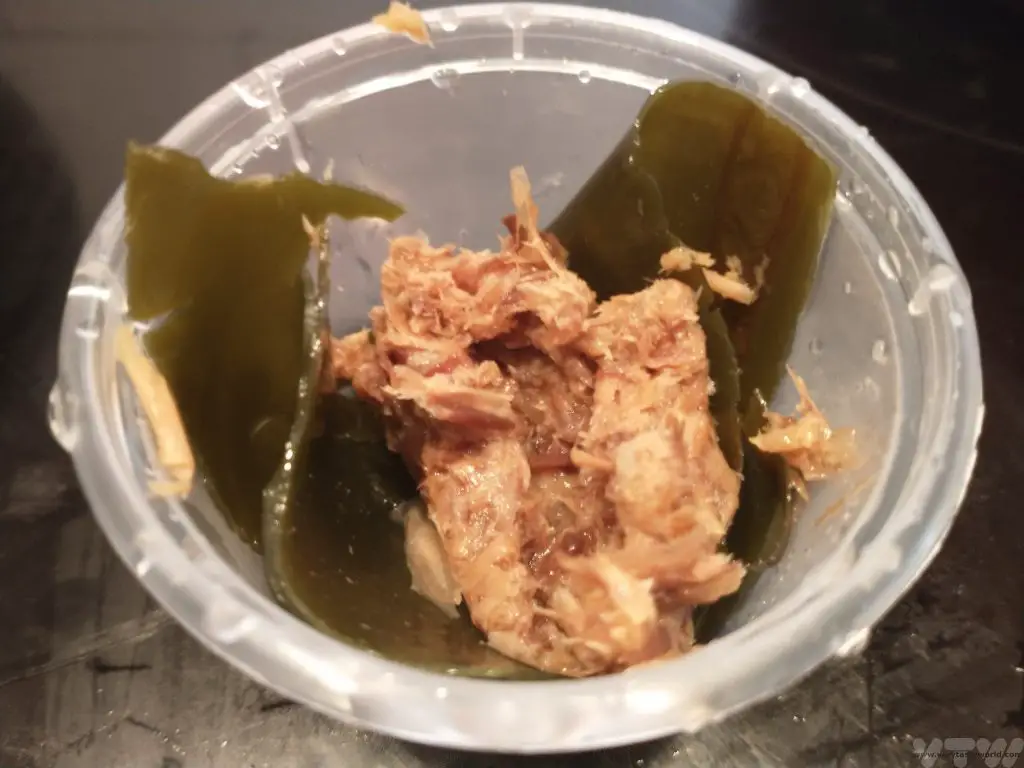
Add the miso paste to the dashi in the saucepan. You can buy miso in most supermarkets but you can also make your own. Warm through gently.
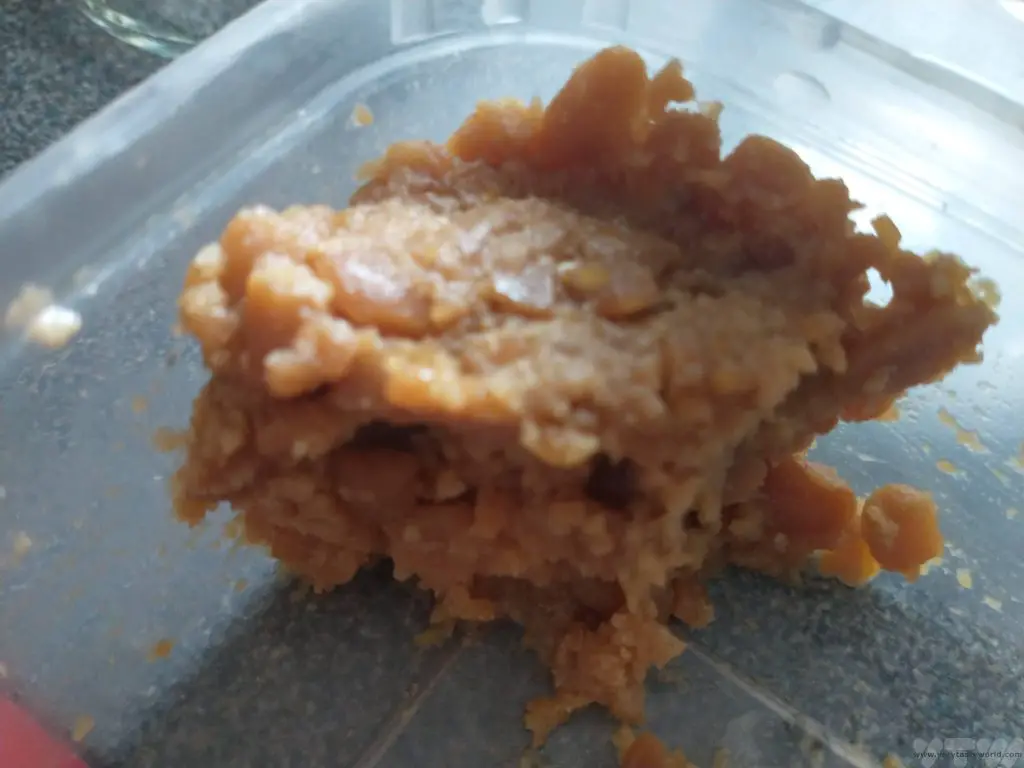
This is the soup base. In this miso soup recipe there are a number of ways to embellish the finished soup. Optional ingredients include such delights as negi (Japanese onions, they are a cross in size between a spring onion and a leek – UK spring onion will be perfect), silken tofu cut into very small cubes, wakame seaweed (a type of kelp that you can buy dehydrated from Asian supermarkets) or small mushrooms (enoki style – the teeny bunches of mushrooms are perfect, but finely chopped ordinary mushrooms will work well).
In this instance we had some spring onions to hand. So they were finely sliced and placed in a serving bowl.
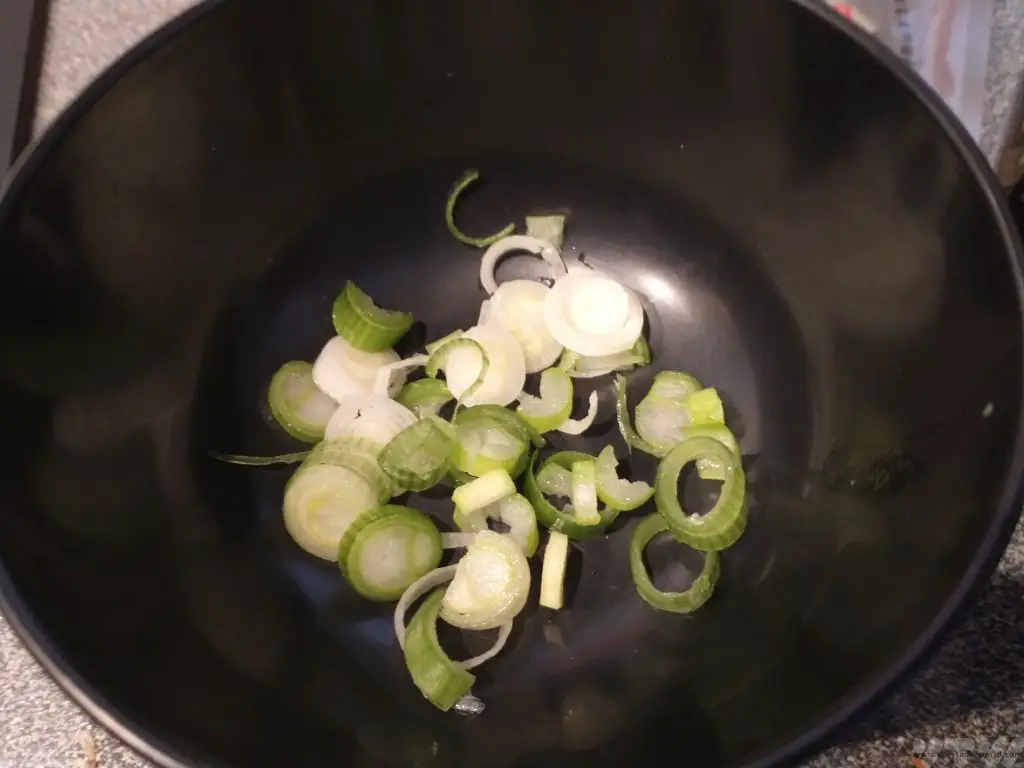
Pour the miso broth on top. Enjoy while hot.

It is absolutely fine to drink the miso soup using a spoon or to drink directly from the bowl. In Japan, it’s also okay to slurp – this helps cool the hot liquid as you drink it. Make sure you stir it (you can use chopsticks to do this) before consuming so that the ingredients that settle at the bottom are agitated – the miso never dissolves completely into the broth – and produce an even flavour throughout the drinking.
Related Posts You May Enjoy

- RECIPE Oyakodon Donburi
- Zero Waste Recipes Before Your Holiday
- RECIPE: Vegetable Biryani Tamil Nadu Style
- RECIPE: Vegan Wild Garlic Pesto
- Recipe: Venetian Pasta Sauce
- RECIPE: Biryani Raita Recipe
- RECIPE: How to Make Costa Rica’s Gallo Pinto
- Recipe: Japanese Simmered Pork Belly – Buta no Kakuni
- RECIPE: How to Make Umeboshi
Making Miso Happy Part 1
Miso is the very essence of the fifth flavour umami, that enigmatic taste of ‘savouriness’ or ‘deliciousness’ and forms the flavour base of so many Japanese dishes. At its heart it is basically a fermented mix of soy beans, rice, koji (aspergillus oryzae, the national mould of Japan – really!), salt, water and time…
Like many Japanese foodstuffs, miso has regional variations. As a general rule (and there are always exceptions) the colour of finished miso is darker in the north, and lighter in the south of the country. Kyoto is famous for sweet white miso, for example. This means that it is possible to encounter a wide variety of miso on your travels – from rich umami to salty to sweet and with textures from smooth to chunky.
We visited a miso factory/koji park on a trip to Kanazawa on the western coast of Japan. Shinkansen (bullet train) construction reached Kanazawa just recently, in 2015, and the city is now easily accessible from Tokyo; the journey takes around 2.5 – 3 hours. It’s a great city with a lively market (which has some amazing seafood restaurants) and one of the top three gardens in Japan. The miso factory is located at Ohno machi (Ohno port), which is a bit of a journey; you can catch a bus from the Kanazawa station area (ask for the location of the bus stop at the tourist information centre inside the station concourse – it’s a five minute walk away) and it’s the very last stop. When you arrive at the sea you are there. You’ll likely be the last ones on the bus. Alternatively you can get a taxi. The journey from the station takes around 20 minutes but the cost is considerably higher than the bus. Then just walk over the bridge to the little island.
As an aside, at the far end of the island is a charming museum of mechanical toys which has a brilliant hands-on exhibition where you can spend hours playing games and enjoy viewing antique toys and games. The staff were absolutely delightful and very much wanted to make sure we enjoyed the exhibits. They were also very helpful when it came to supplying a timetable for the bus journey back into the centre of Kanazawa.
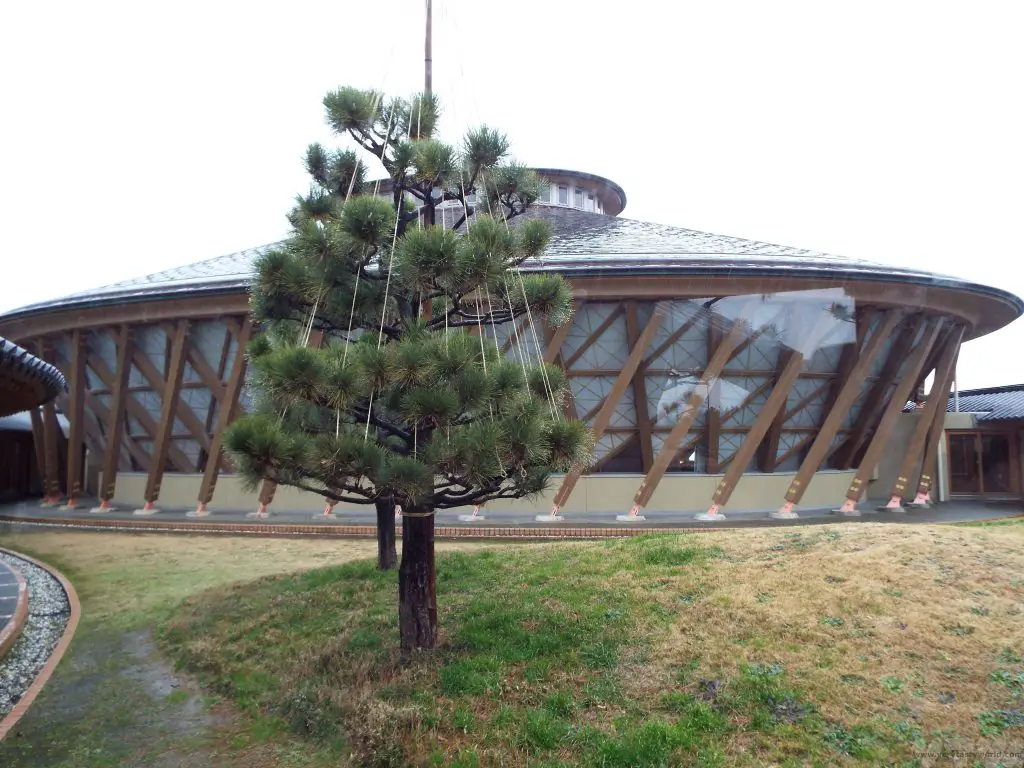
There are many historic mechanical puppets – karakuri – on display. The museum is a memorial to Benkichi Ohno,a master craftsman who lived in the area from 1831. Many of his creations can be seen at the museum.
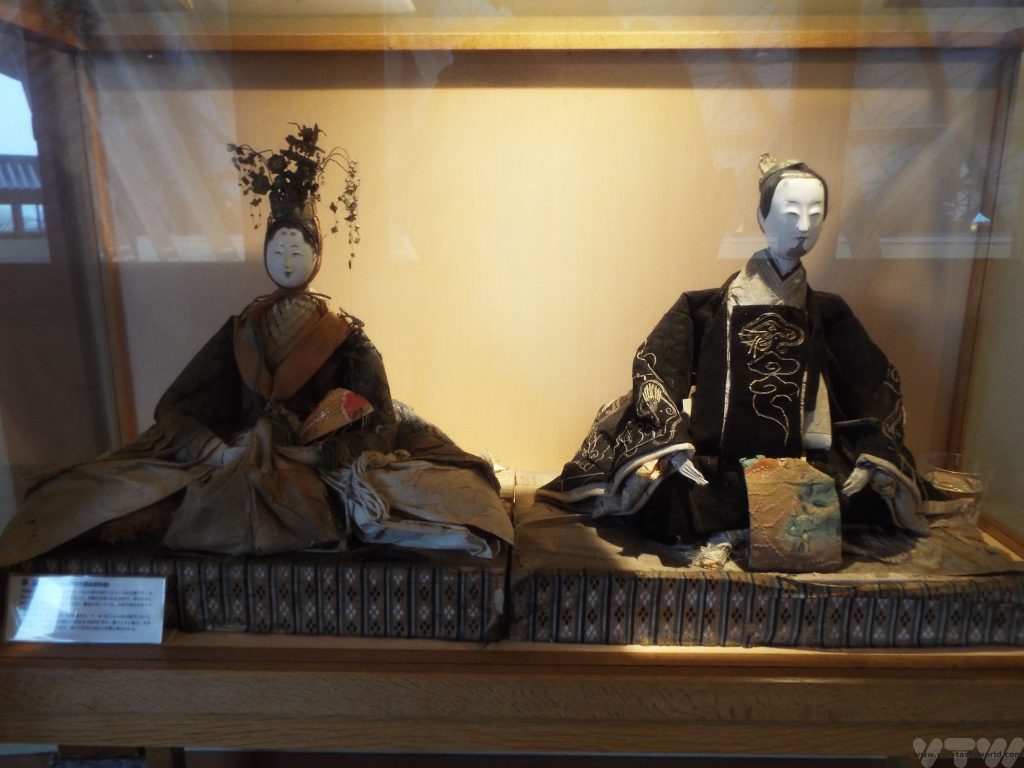
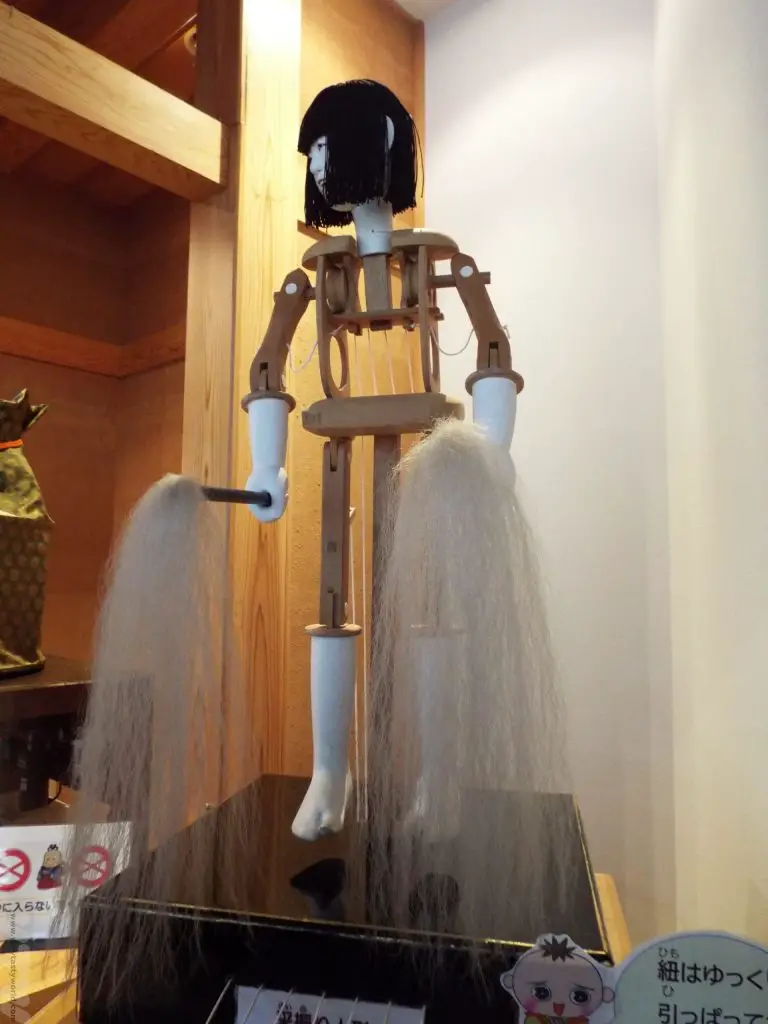
Some exhibits show you how the puppet mechanisms work.
Some dolls are cute(ish) which turn into scary (incidentally these words are, respectively, kawaii and kowaii in Japanese, be careful not to confuse the two!).
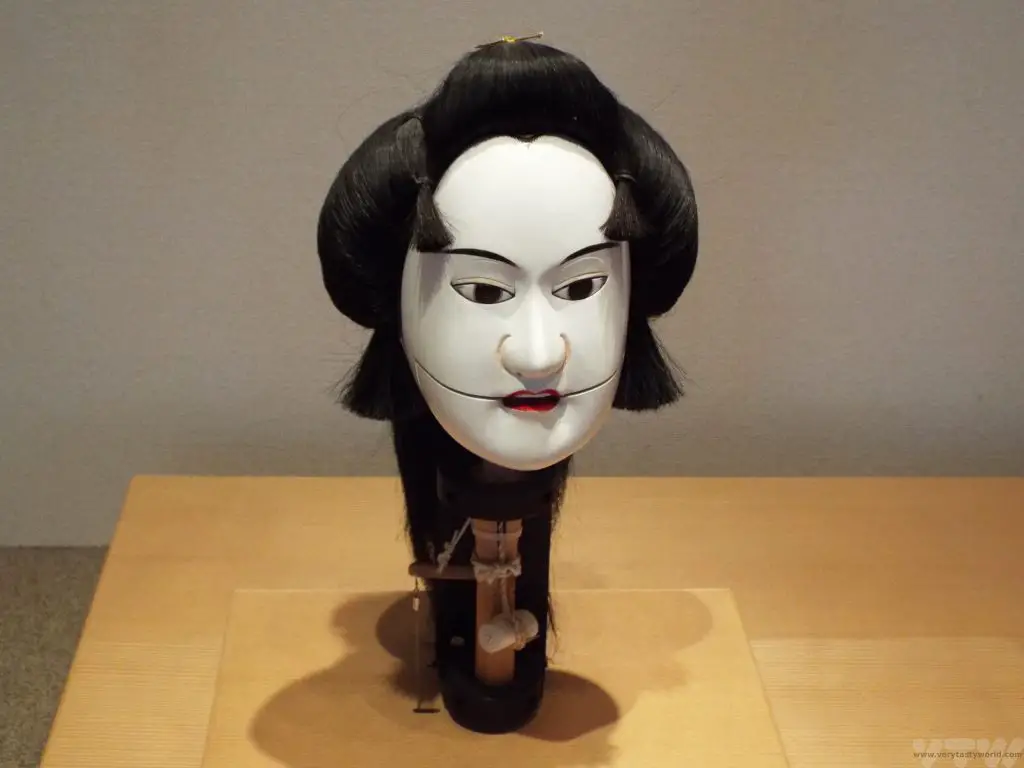
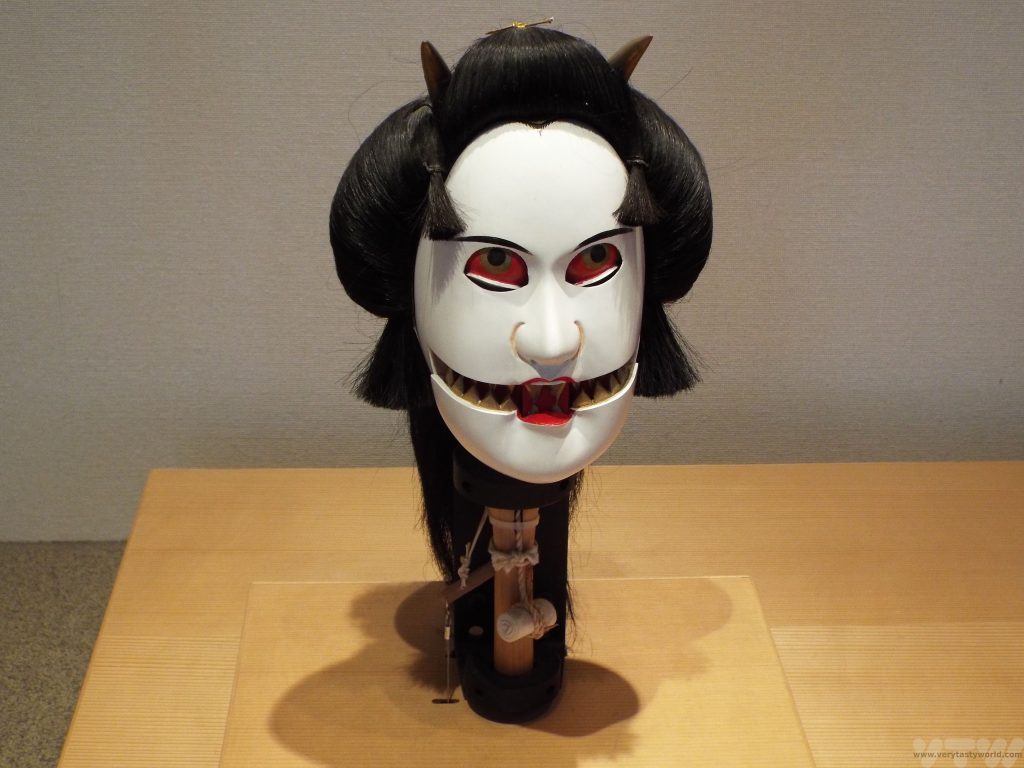
Around the circumference of the main building there are tables and chairs set out with all sorts of puzzles that you can try to solve.
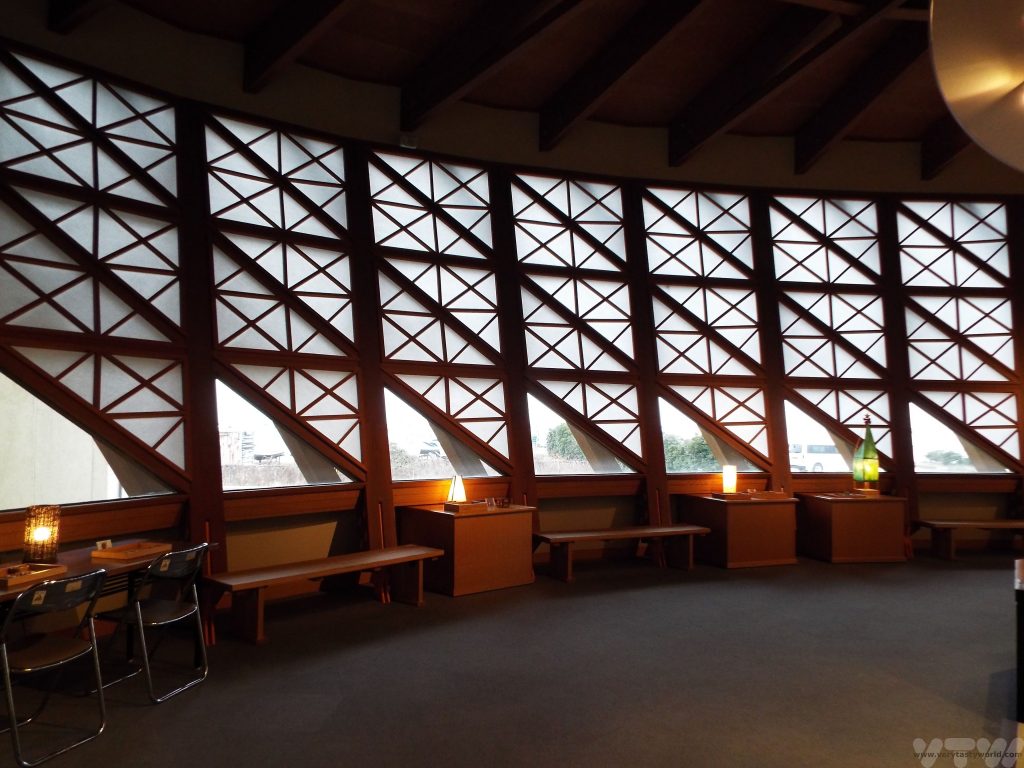
It’s a really hands-on museum and it was lovely to see families with children of all ages sitting together and working out solutions to some of the puzzles.
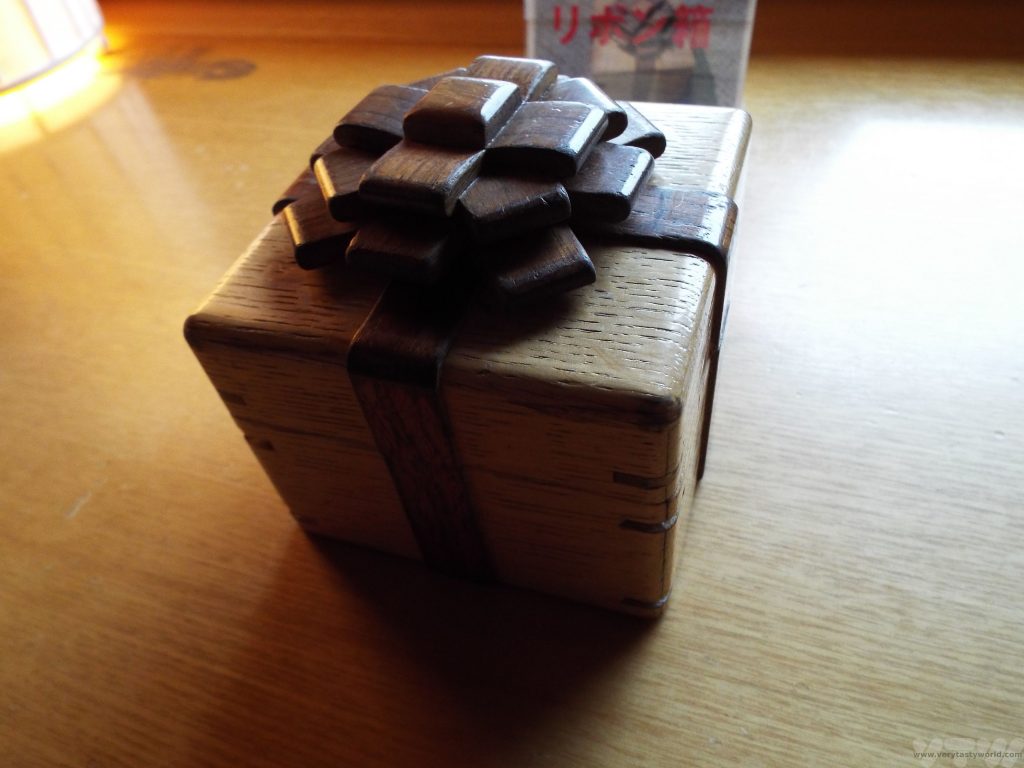
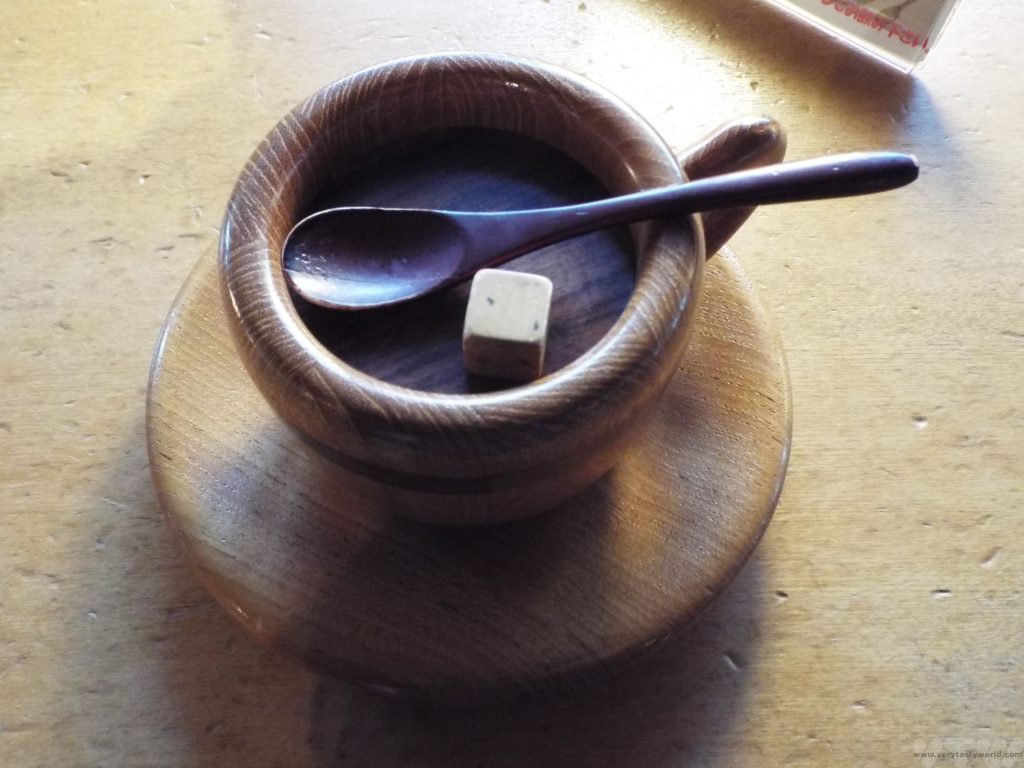
This doll is 300 years old, from the Edo period. The craftsmanship is exquisite.
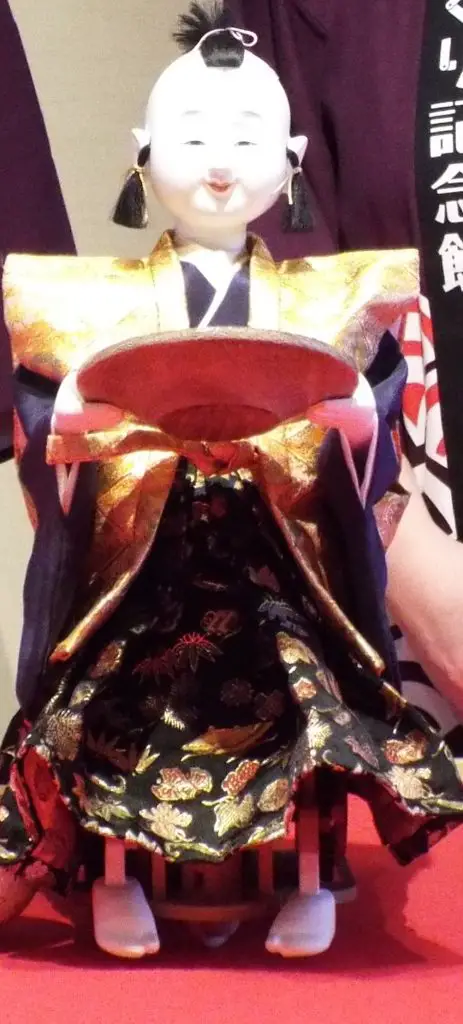
Just as we were leaving the park, the heavens opened and the rain started lashing down. We started to make a dash but a lovely staff member ran after us, brandishing an umbrella. We thanked her kindly but explained that we were British and were used to lots of rain. No, they insisted, and gave us a brolly so that we wouldn’t get wet. We’ve experienced this sort of kindness all over Japan, a welcoming generosity that just makes us love the country more and more.
So, after a lovely diversion, it was on to the Yamato koji park, just a 10 minute walk (or 5 minute trot in the rain) away at the other end of the island. It’s part factory, part museum, part shop and part café. There weren’t any specific tours when we visited but the staff were super-helpful and directed us to a display where we could understand how miso is made.
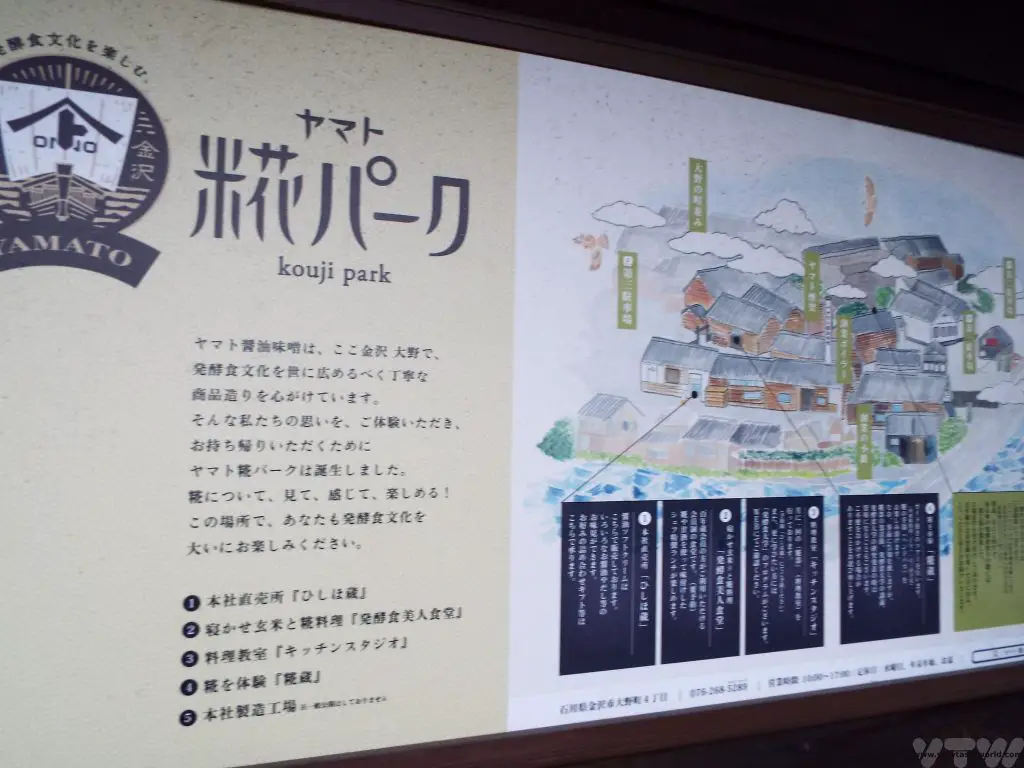
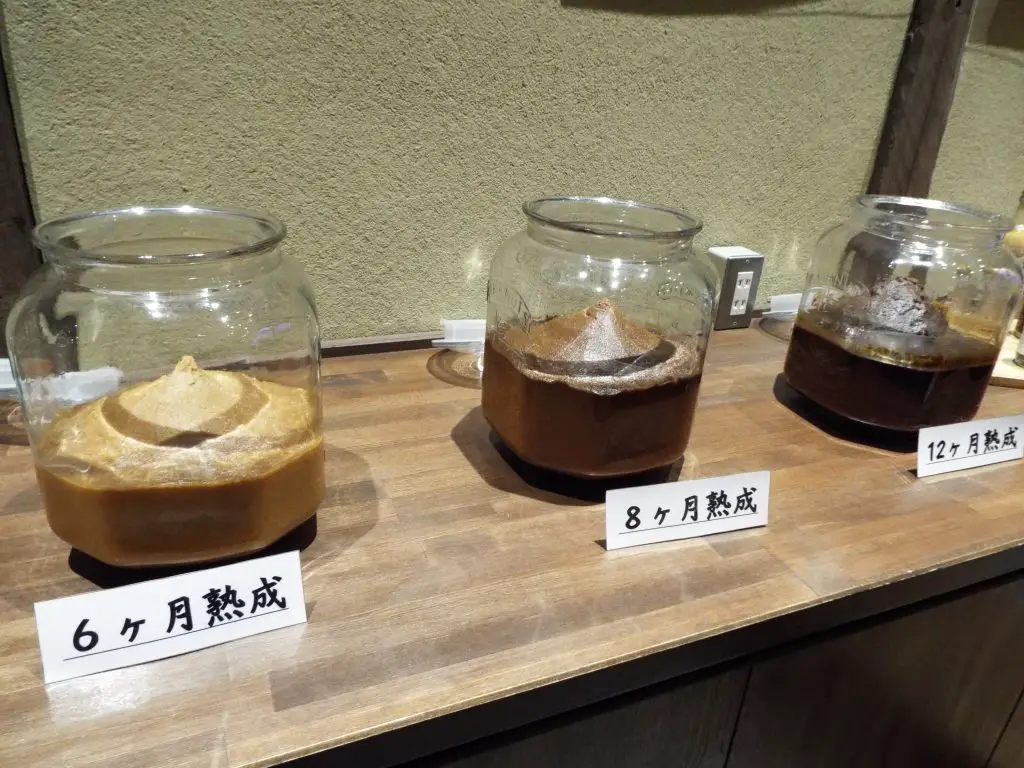
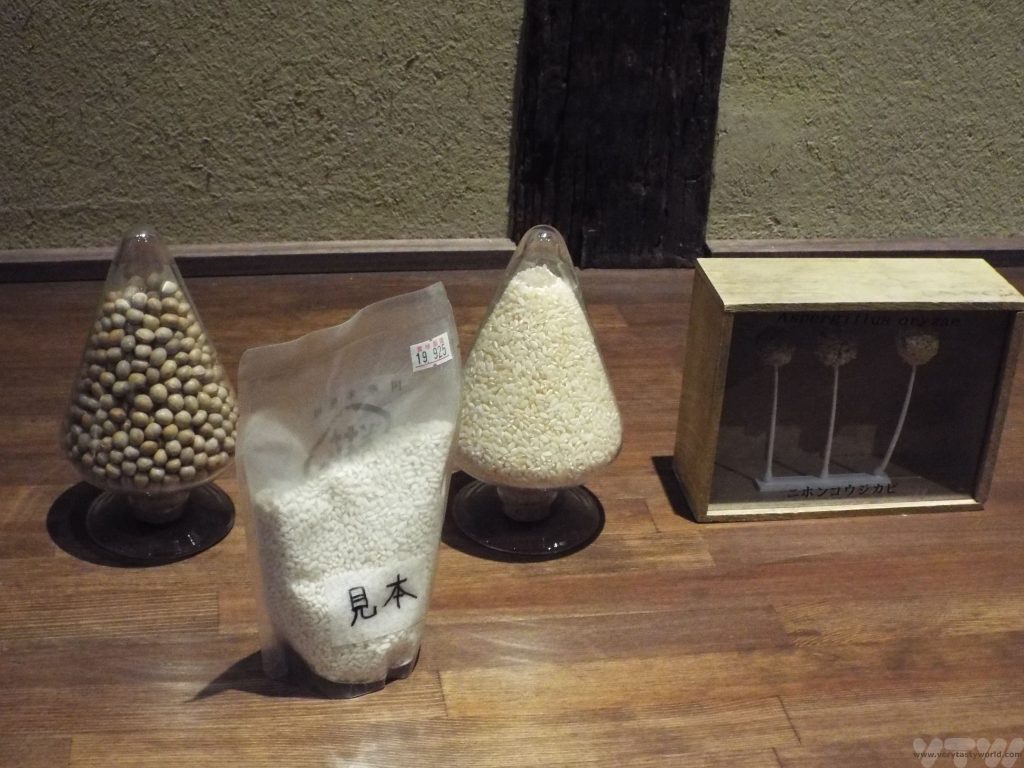
Miso basically contains five ingredients: water, koji, soy beans, rice, salt. Koji thrives on the rice. Then it is mashed with the soy beans, salt and water. After about six months yeast forms. The miso flavour develops thanks to the interactions between the yeast and the koji. Fermentation can take as long as three years.
Soy sauce is made using a very similar process and ingredients to miso but uses wheat instead of rice. A mash is formed and then it’s pressed (like olives for olive oil). After fermentation, the resulting liquid is soy sauce. It was fascinating to taste the difference between pasteurised and unpasteurised soy sauce. Unpasteurised soy has a more complex flavour because some of the heady aromas are lost in the pasteurization process.
Some the the traditional fermentation vessels are enormous. This was over two metres in height.
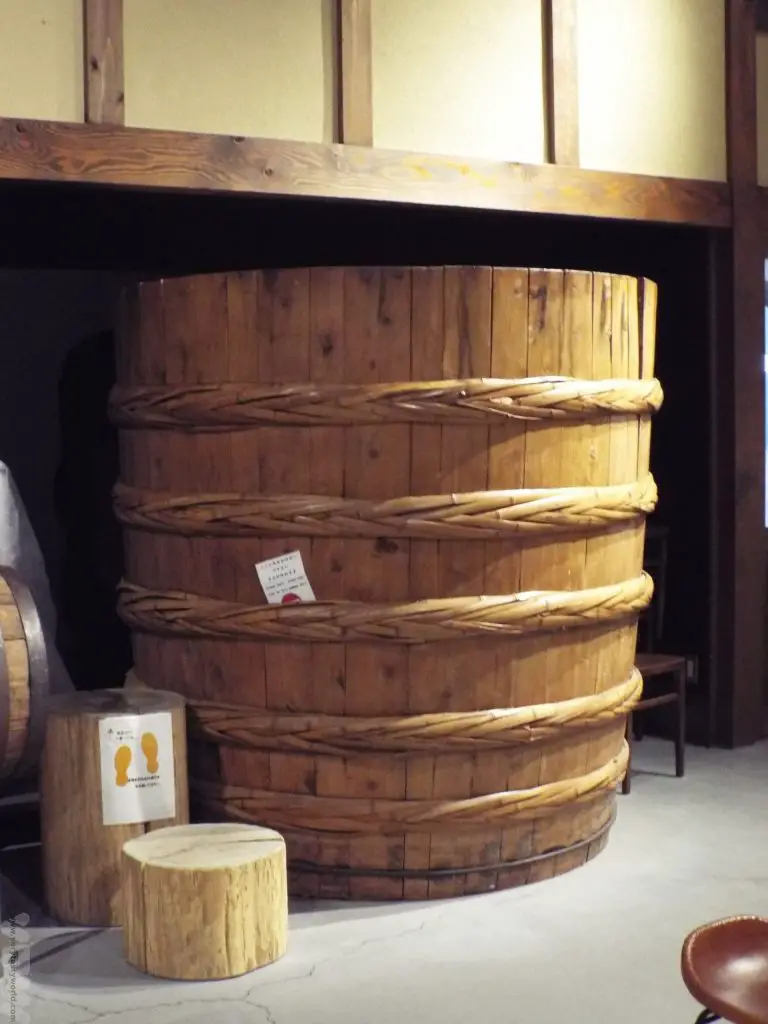
You can also dip your hands into a koji hand bath which will, apparently, give your skin a soft and delicate sheen. It’s quite nice to be able to dip your hands into a warm bath, especially on a cold, wet day. Apparently two minutes is the optimum time – there is a timer so you can check. And yes, we can confirm that our hands did emerge from the bath silky-smooth.
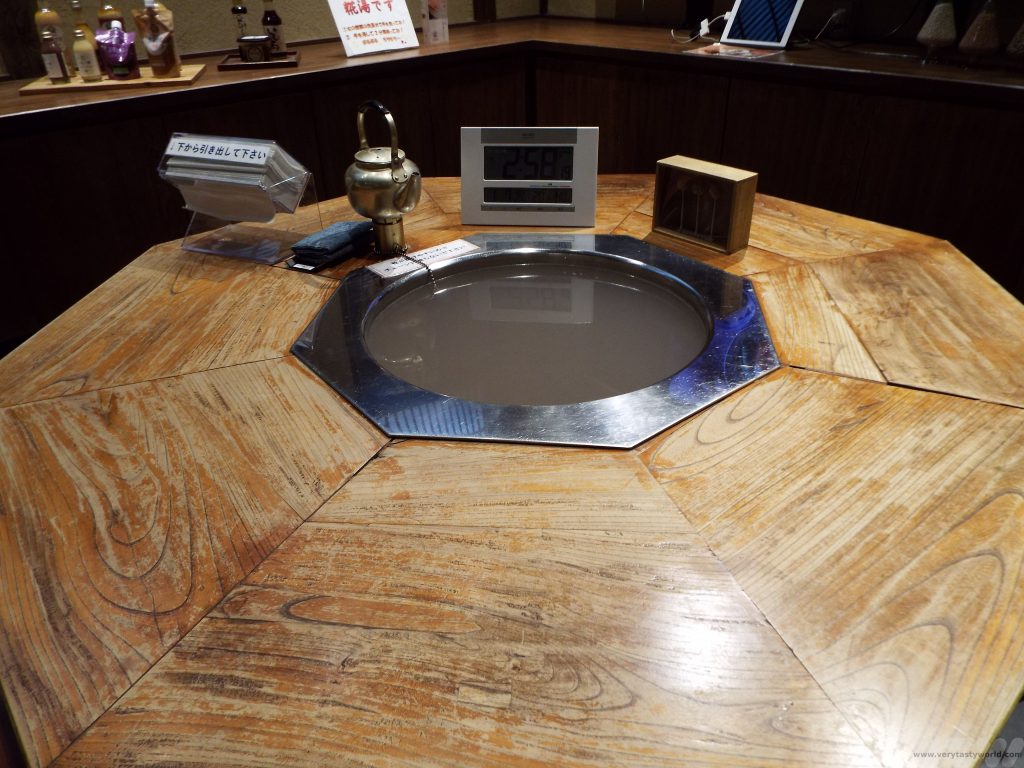
There is a shop with an extensive variety of products and you are able to sample before you buy. It was particularly interesting to be able to taste different sauces and compare the flavours.
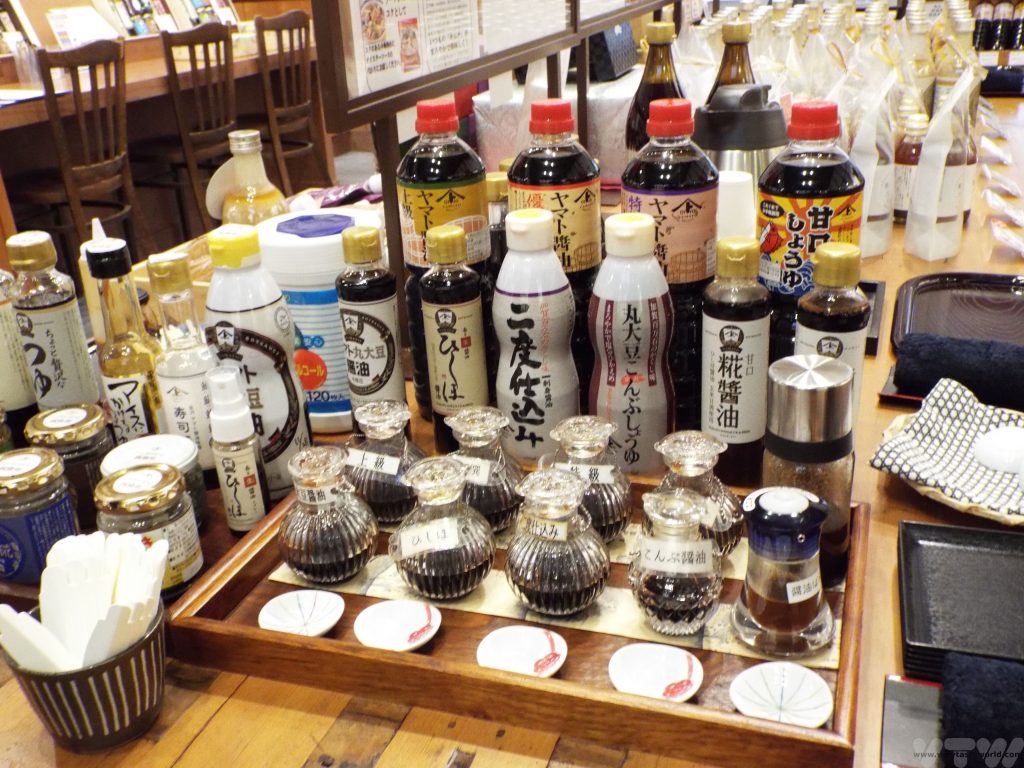
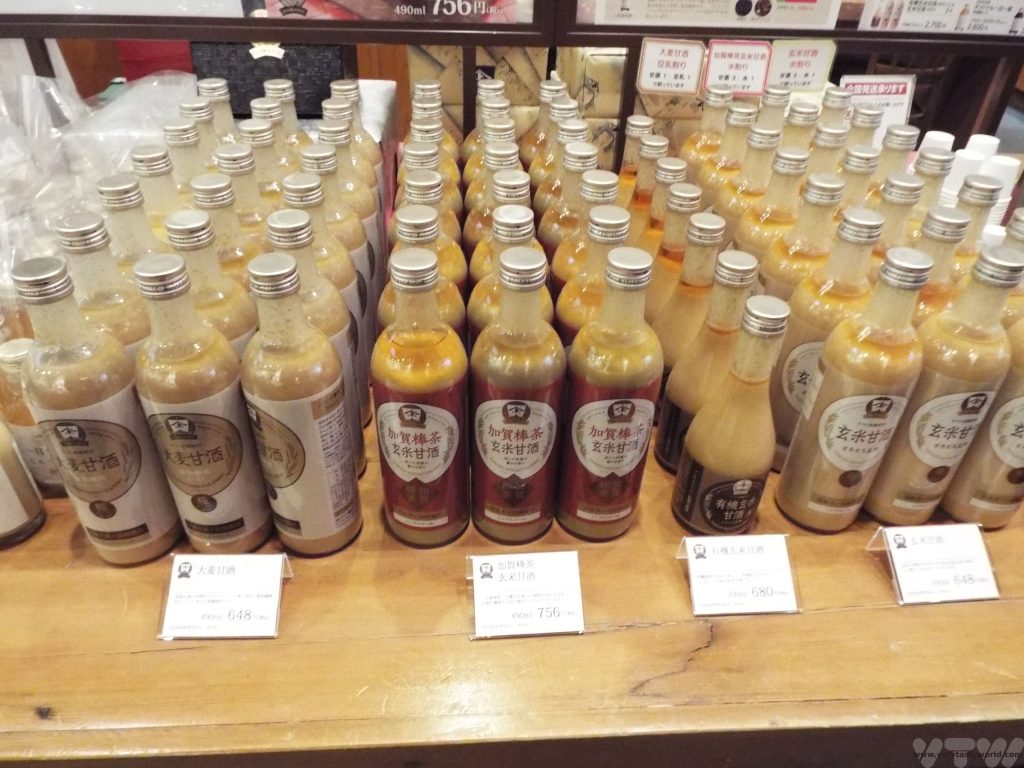
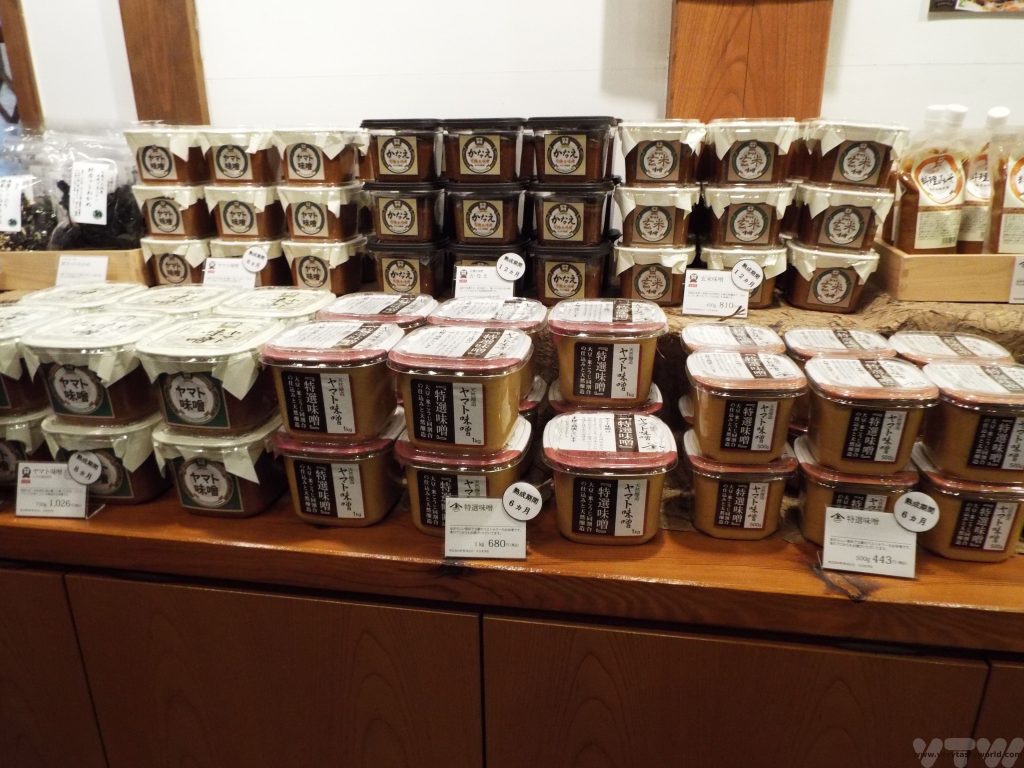
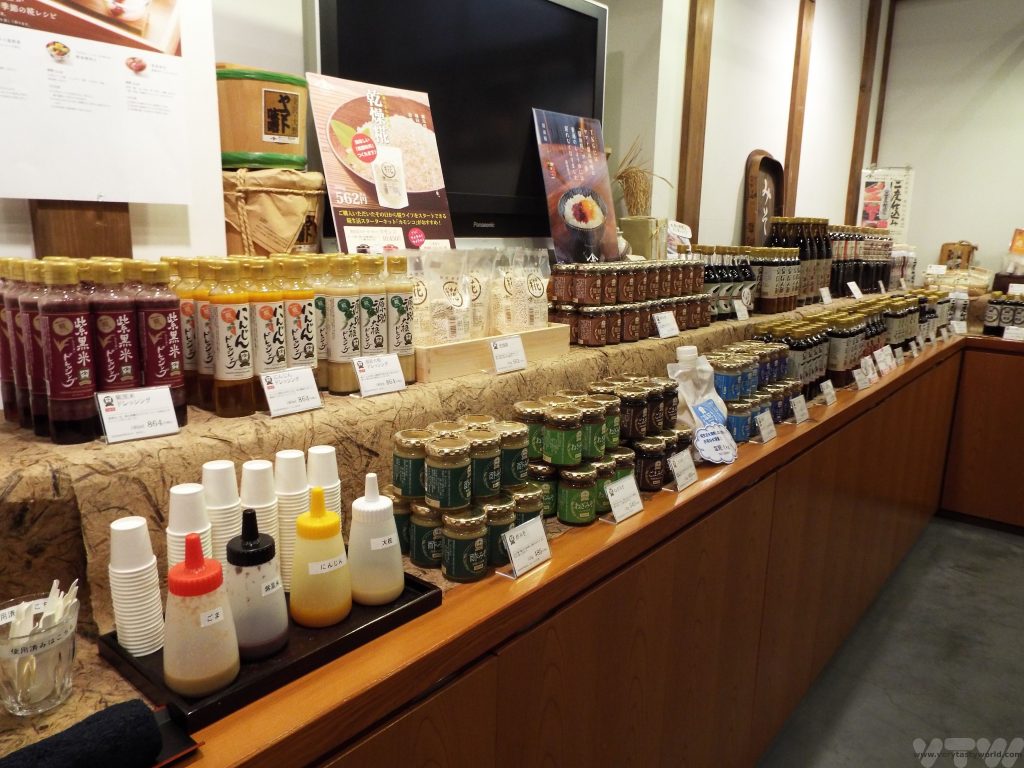
Amazake is a sweet, low alcohol drink made from fermented rice and koji. Amazake literally means ‘sweet’ (ama) ‘sake’ (sake, which can be used to describe alcohol). You can buy the paste, mix with hot water and drink. It tastes sweet and has a smooth, creamy texture. And for a delicious dressing, you can mix amazake with ponzu soy sauce (ponzu is a citrus juice comprising Japanese fruits sudachi, yuzu, and kabosu and vinegar mixed with soy sauce to give an amazingly tangy, salty flavour) in the ratio 1:1.
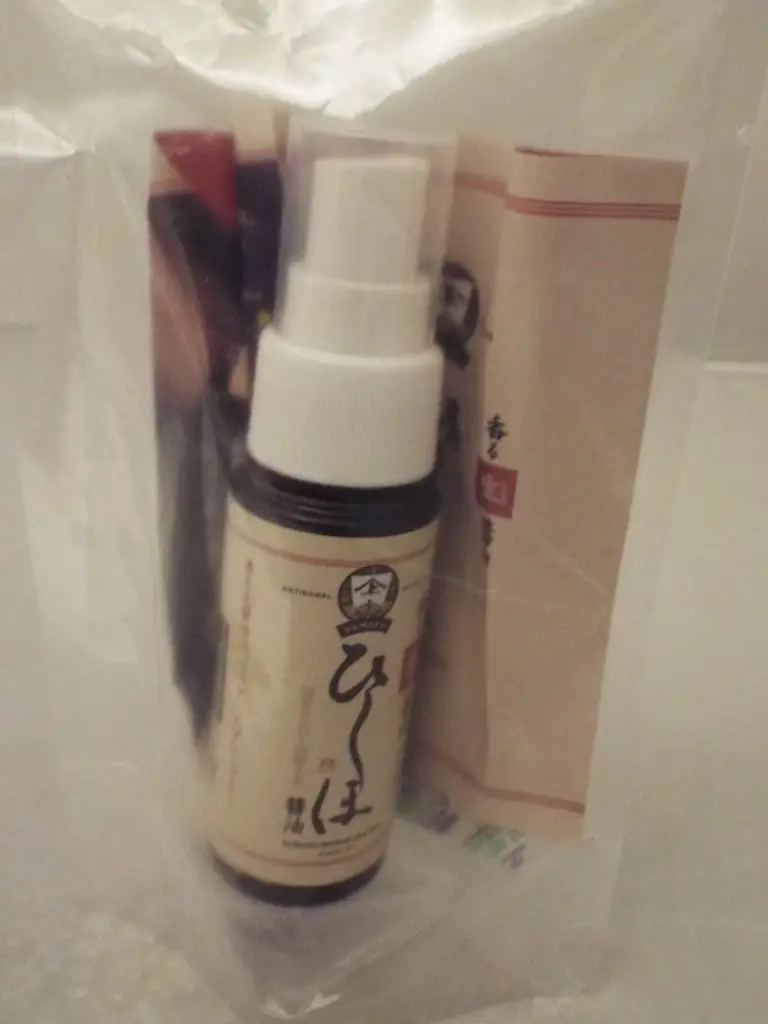
And one of the best foodie souvenirs ever – for the adventurer who cannot travel without seasoning – spray soy sauce, conveniently packaged in a container that would even fit into your hand-baggage.
They also have a café and ice-cream maker. Amazake and soy sauce ice-cream were on offer and we tried both. Soy sauce ice cream sounds so wrong but it was delicious, full of rich salty umami flavour that complemented the creamy sweet ice-cream.
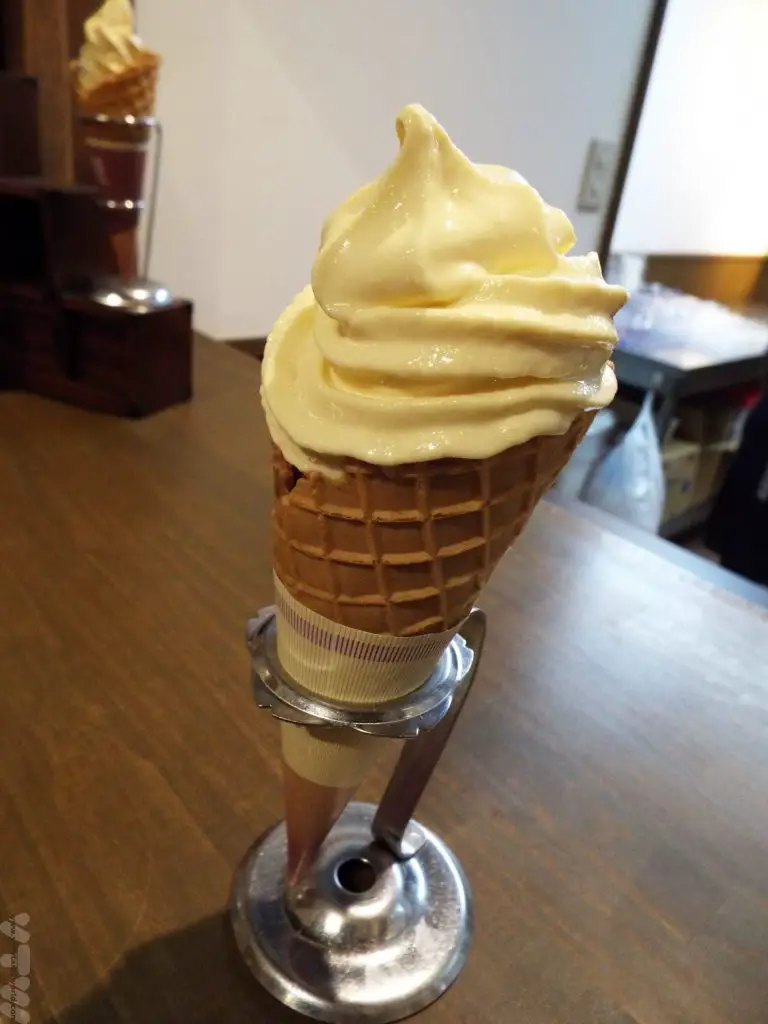
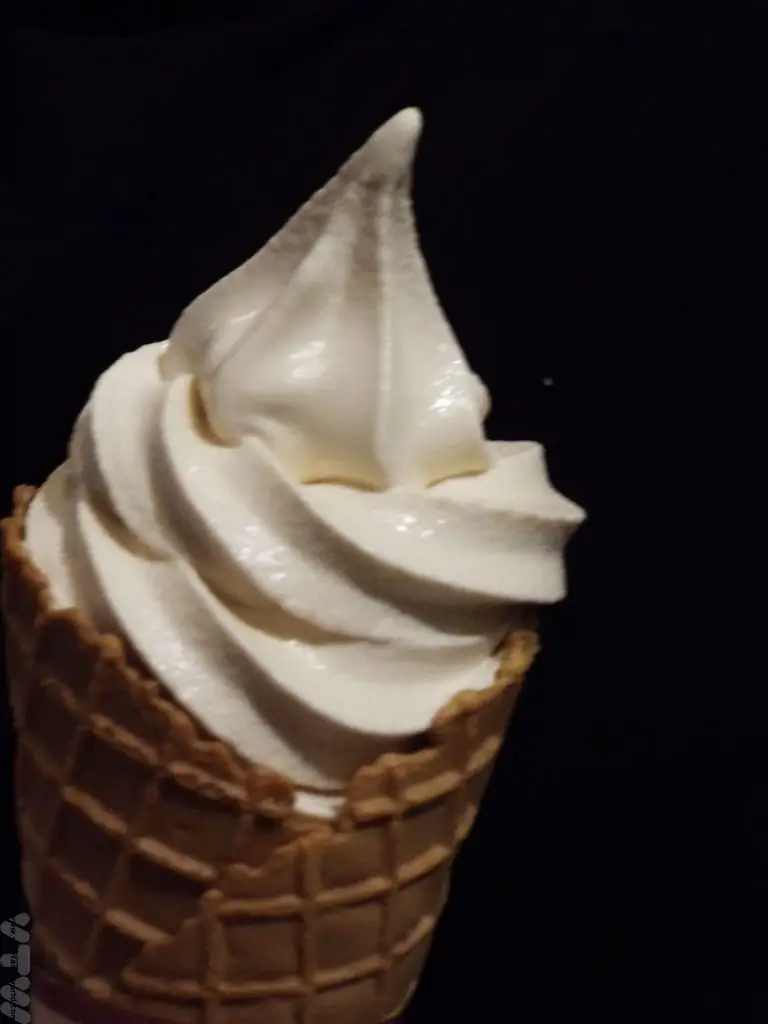
What was also rather lovely was that the CEO, Mr Yamato, was on site that day and came to say ‘hello.’ We can’t think of many companies where the boss would greet some very enthusiastic, albeit extremely damp, tourists.
We shopped for as many products as we could fit into our luggage. One particular packet that we were very happy to find was that of inoculated rice koji. It was also conveniently flat for packing and much cheaper than koji that we can purchase in Europe.

Making our very own miso was most definitely going to be one of our foodie missions on our return home. And this is how we made it…

- Recipe: Simmered Shiitake Mushrooms

- How to Use Public Transport in Japan

- RECIPE Oyakodon Donburi

- Planning a Trip to Japan

- The Makanai: Cooking for the Maiko House

- Setsubun Food – Bean Throwing Day

- The Gassho Farmhouses of Rural Japan

- Recipe: Japanese Simmered Pork Belly – Buta no Kakuni

- RECIPE: How to Make Umeboshi

The Very Best Views in Scenic Japan
Three is a Magic Number
Of the many, many beautiful places to visit in scenic Japan, there are three that have been officially designated to be the most celebrated. Hayashi Gahō, a philosopher and Confucian scholar, declared the Nihon Sankeiin, or Three Views of Japan, in 1643. These places were considered to be both beautiful and representative of Japan’s cultural heritage. The views are located in very different regions of the country and, as Japan is an island nation, they all have a setting by the sea. It is possible to visit them using public transport and they are emphatically worth travelling to see.
Scenic Japan View Number One: The Itsukushima Shrine
The Itsukushima Shrine is probably the best known of these views. Japanese tourist literature and guides often show a picture of the iconic red torii ‘floating’ in the Seto inland sea. It is located on the delightful island of Itsukushima, more commonly known as Miyajima, which means ‘shrine island’ and it is a UNESCO world heritage site.
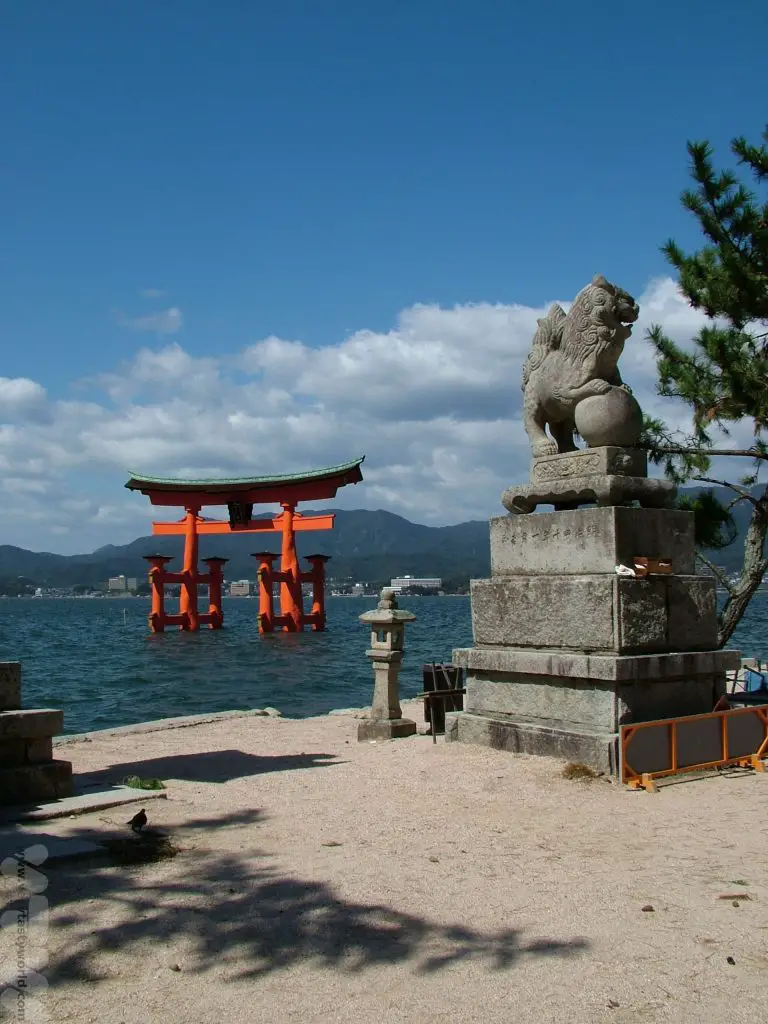
It is a beautiful sight, especially when the sunlight catches the sparkling sea.
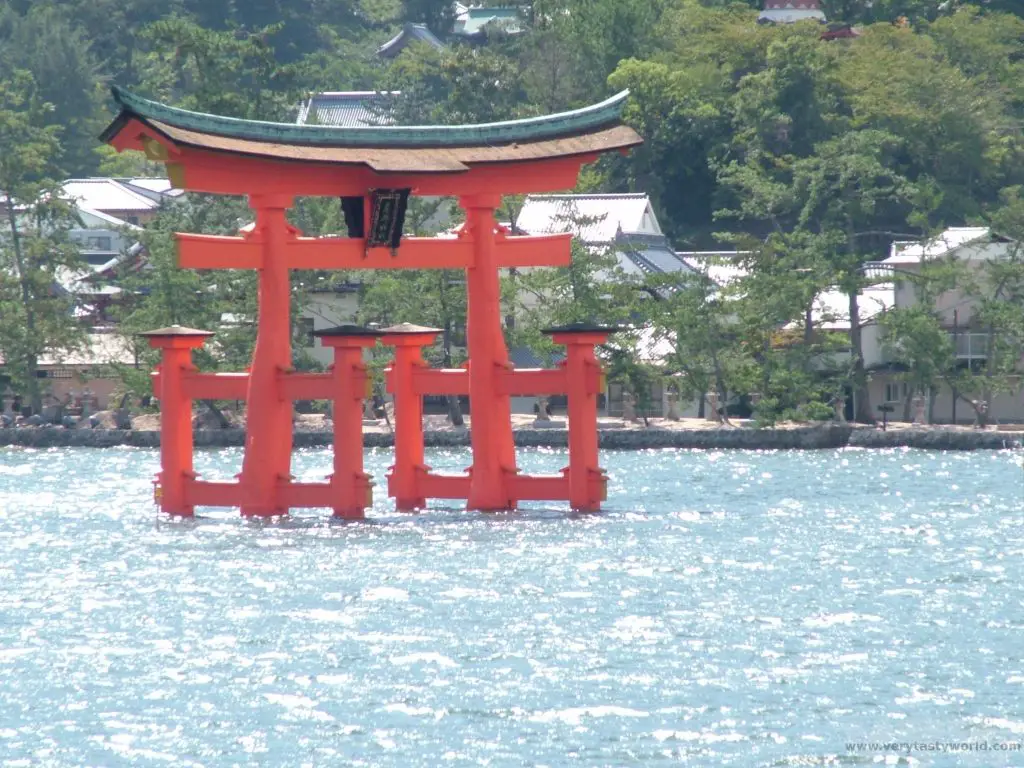
It’s less beautiful when the tide is out so it’s worth planning a visit for when the tide is high if you want to take that perfect Instagram snap.
The torii, in common with all Shinto temples, is actually the gateway to the shrine and it is possible to visit the shrine complex itself. These include Toyokuni Shrine, with its five-story pagoda, as well as the Daiganji Temple. The compound even has a noh stage – for traditional Japanese theatre.
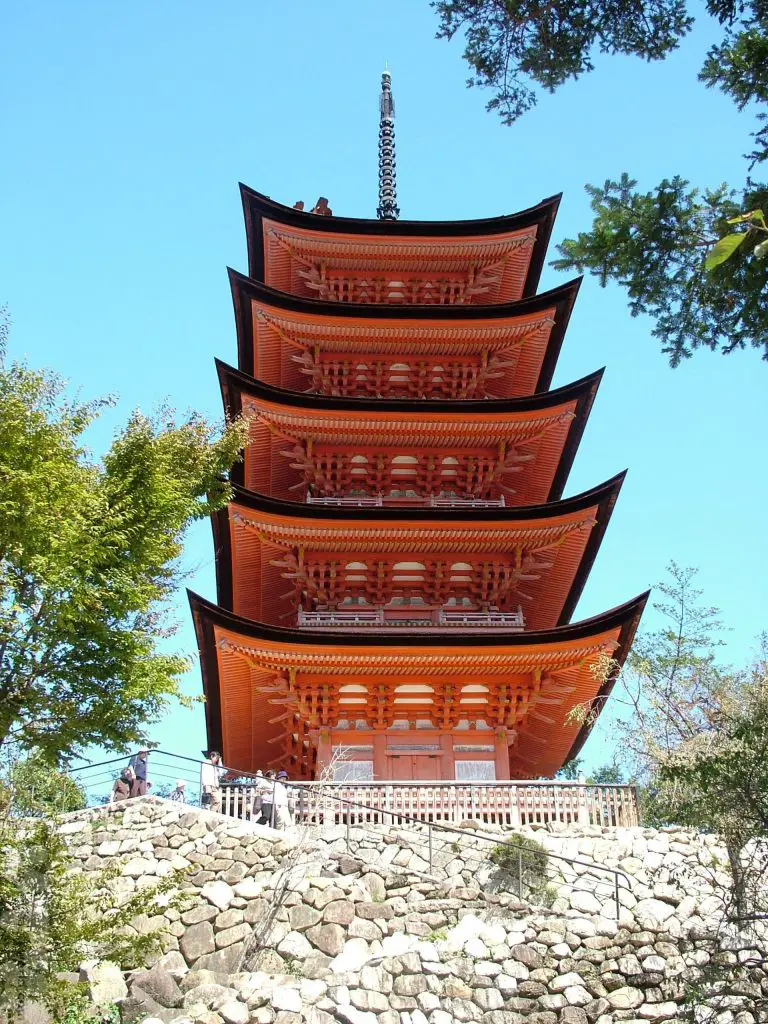
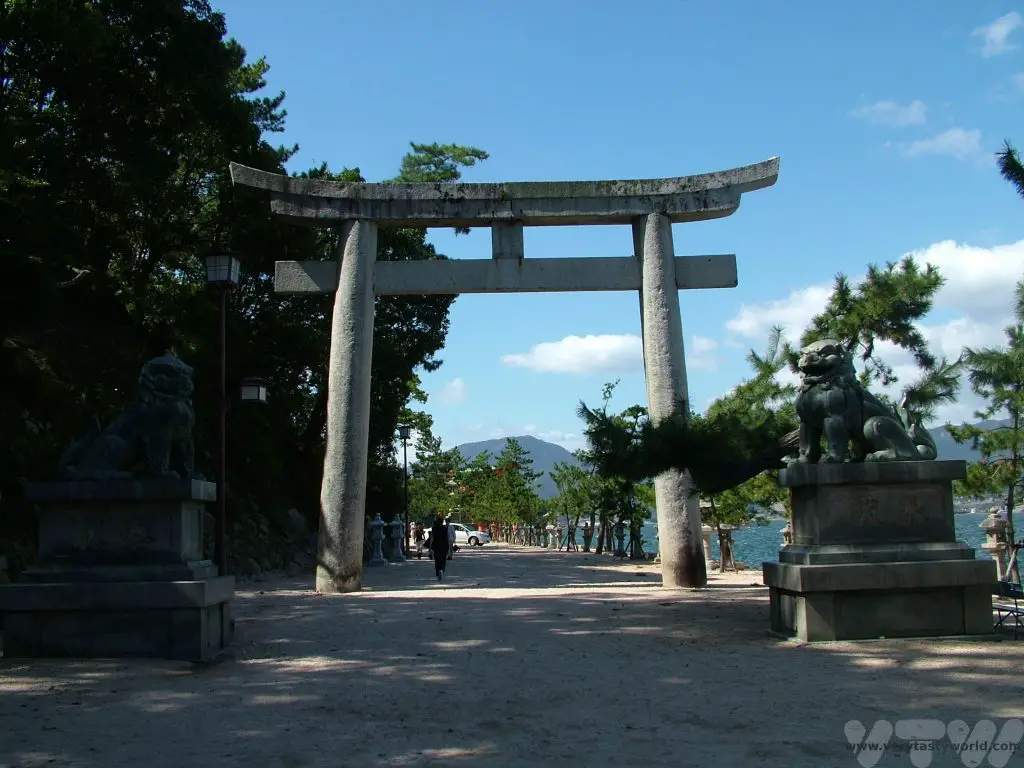
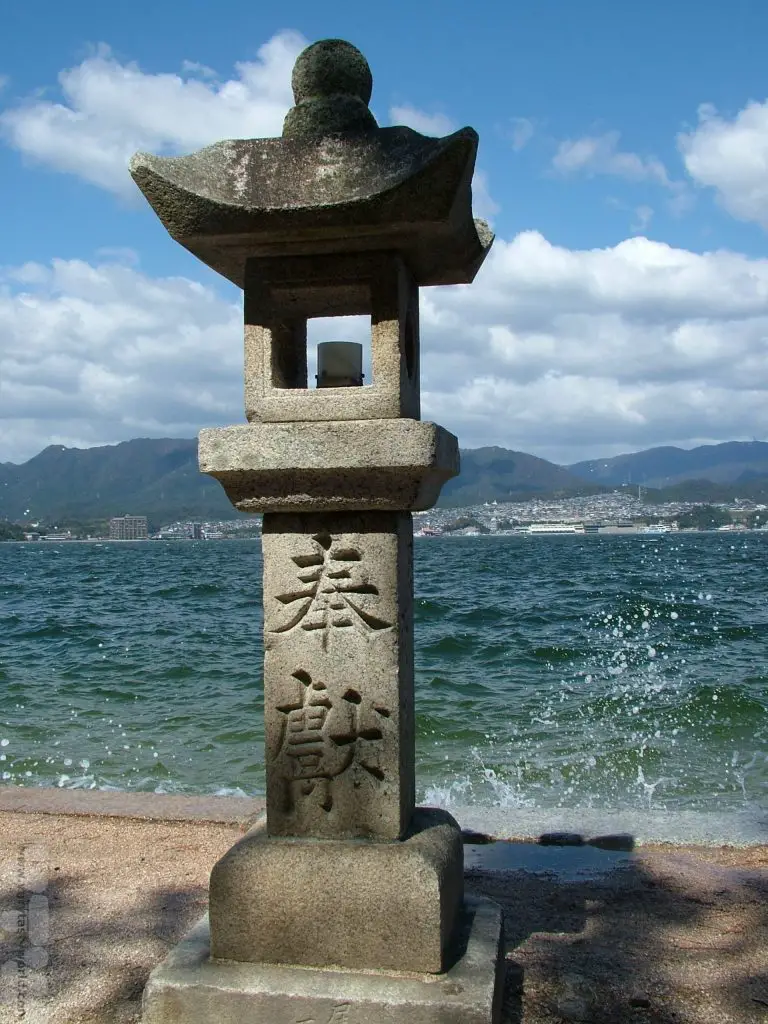
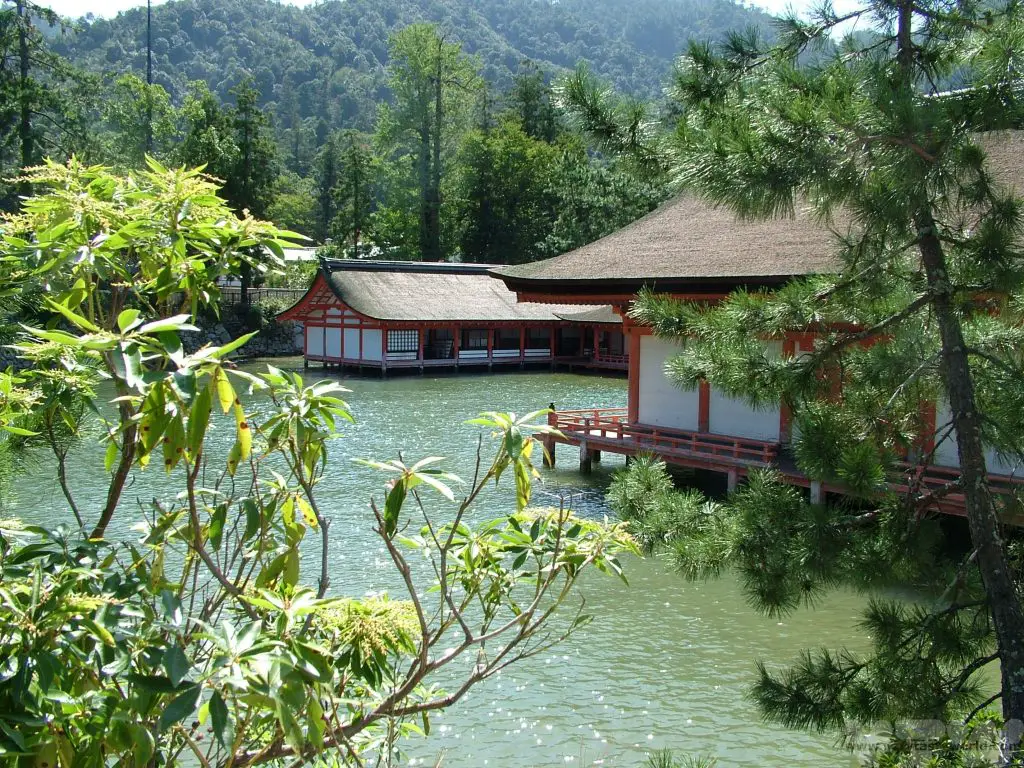
The island is really easy to reach from Hiroshima. You can catch a train and then a ferry to the island on a journey that takes about an hour.
Miyajima is a lovely island, perfect to walk around, especially if you’ve arrived at low tide and need to wait in order to capture that perfect shot of the torii. There are forested walkways to explore and it’s possible to climb up to the island’s highest peak, Mount Misen. If you’re feeling less energetic, there’s a ropeway to take you up to the top.
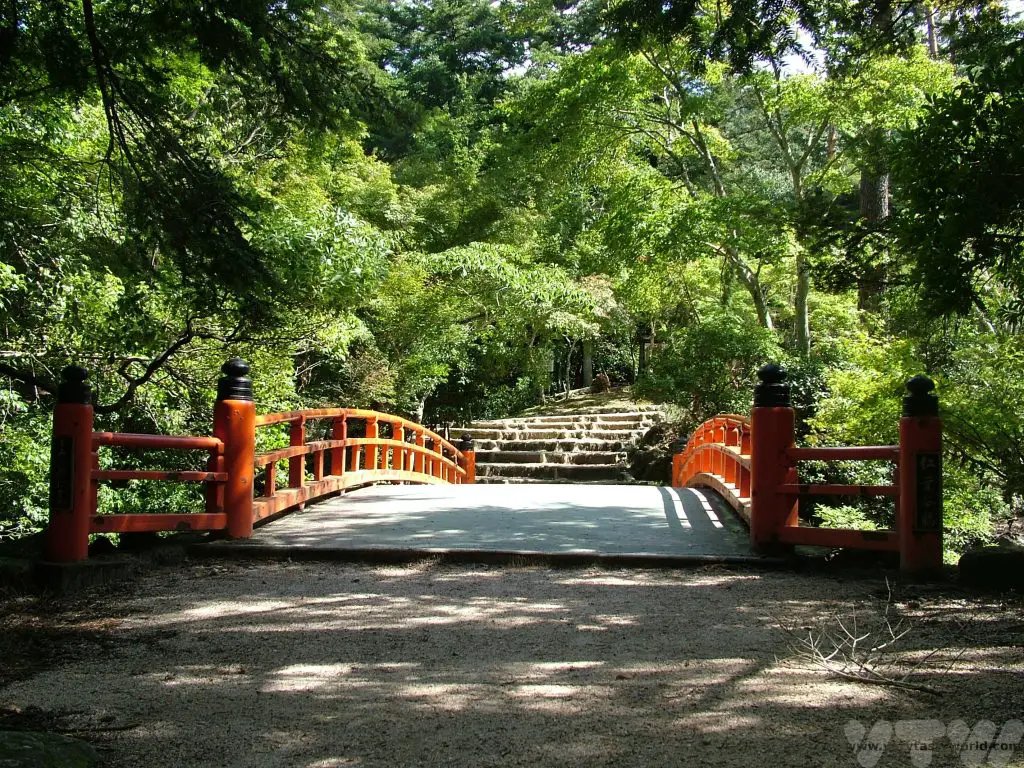
There are also some friendly-ish deer who live on the island. They aren’t as bold as the ones at Nara and, unlike at Nara, you are not allowed to feed them.
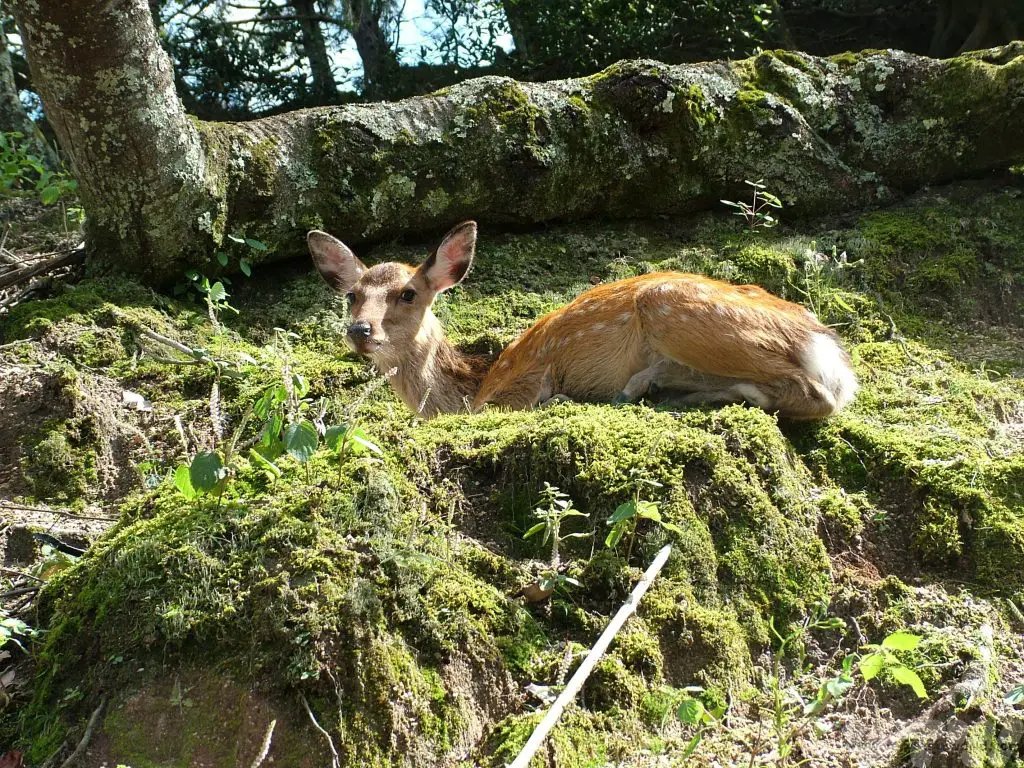
Scenic Japan View Number Two: Matsushima
The next view is that of Matsushima on Japan’s north east coast, which is a short rail journey from the northern city of Sendai, easily accessible from Tokyo via the shinkansen (bullet train).
Matsushima comprises a series of hundreds of forested islands dotted through a bay. It was lucky not to have been too badly impacted by the earthquake and tsunami of 2011, the geography of the bay having some part in protecting the islands.
It is possible to visit some of the islands closest to the mainland by crossing traditional vermillion bridges from the shore.
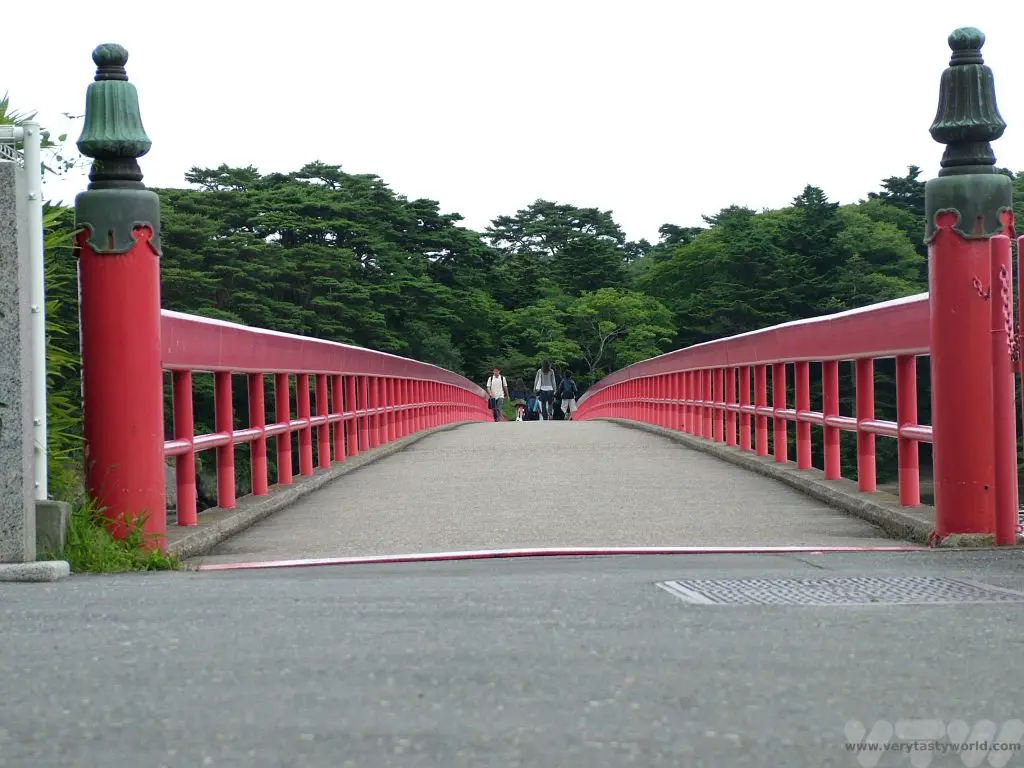
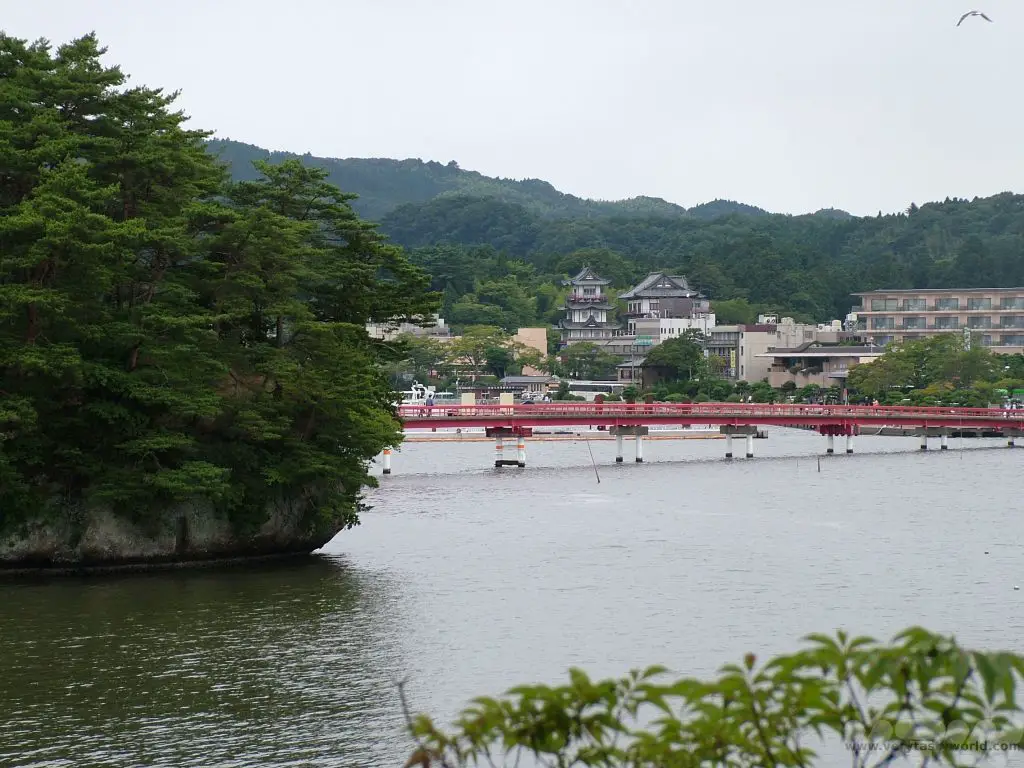
But taking a boat trip across the bay is highly recommended as you will be able to see some of the more remote islands. Beware, though, bird food is available to buy prior to boarding the ship and the seagulls very much know this, so we were followed by flocks of gulls eager to feast upon a tasty snack.


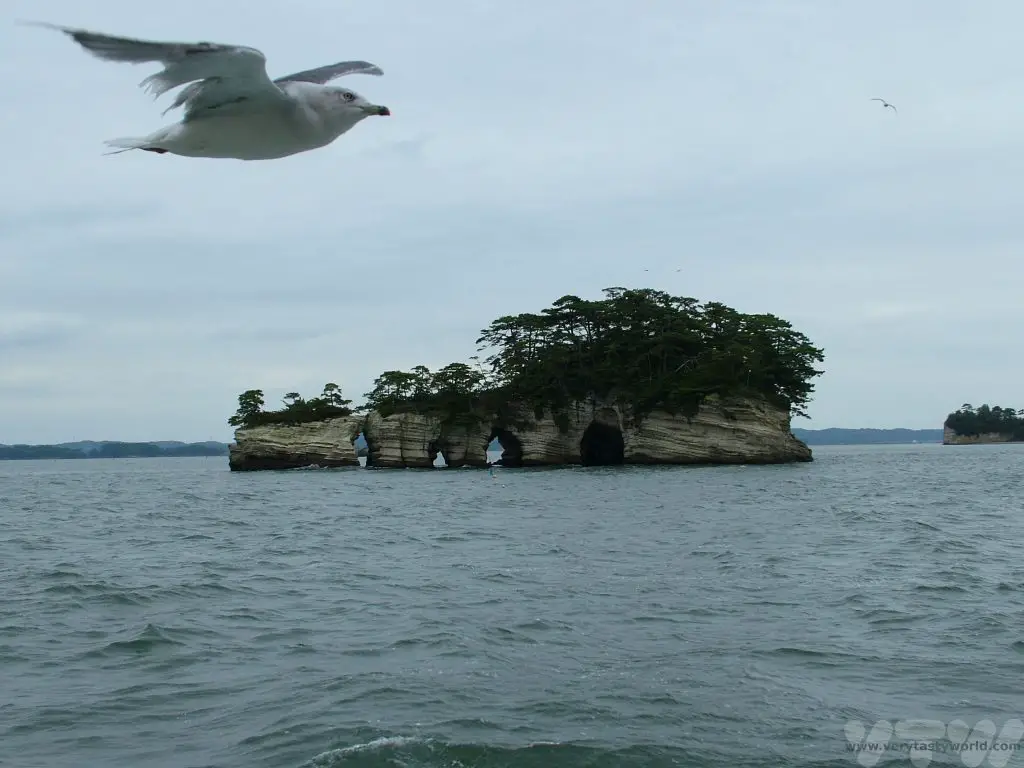
It is reputed that Japan’s most famous poet, Basho, best known in western countries for his haiku, was reportedly so struck by the awesome beauty of Matsushima, that he was lost for words and could only utter, ‘Matsushima, Ah Matsushima, Matsushima,’ to describe his feelings about viewing the area. The story is likely to be apocryphal but the sentiments are appropriate.
The viewing point isn’t near the shore, it’s a walk across the railway tracks and up a hill to a park. The weather wasn’t really on our side on the day of our visit but we had come all this way to see one of Japan’s greatest views, so a rainy trudge wasn’t going to stop us.
In fact, a very kind lady was driving past in her car and stopped to offer us a lift, which we were happy to accept. She knew exactly where we were heading and we exchanged pleasantries about the weather. ‘O-ame,’ (big rain) we declared. She agreed. After she’d dropped us off in the car park we thanked her profusely and wandered through the park to look at the view. This probably isn’t the same view that Basho enjoyed but it was wonderful nevertheless, despite the rain.
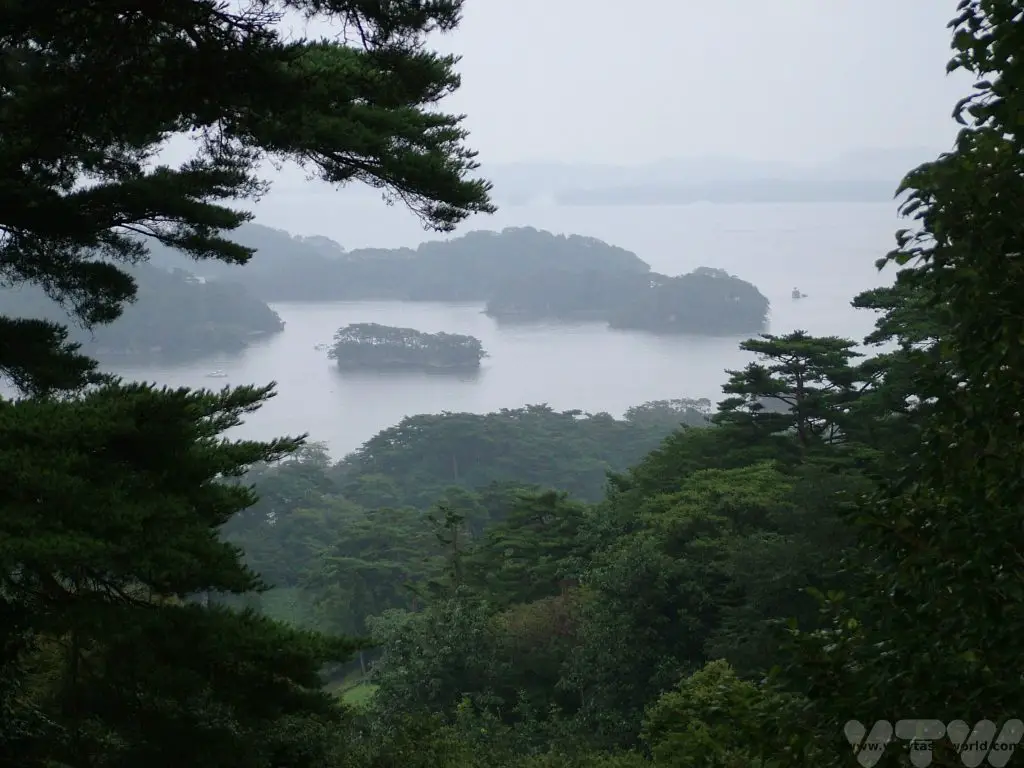
The town is lovely to wander around and there are also some interesting temples to visit.
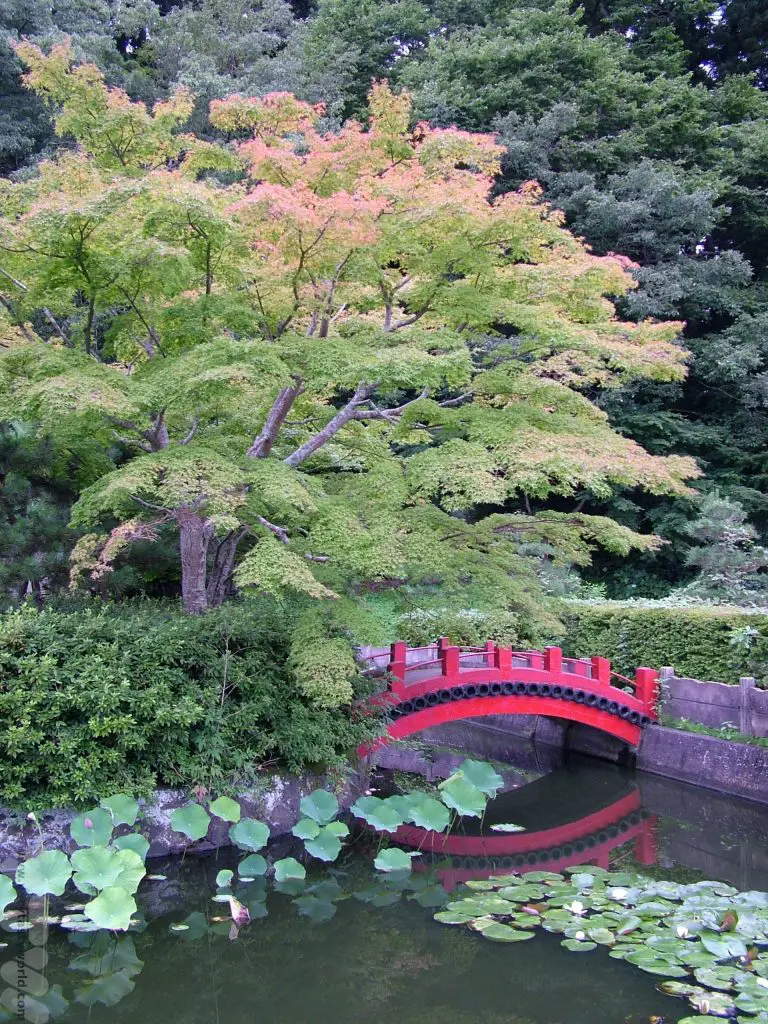
The local foodie specialty is gyu tan – beef tongue. It might not sound very appealing but in fact it’s delicious – it has a very soft texture and is packed full of beef flavour. It’s in the top right of the picture below which shows a set meal that also offered some sushi, miso soup and pickles.
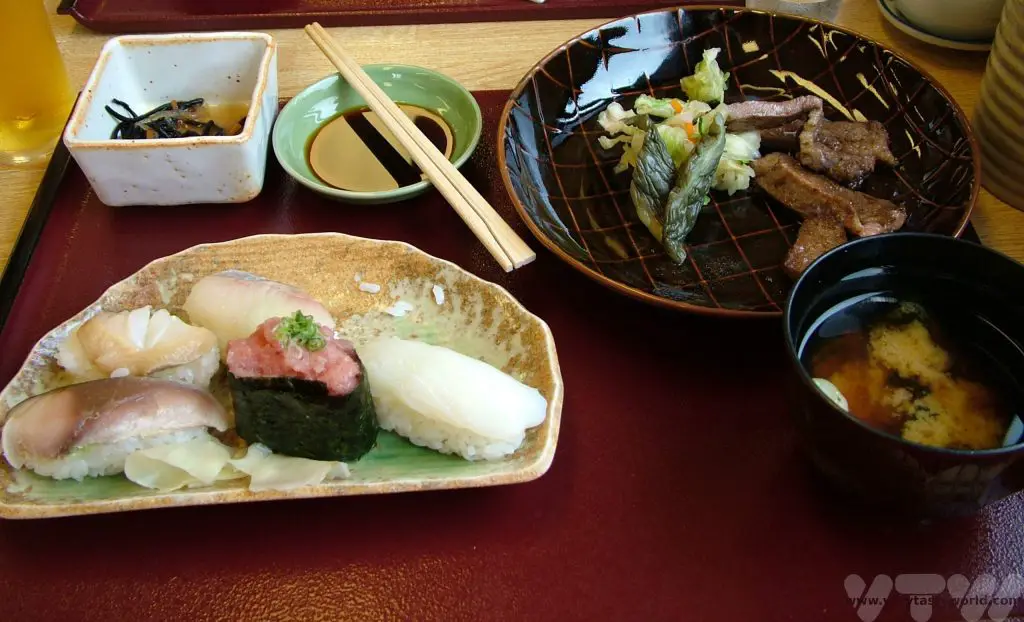
Scenic Japan View Number Three: Amanohashidate
The third view of Japan is a little trickier to reach but it is definitely worth making the journey. You can reach Amanohashidate via a direct train from Kyoto but the journey may be a bit complicated – our train was scheduled to split at a station part way through the journey – fortunately we learned about this prior to the carriages parting and found our way to the right section of the train. The excellent and indispensable hyperdia site will help with journey planning.
Amanohashidate is a sand spit that spans the mouth of the delightful Miyazu bay. The name is a bit of a tongue twister but it translates to something akin to ‘bridge over heaven.’ It is a very pleasant walk from the railway station across the spit to the other side of the bay, a distance of about three and a half kilometres. The sand bar is covered with pine trees that provide shade in the heat of the sun.
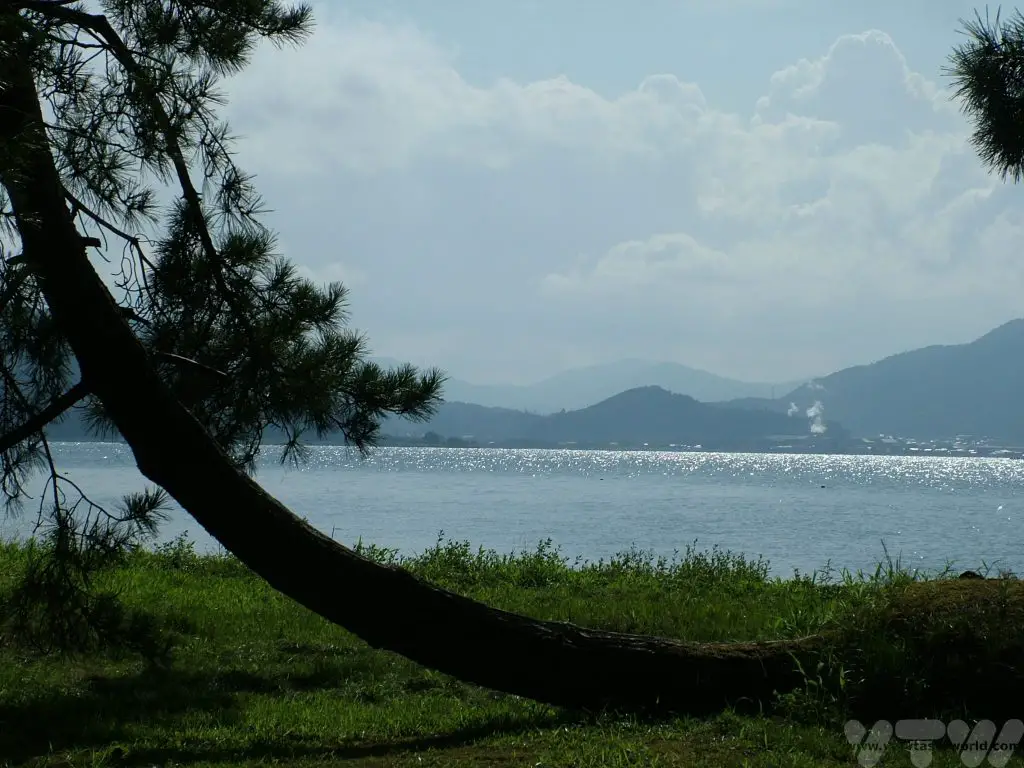
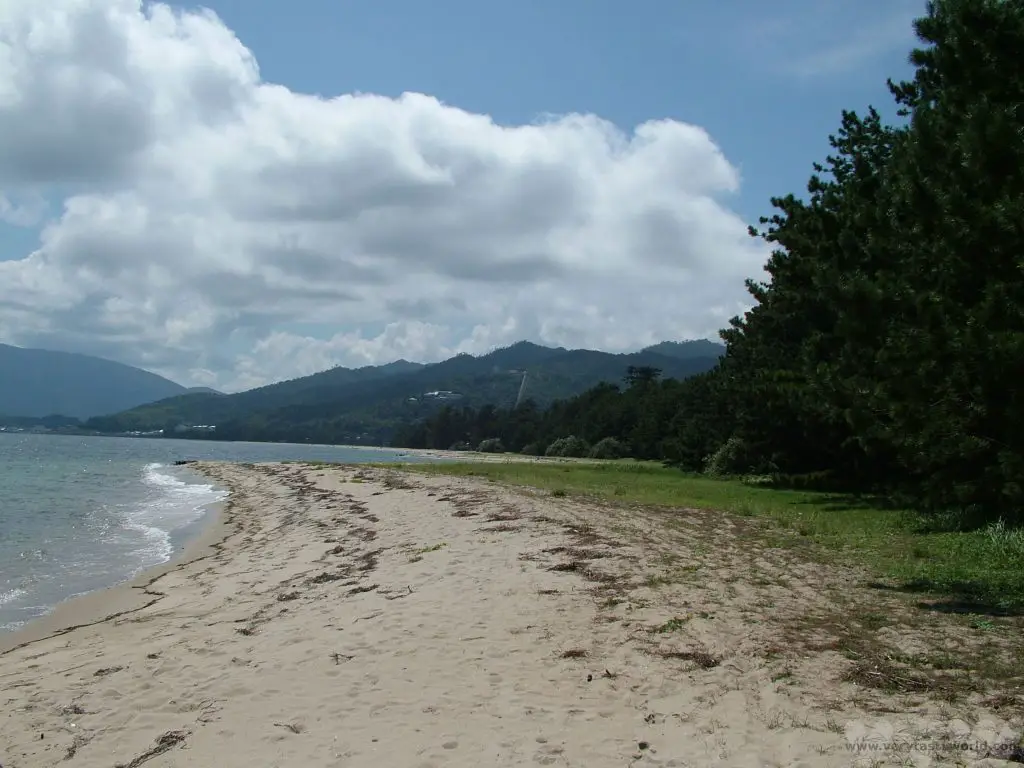
Then you can then wander through the small town of Miyazu to catch a cable car to the viewing point. (This photo shows the downhill run, which obviously has a better view.)
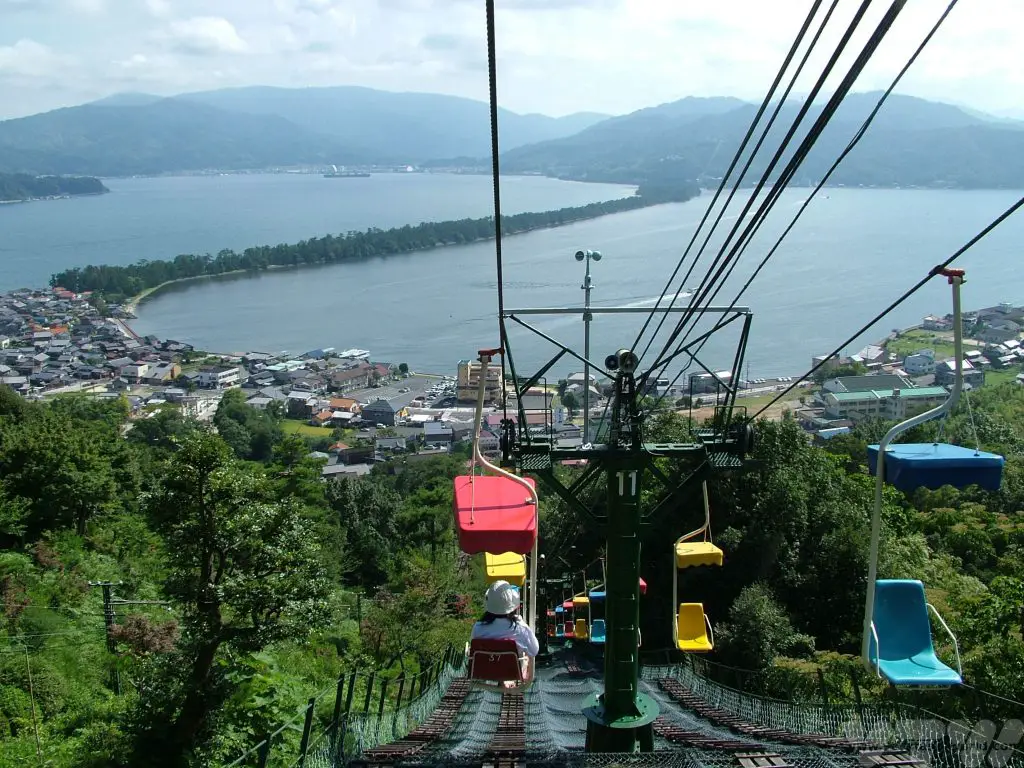
The scenery is wonderful, especially if you are lucky enough to see it on a sunny day.
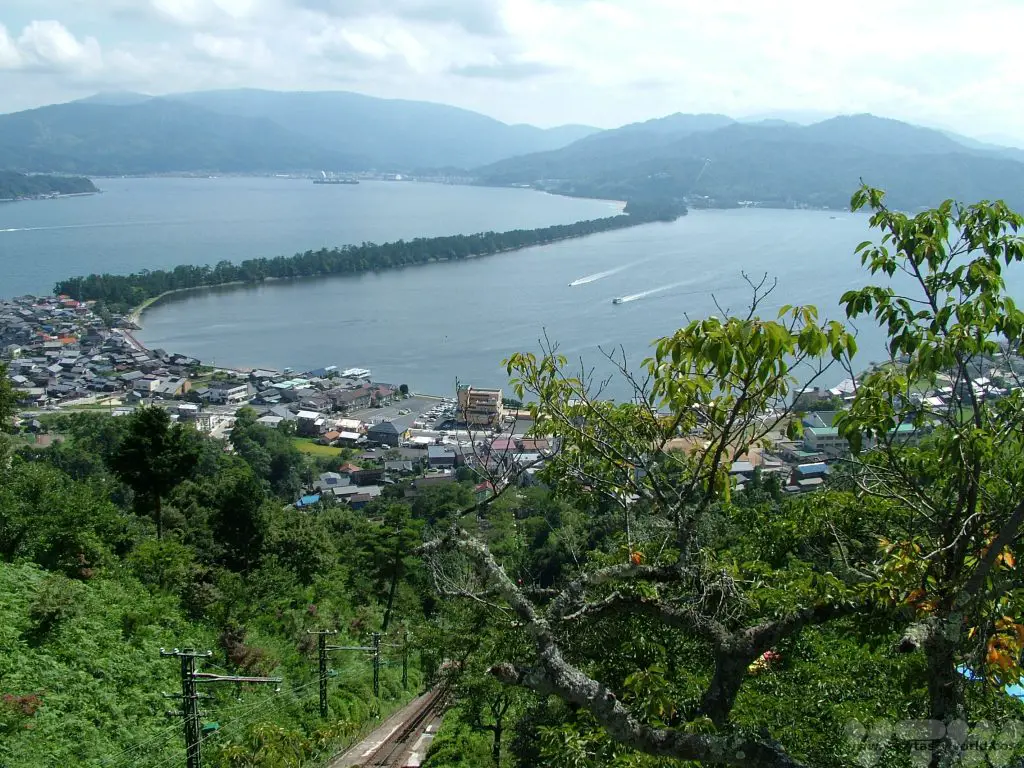
But it’s very important to know that there is a specific technique to maximise your viewing experience. You should bend over and look at the sand spit through your legs – there are special observation points to allow you to do this. The reason for this amusing way of viewing is that an upside-down perspective gives the impression of the bridge floating to heaven.
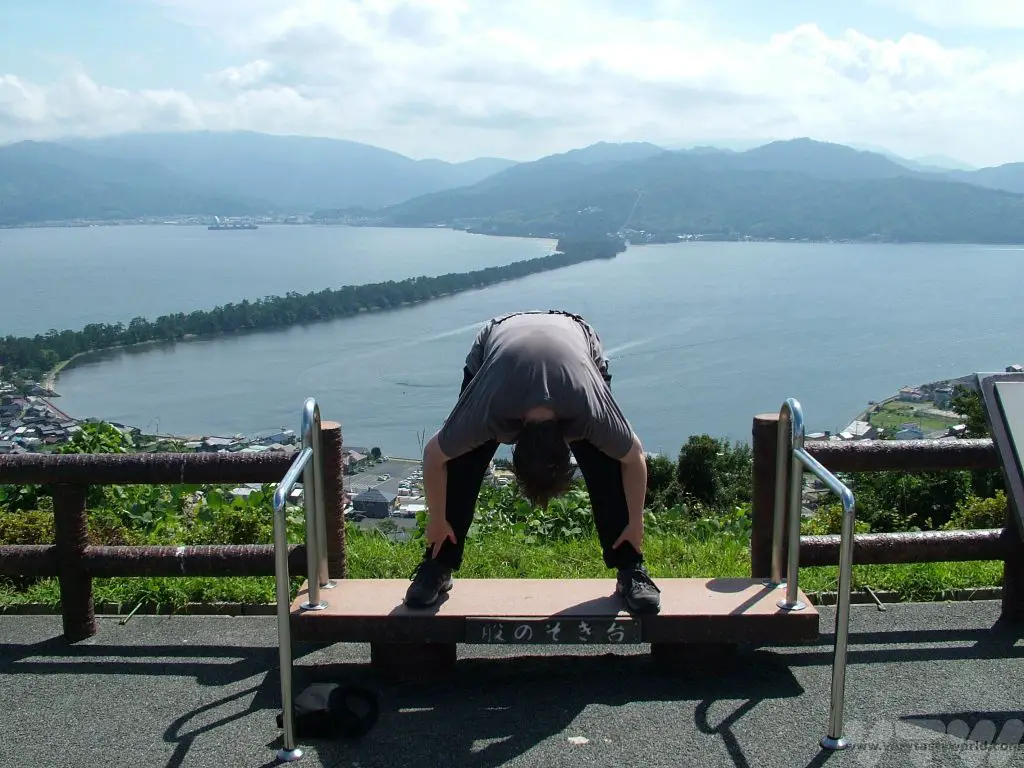
Actually it looks like this.
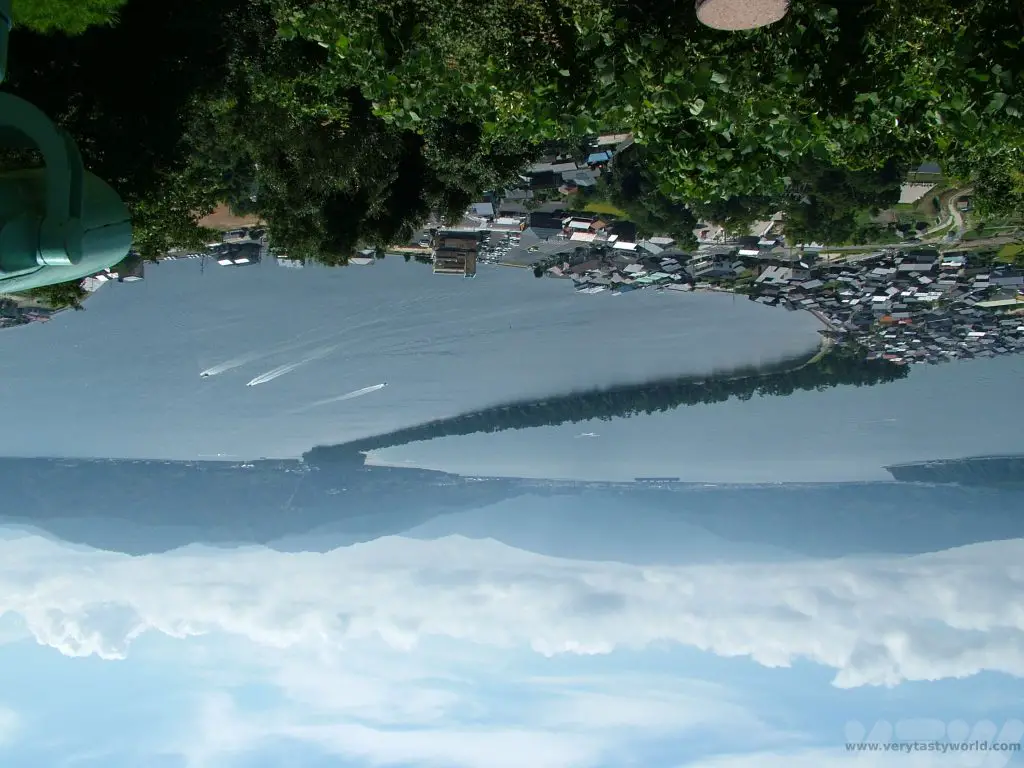
It’s great fun to watch other visitors enjoying themselves – everyone has a good laugh as they bend over to view.
There is a restaurant at the top of the viewing point area. As with most restaurants in Japan, the food is tasty and wholesome. We had chirashi sushi (a rice bowl with prawn, squid, salmon roe and shredded omelette) and udon noodles, accompanied with tempura and washed down with a nice cold beer. All enjoyed with the most delightful backdrop.
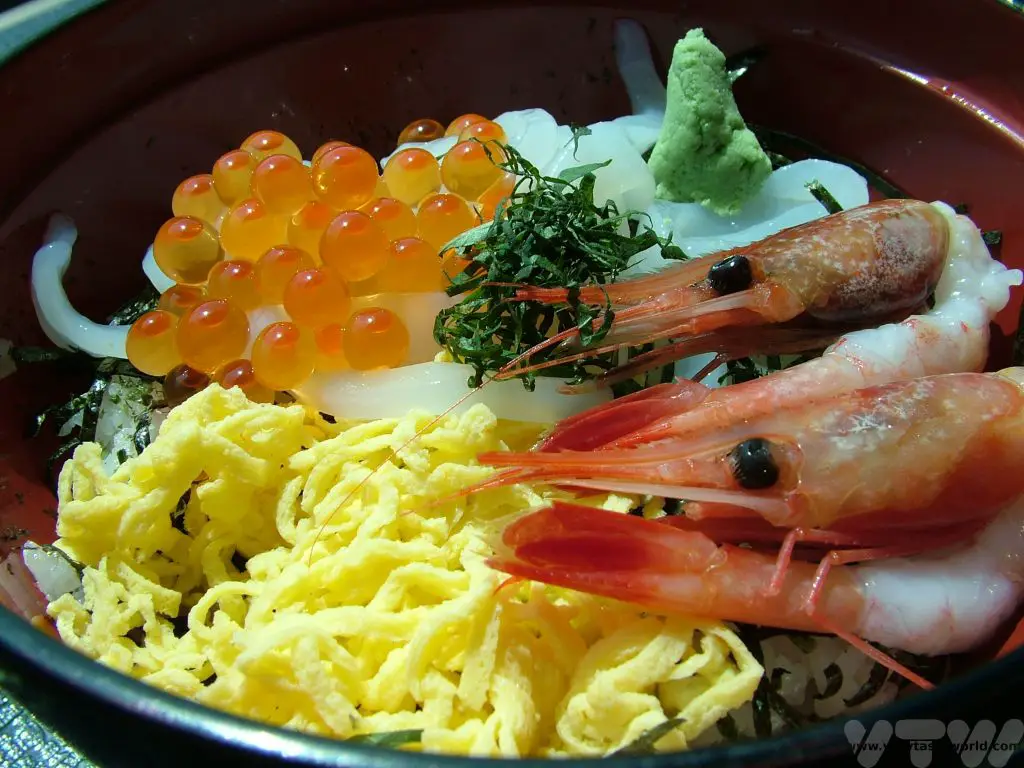
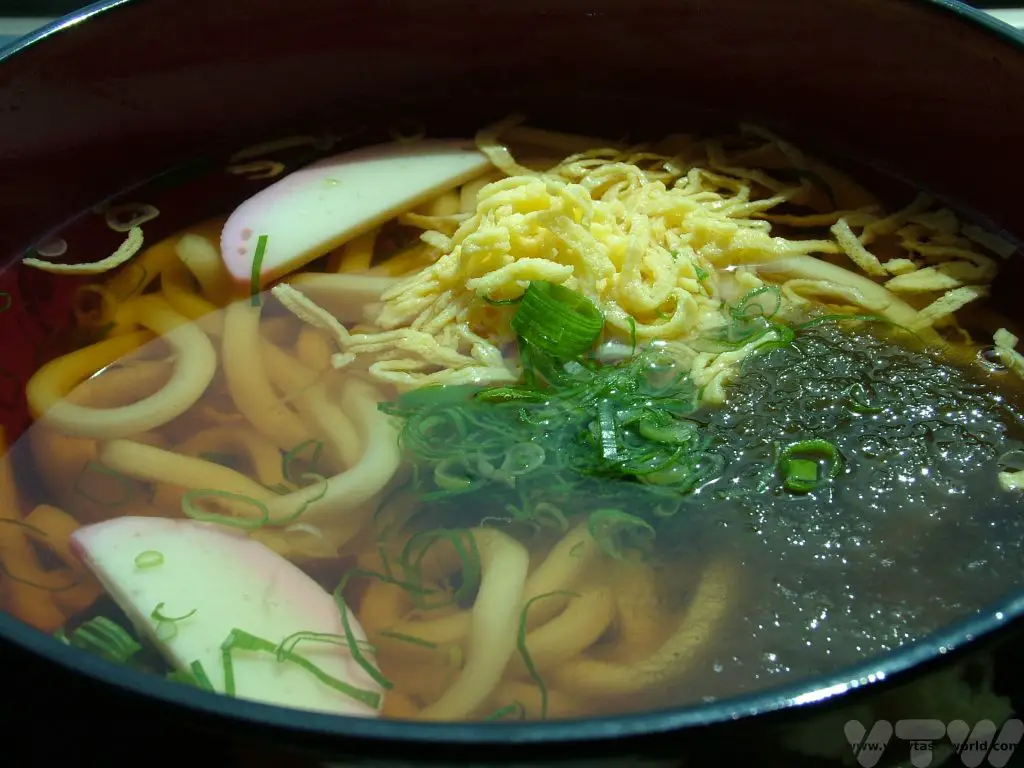
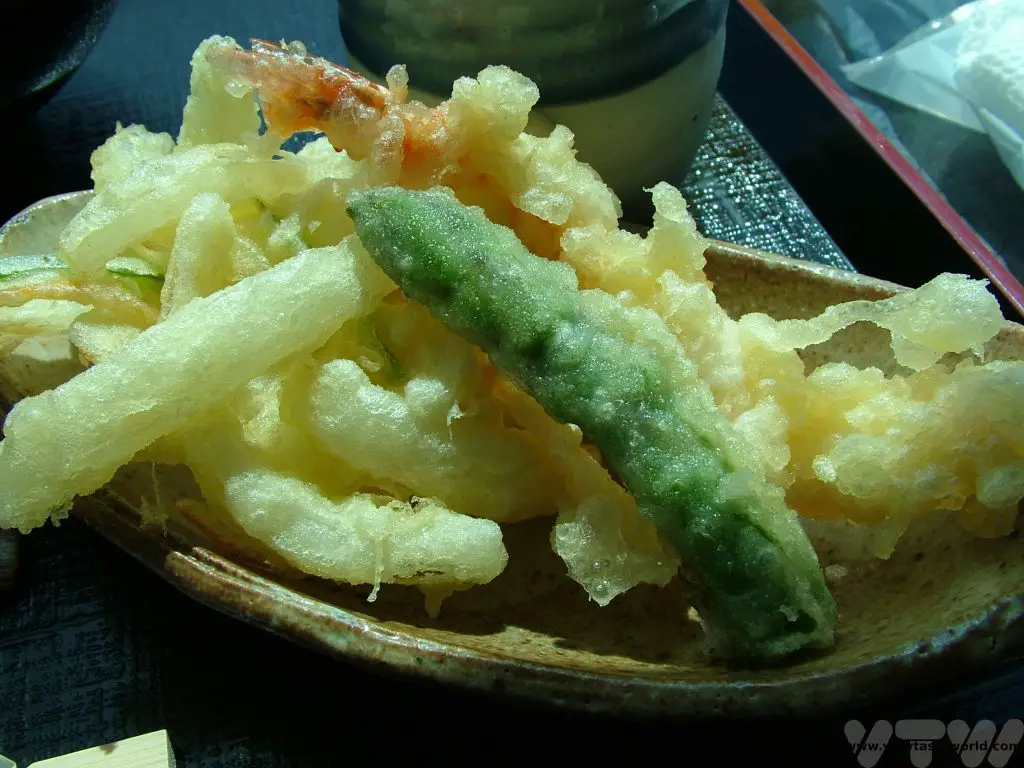
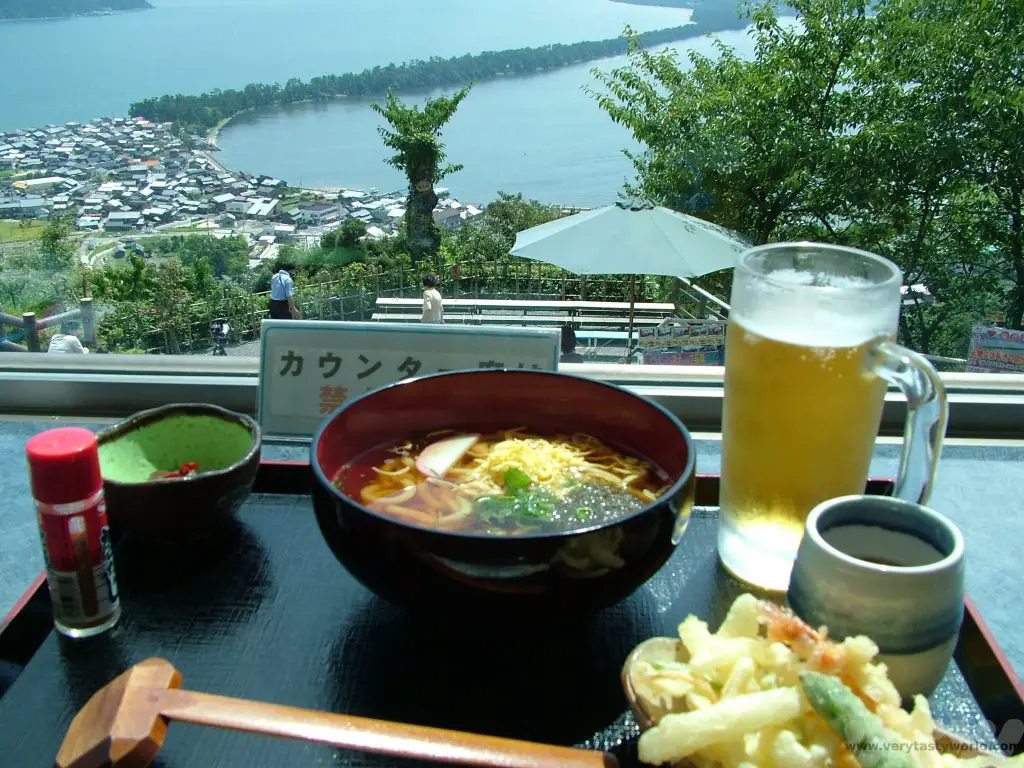
Three amazing places, three spectacular views. But these are the daytime views. Japan also has three night-time views. Actually, there are top three gardens, castles, mountains, sacred sites, hot springs, festivals and many, many more.
But that’s for another time.

- Recipe: Simmered Shiitake Mushrooms

- How to Use Public Transport in Japan

- RECIPE Oyakodon Donburi

- Planning a Trip to Japan

- The Makanai: Cooking for the Maiko House

- Setsubun Food – Bean Throwing Day

- The Gassho Farmhouses of Rural Japan

- Recipe: Japanese Simmered Pork Belly – Buta no Kakuni

- RECIPE: How to Make Umeboshi

Sweet Treats in Candy Alley, Kawagoe, Japan
There are loads of cool and interesting districts to visit that are just a (relatively) short train journey from central Tokyo. Kawagoe is one such place for a day trip. It is just half an hour to one hour’s train ride away, depending on where in Tokyo you are staying, in Saitama prefecture. You can get there directly from Shinjuku on the Seibu line. It’s known as Little Edo because of its old warehouses and merchant homes, called Kurazukuri.
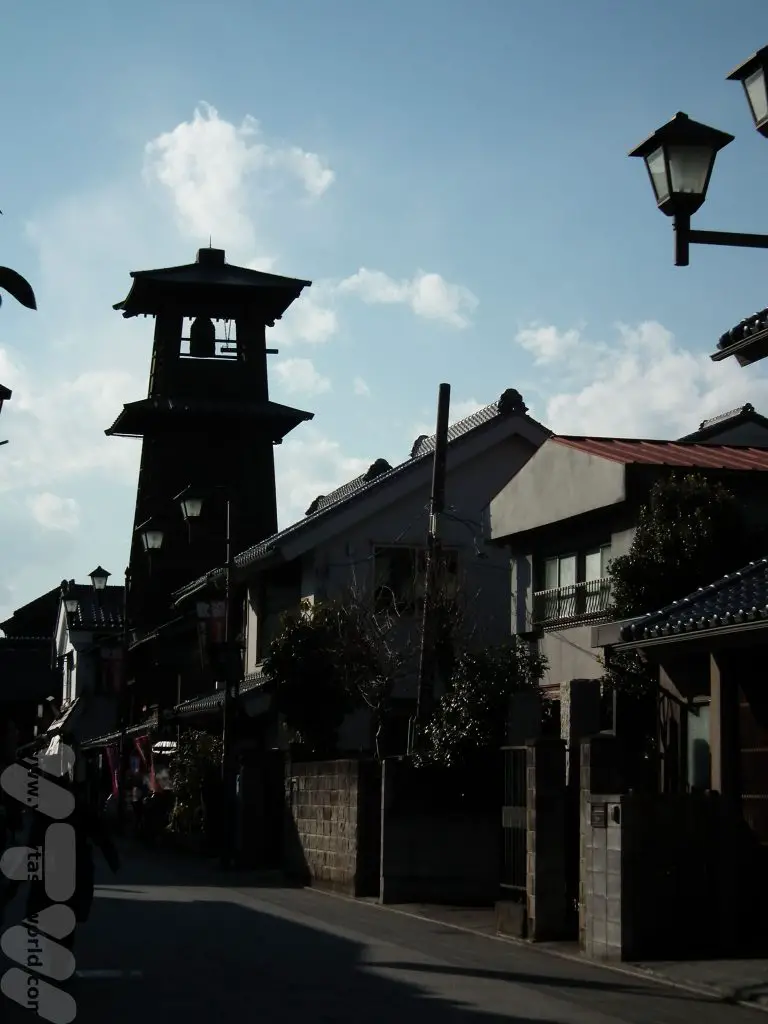
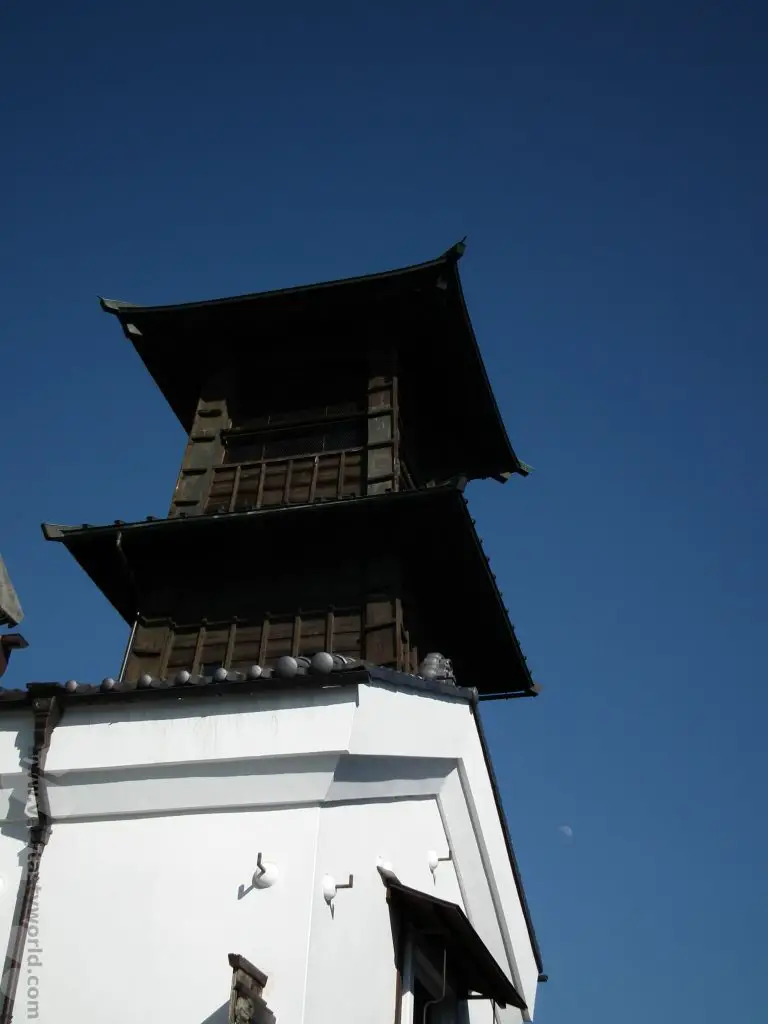
It has a charming old world feel, albeit with lots of shops for tourists, and there are loads of foodie attractions and restaurants to look out for; charcoal boiled eel in a sweet soy sauce is a speciality here, as are sweet potato dishes.
One of the attractions in Kawagoe is Kashiya Yokocho – Candy Alley – a street chock full of traditional Japanese shops offering sweet temptations.
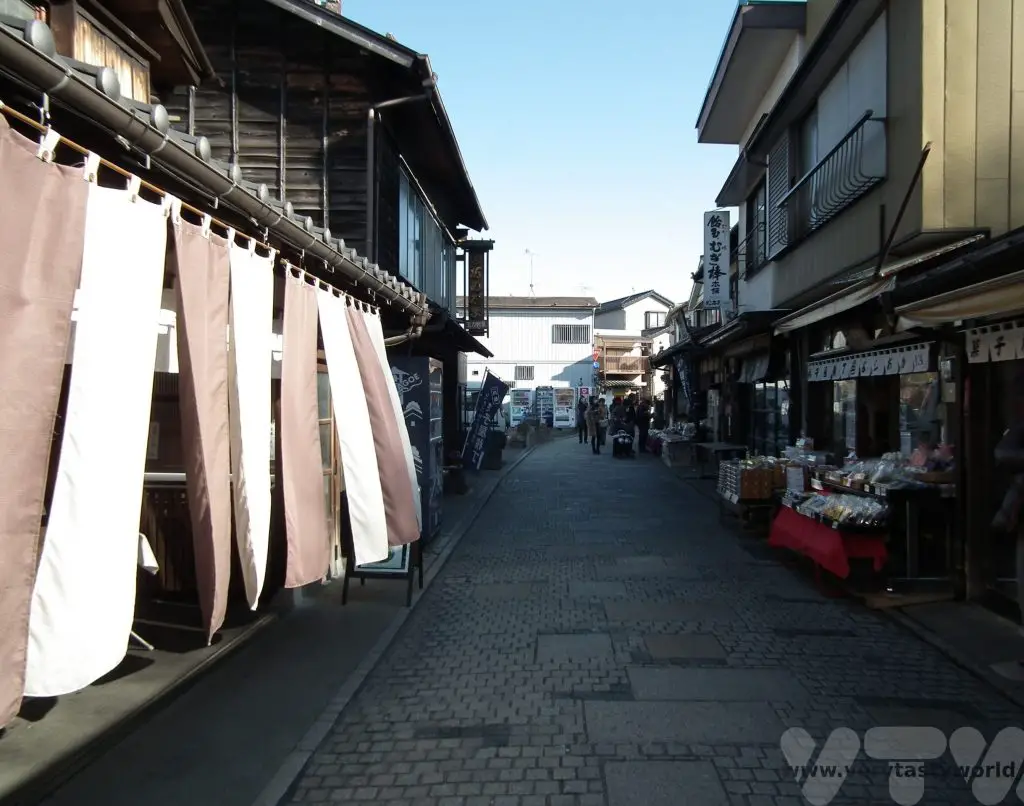
This emporium had a giant penguin minding the store.
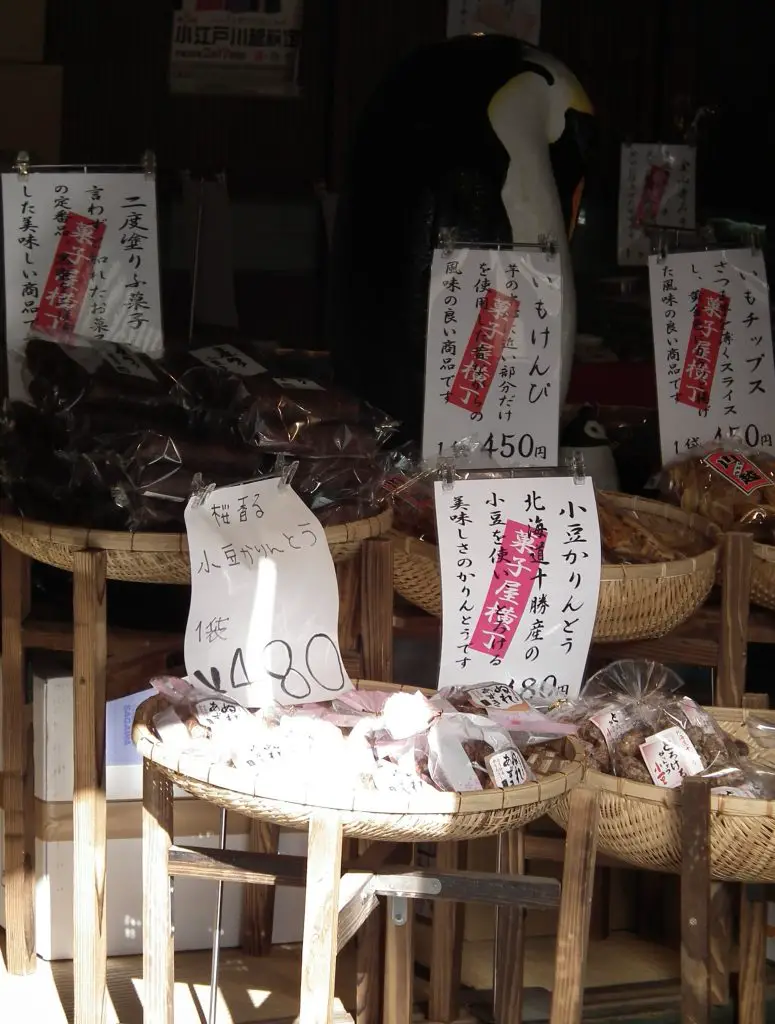
The Kawagoe tourism website has a brief history of the alley:
It is said that the beginning of this Kashiya Yokocho was in the early Meiji Period when Suzuki Tozaemon started to make candy in this prospering town in front of Yojuin Temple. In 1923, after Tokyo was damaged in the Great Kanto Earthquake, this area became the main producer and supplier of candy. There were more than 70 shops in the early Showa Period but due to the war and changes in lifestyle the number has decreased.
If you don’t have a sweet tooth, no problem. There are plenty of savoury snacks on offer as well. Takosen is takoyaki (deep fried octopus balls) sandwiched between prawn crackers.
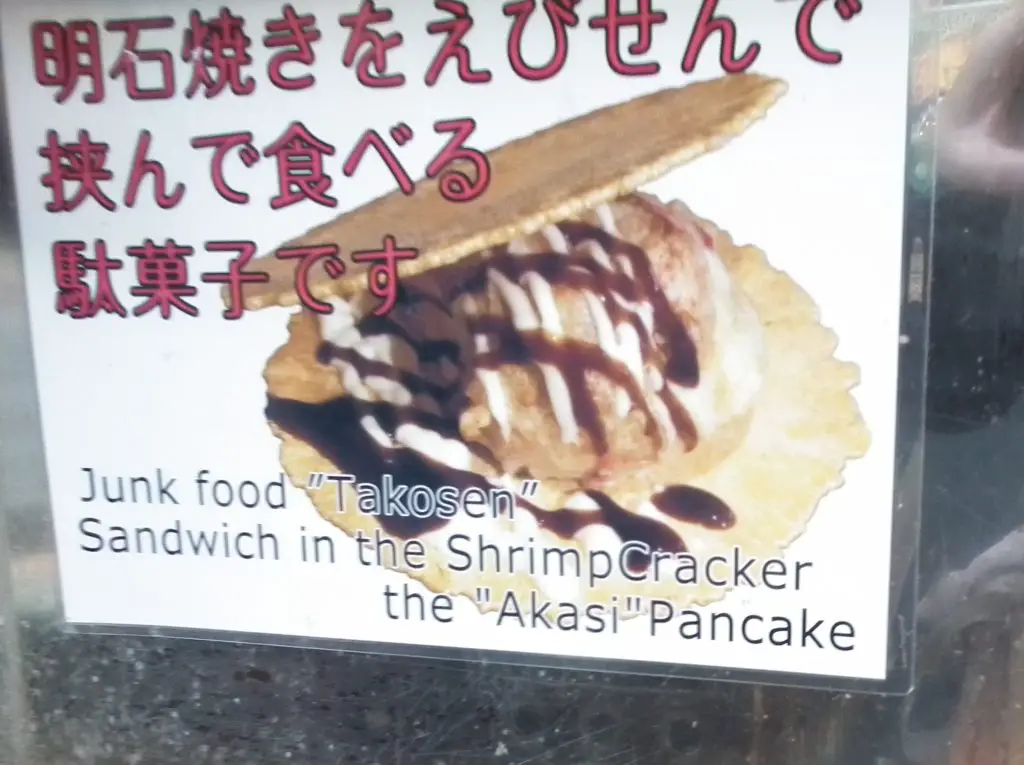
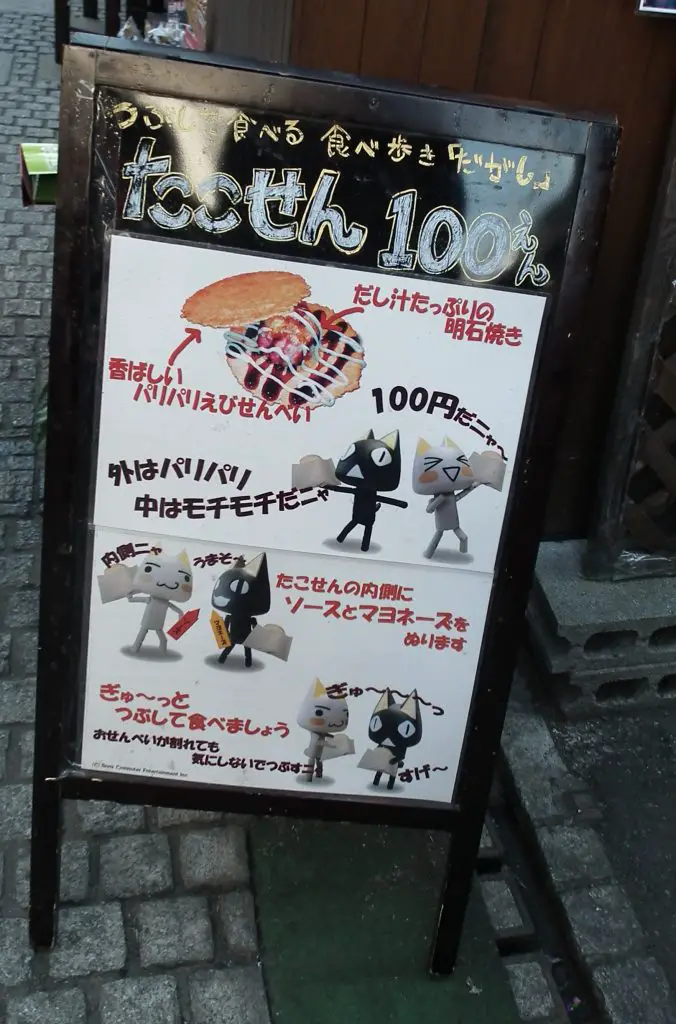
The name combines tako (octopus) with senbei (cracker) and advertises itself as junk food. It is seriously good.
Sweet potatoes are particularly popular, in fact Kawagoe is known colloquially as the city of sweet potatoes. Once considered a staple after the war, when food was scarce, the city still makes multiple products from these tasty tubers.

And if you’re given a photo opportunity to pose as a sweet potato you have to take it, don’t you?
Imo senbei snacks are thinly sliced, dried sweet potato crackers sprinkled sparsely and randomly with black sesame seeds.
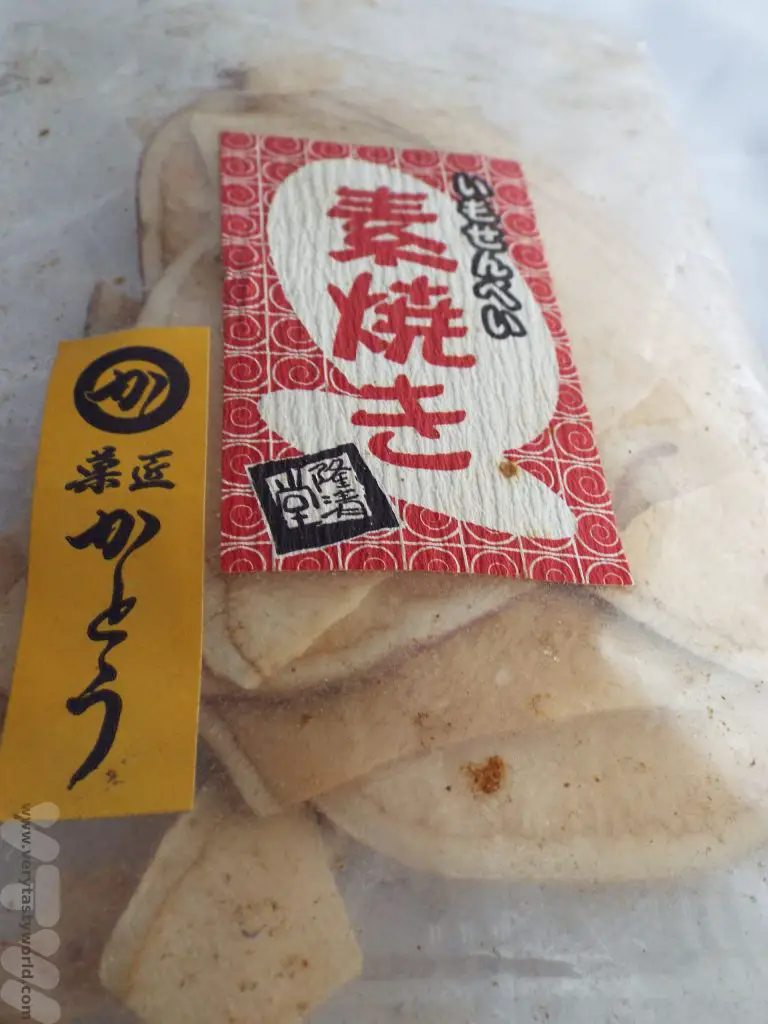
The curious thing about these is that you would expect them to be either sweet or slightly salty and they are neither. They are not bland, but rely on the natural sweetness of the sweet potato and have just a hint of sesame for additional flavour. They have a lovely crunchy texture and are great to eat as an accompaniment to a cool beer.
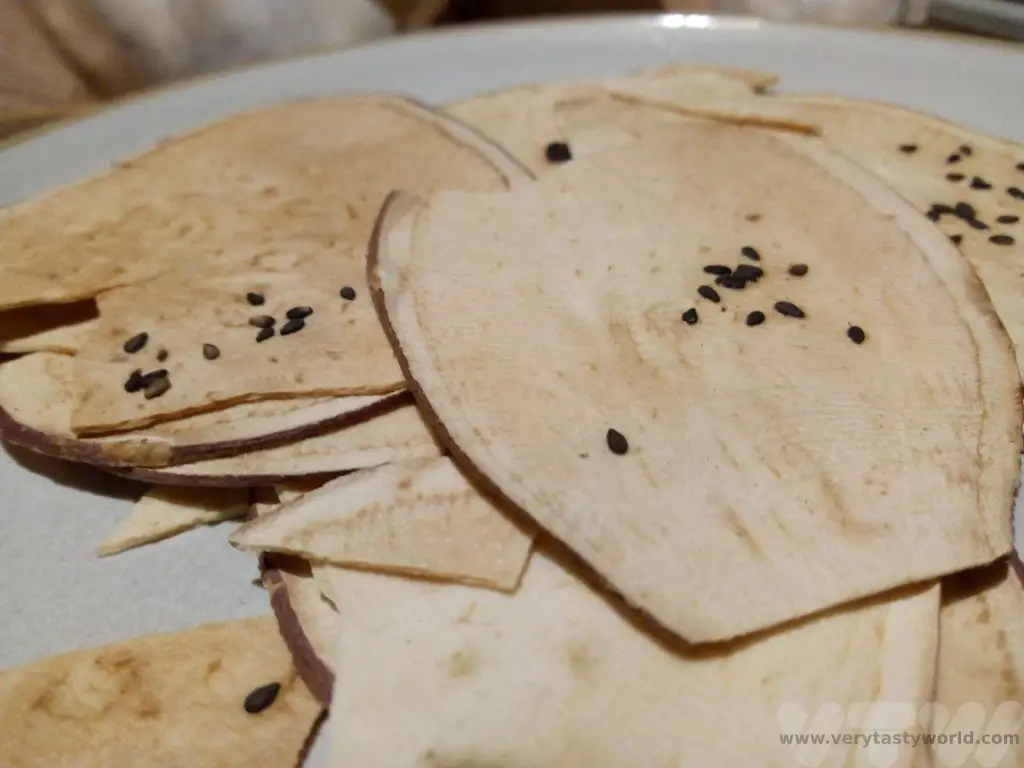
They are also very thin and lightweight – so they are ideal for slipping into your suitcase as an omiyage (a souvenir/gift) for your friends. Or you could just keep them and scoff them yourself when you get home!

- Recipe: Simmered Shiitake Mushrooms

- How to Use Public Transport in Japan

- RECIPE Oyakodon Donburi

- Planning a Trip to Japan

- The Makanai: Cooking for the Maiko House

- Setsubun Food – Bean Throwing Day

- The Gassho Farmhouses of Rural Japan

- Recipe: Japanese Simmered Pork Belly – Buta no Kakuni

- RECIPE: How to Make Umeboshi

A Day Trip Around Lake Akan Hokkaido
Japan’s northernmost main island of Hokkaido is a nature-lover’s paradise. To the east of the island, just north of the city of Kushiro is the Akan National Park, named for the beautiful lake in the region. We spent a day in the Lake Akan Hokkaido park area. You need transportation to get around this area as many of the attractions are some distance apart.
Eastern Hokkaido is a popular holiday region and because of the volcanic activity there are plenty of onsen – hot springs resorts. Lake Akan itself was formed inside a caldera when lava cooled and formed a dam 6000 years ago. It’s a large lake of around 14 square kilometres and is known for its clear water. There are all sorts of activities in the area, including boat trips across the lake.
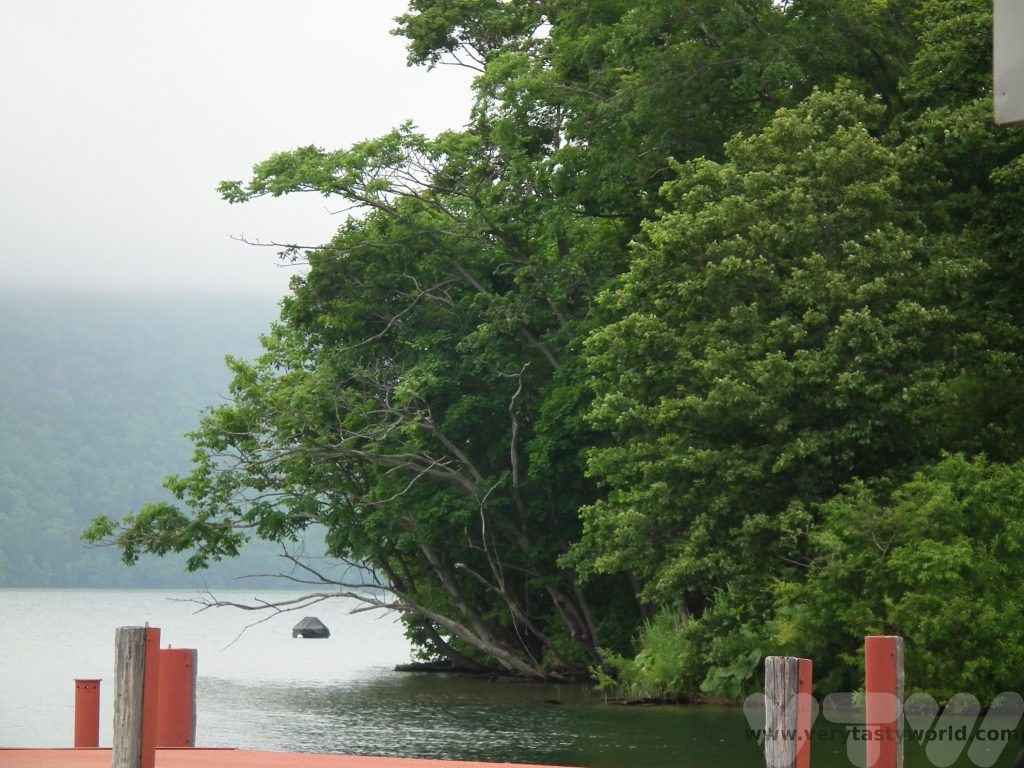
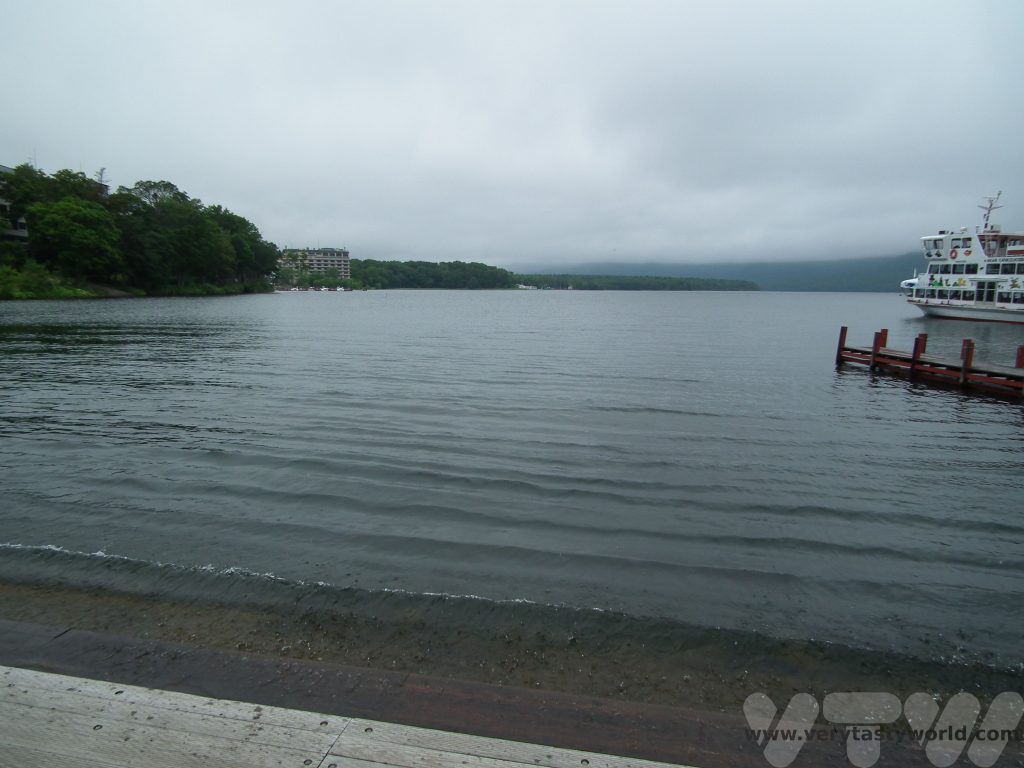
There is a very pretty waterfall close by.
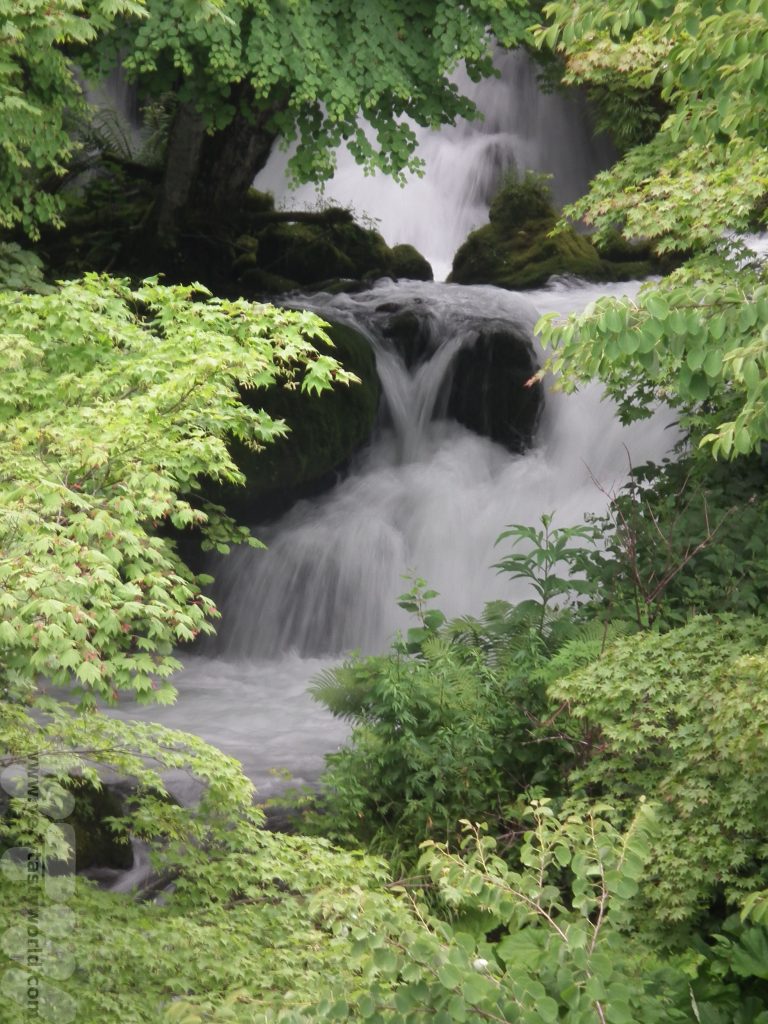
Akan is not the only lake in the national park. Lake Mashu is also renowned for its beautiful clear water. That’s if you can see it. Unfortunately we visited on a particularly vile day – when we arrived it was raining and misty and there was no view of the prestigious lake to be seen. Hey ho. Can’t help the weather. This is what it looks like on a sunny day.
We did manage to see the sign though.
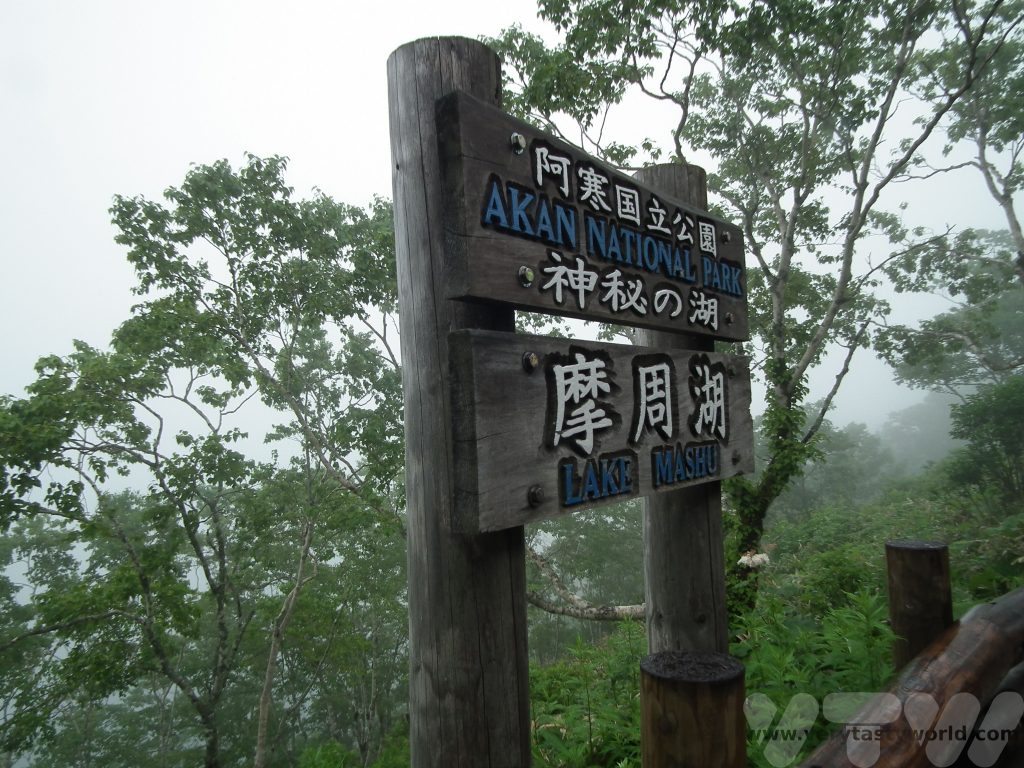
To make up for the lack of view, we decided that lunch would be a good option. The region specialises in soba noodles.
Mashu soba is made from buckwheat noodles. The noodles are made that morning, so are really fresh. They are cooked, rinsed in cold water and then served on a bamboo mat. Pick them up with chopsticks, dip into a savoury, refreshing dipping sauce and devour. Wasabi and negi (like spring onions) are available to add an extra dimension of heat and crunch. And don’t forget, it’s perfectly acceptable to slurp your noodles.
If you’re hungry you can eat mashu soba as part of a set meal. Vegetable and prawn tempura, miso soup, pickles and a cup of green tea make for a veritable feast.
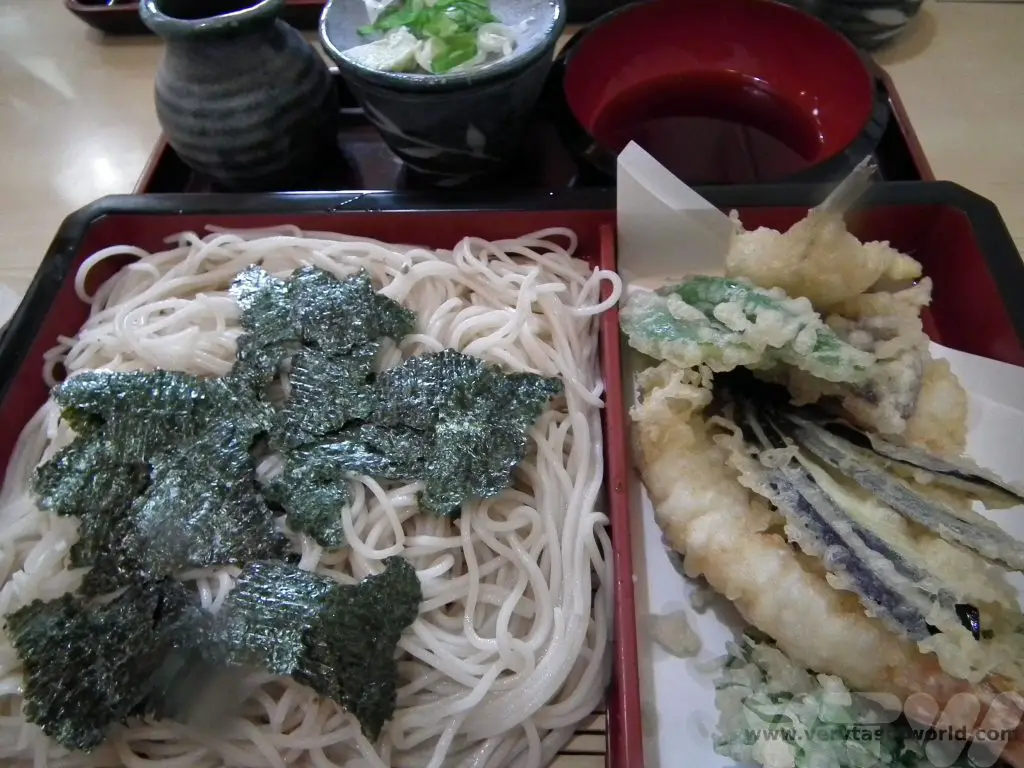
You might think that cold noodles on a rainy day might not be the best combination for maximum enjoyment but actually it works. Especially if your next stop is to a hot spring foot spa. Simply dip your toes in the hot water and ignore the rain… (we’ll spare you the pictures of our feet in the water).
There are also some other interesting places to visit in the area.
The Iozan volcano area (Iozan literally means ‘sulphur mountain’), with its gloriously yellow sulphur deposits and eye-watering smells if you get too close. You are free to walk around on the footpaths, although areas are off limits for safety reasons. You can also buy eggs cooked using the natural heat of the mountain at the visitor centre.
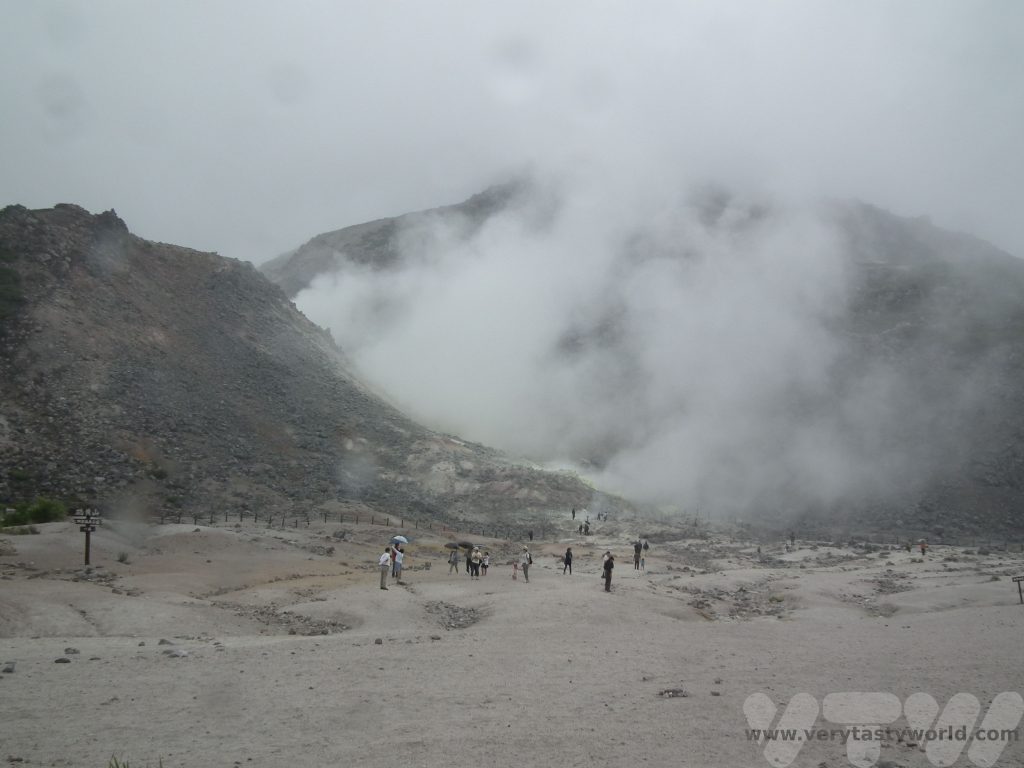
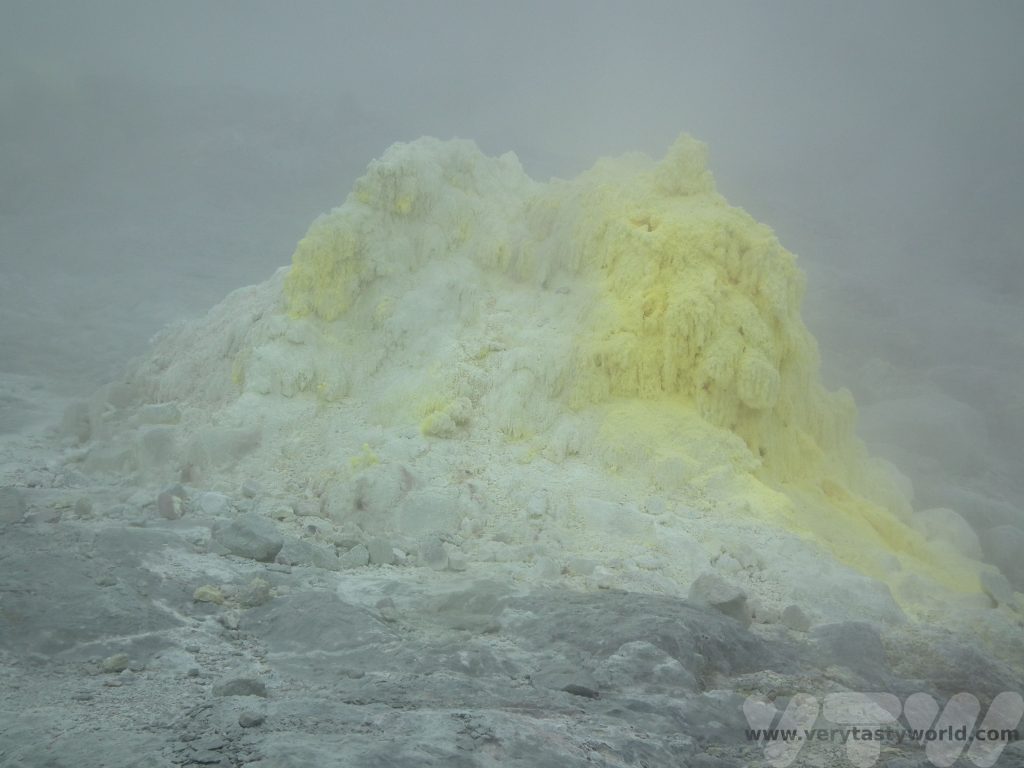
The Kushiro wetlands.
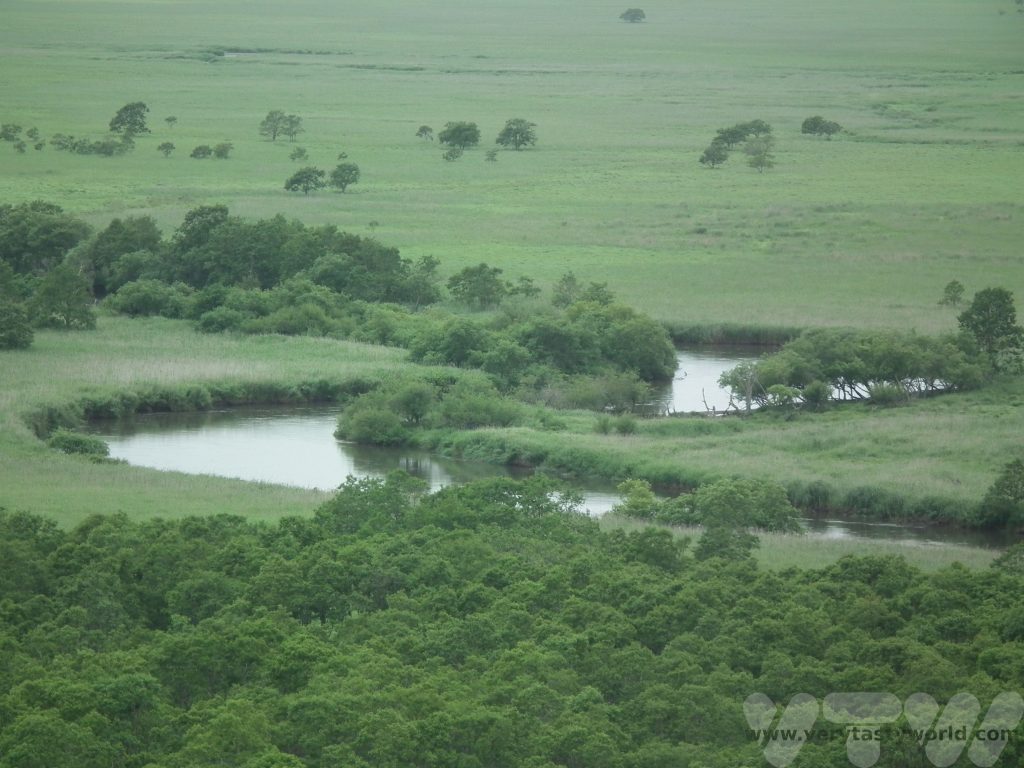
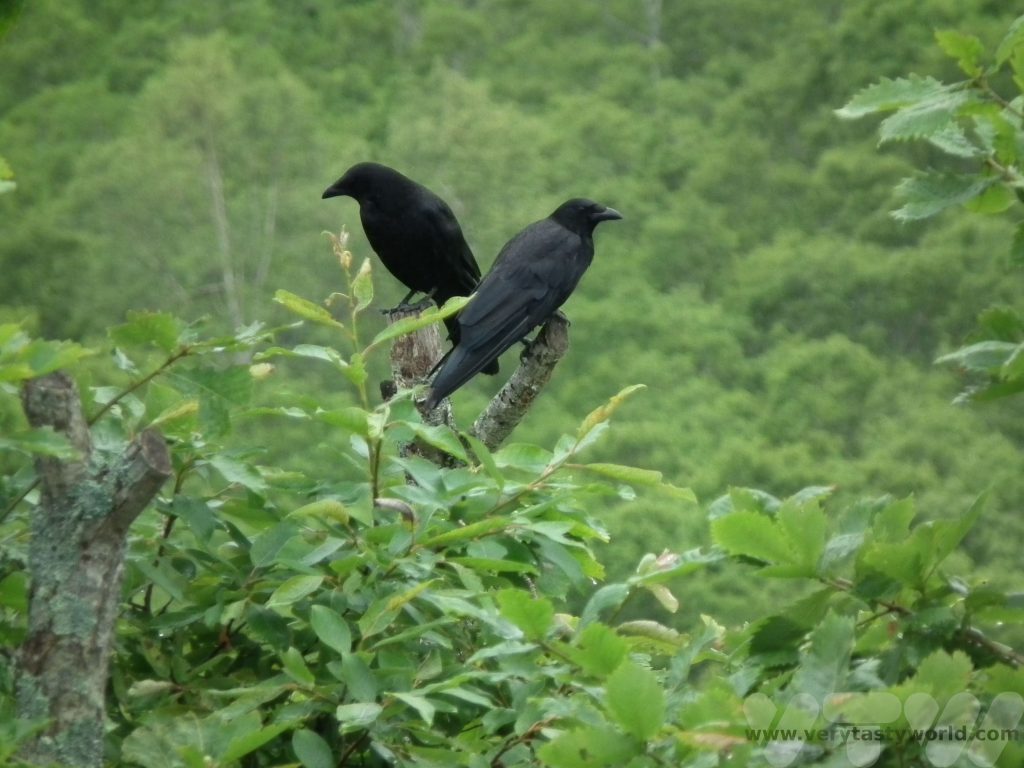
And the Akan International Crane Sanctuary. The red crowned cranes are amongst the rarest cranes in the world but many reside on the eastern side of Hokkaido. They are best known for their courtship dancing ritual, especially during winter. The sanctuary provides a feeding station for wild crane visitors but also homes a number of captive cranes in a natural environment.


- Recipe: Simmered Shiitake Mushrooms

- How to Use Public Transport in Japan

- RECIPE Oyakodon Donburi

- Planning a Trip to Japan

- The Makanai: Cooking for the Maiko House

- Setsubun Food – Bean Throwing Day

- The Gassho Farmhouses of Rural Japan

- Recipe: Japanese Simmered Pork Belly – Buta no Kakuni

- RECIPE: How to Make Umeboshi

Hokkaido’s Red Crowned Crane ‘Eggs’
Hokkaido’s red crowned cranes reside on Japan’s northern – and second largest – island, are so famous that they feature on the country’s banknotes and as the logo for Japan Airlines. Half of the world’s population of these distinctive and beautiful birds, amongst the rarest cranes in the world, reside on the eastern part of the island. The cranes mate for life and are known for their ‘dancing’ together as part of their courtship ritual. Many red crowned cranes are migratory but the ones that reside in Hokkaido are resident all year round.
It isn’t always possible to see wild cranes – wildlife being wildlife can be somewhat elusive – but the Akan International Crane Sanctuary is located close to the town of Kushiro and offers the opportunity to see these marvellous birds up close. It can be enjoyed as part of a day trip visiting the beautiful countryside surrounding the town.
Kushiro is the last stop on the line. If you’re using your JR Pass and travelling from Sapporo, the train has a logo at the front that is highly appropriate.
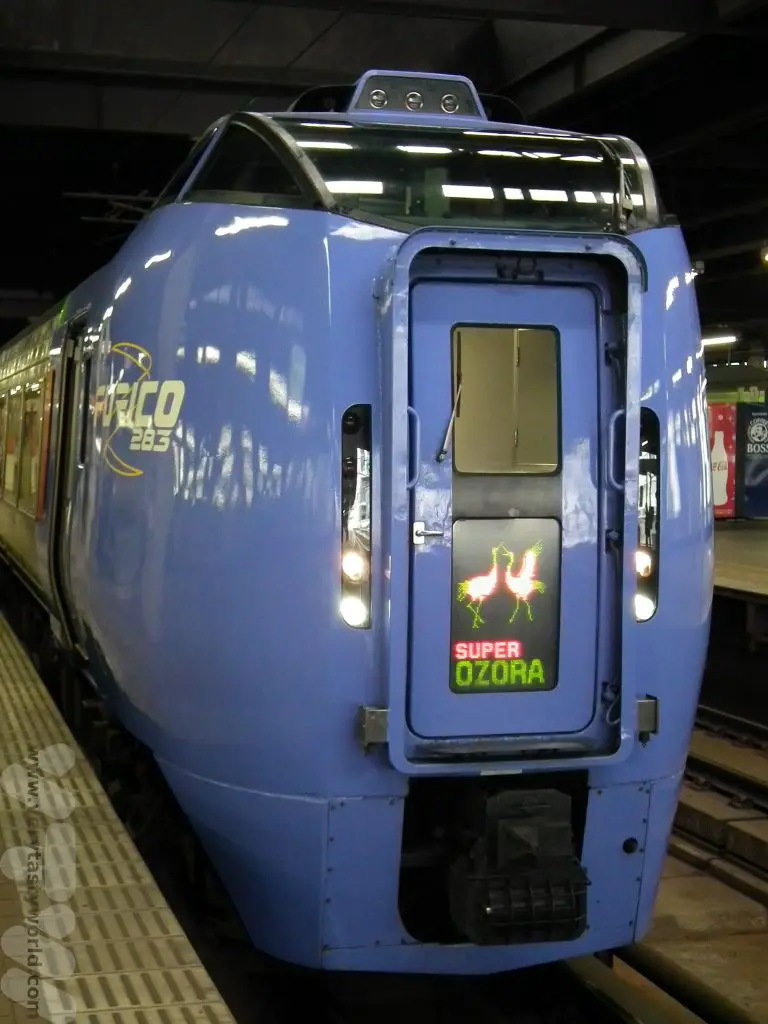
The sanctuary has information about its work which is mostly in Japanese but, like a lot of Japanese information, it uses plenty of graphics as well.
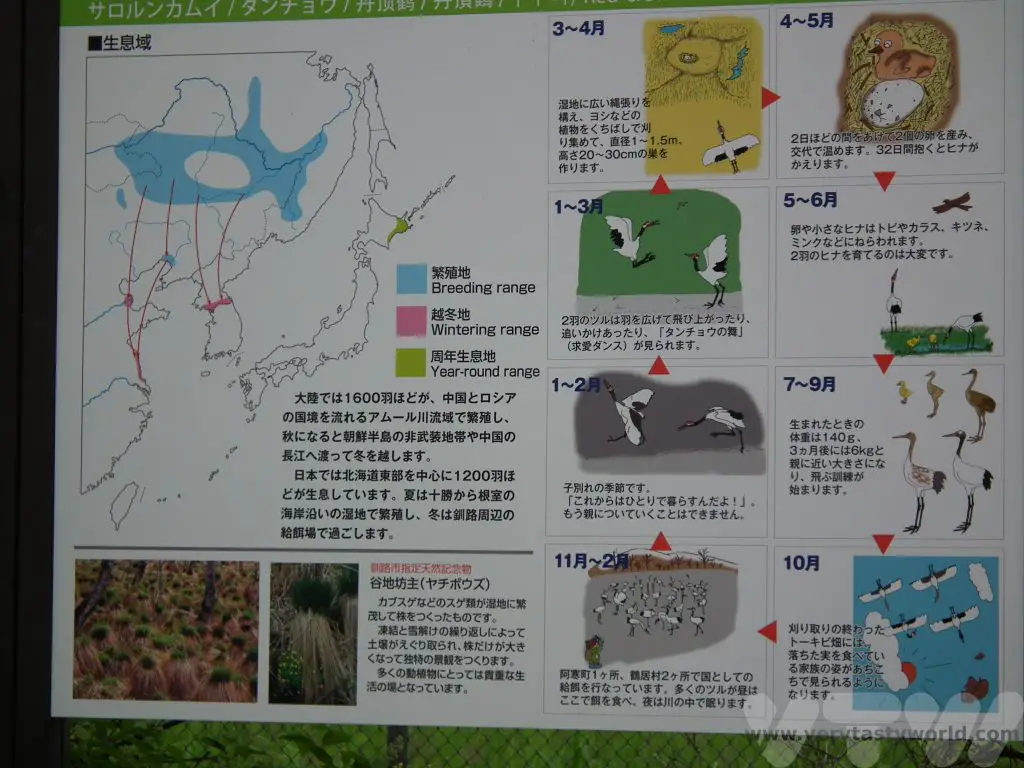
The cranes almost became extinct during the 20th century and remain on the endangered list. The centre acts as a feeding location for wild cranes and also has a number of captive cranes which are held in as natural an environment as possible making it possible to see the cranes all year round.

If you want to see them dancing in the snow you need to visit in winter but be prepared for loads of tourists with very expensive cameras who are all vying to snap that elusive shot of the crane couples’ fascinating dances.
The birds are able to breed. It was rather lovely to see one of the newest arrivals.
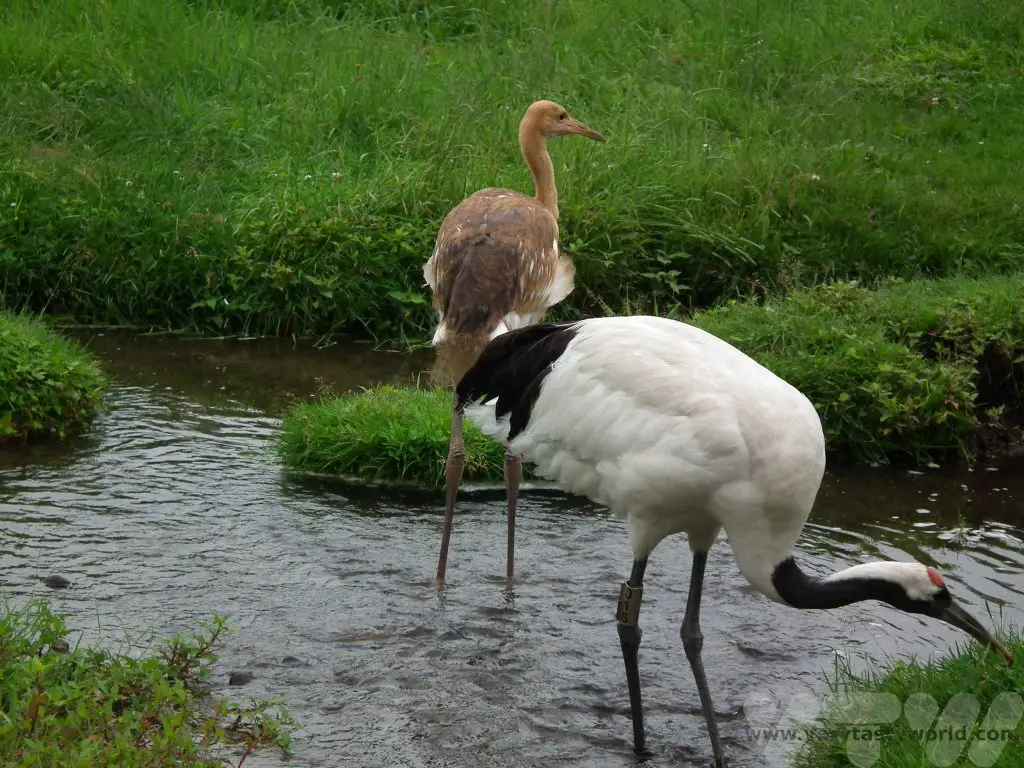
Hokkaido Red Crowned Cranes Souvenirs
And what point is there in a visit to a local tourist attraction to see Hokkaido red crowned cranes without indulging in some edible souvenirs? Made from local ingredients, you can buy ‘crane egg’ omiyage (souvenir gift), which come in presentation box.
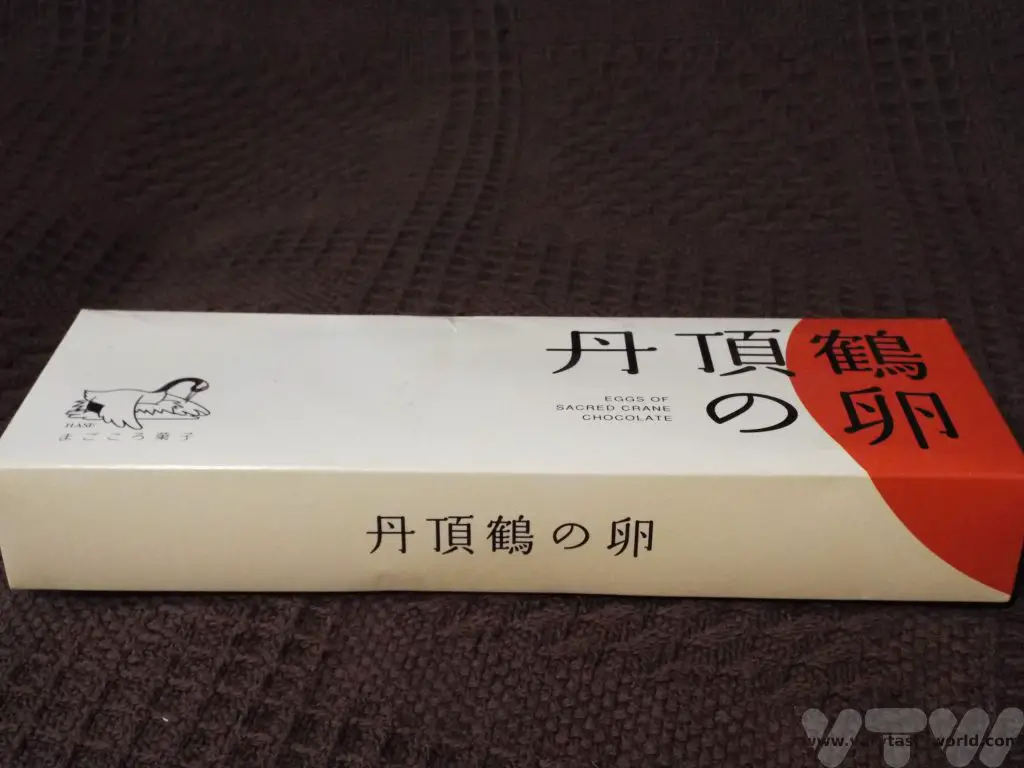
Each cake is individually wrapped with a crane logo and, on opening up each wrapper the eggs don’t look as though they survived the journey home! However, any cracks in the shell caused by a slight crushing in our rucksacks as they endured a 24 hour journey home just added to their charm.
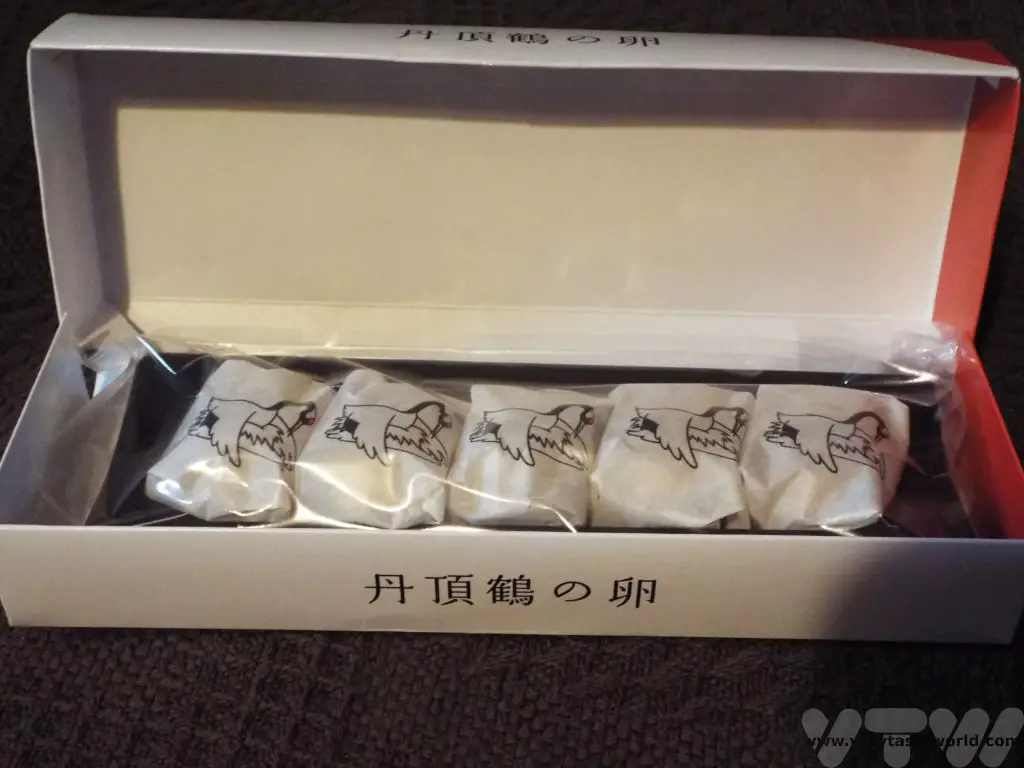
The egg’s shell is chocolate which coats hollow cake, and a soft smooth bean paste moulded into a sphere represents the yolk. The flavours are very subtle and not over-sweet. Our only complaint would be that they are much smaller than actual crane eggs and vanish in just three bites.
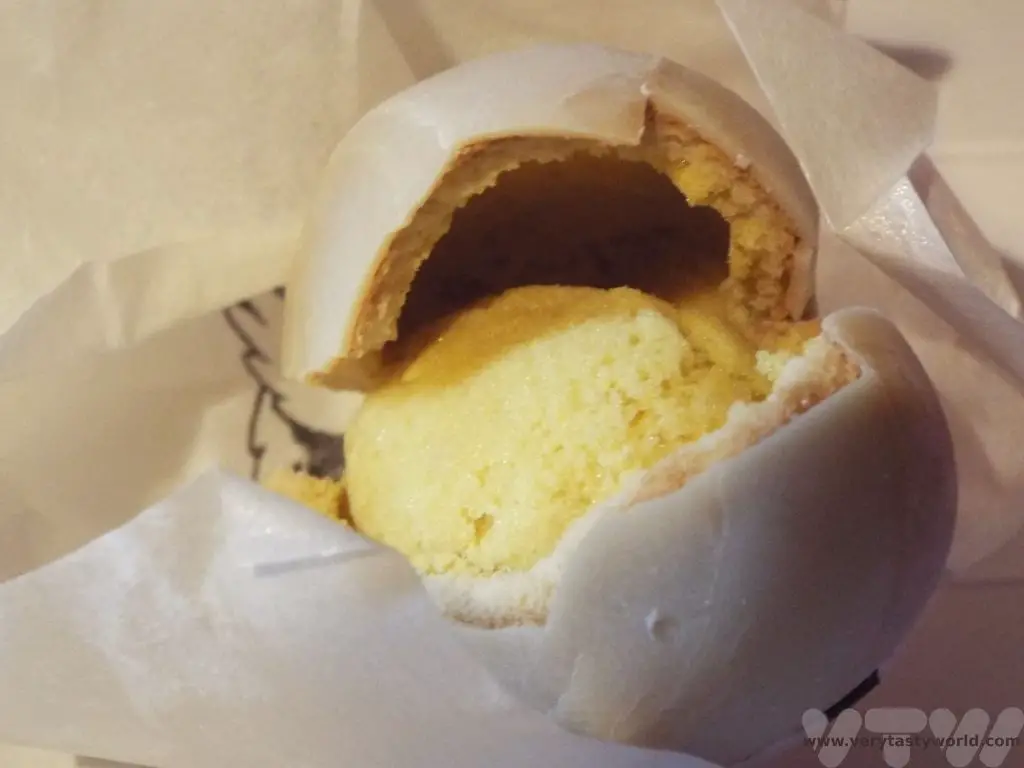
Related Posts You May Enjoy

- Recipe: Simmered Shiitake Mushrooms

- How to Use Public Transport in Japan

- RECIPE Oyakodon Donburi

- Planning a Trip to Japan

- The Makanai: Cooking for the Maiko House

- Setsubun Food – Bean Throwing Day

- The Gassho Farmhouses of Rural Japan

- Recipe: Japanese Simmered Pork Belly – Buta no Kakuni

- RECIPE: How to Make Umeboshi

Osaka Okonomiyaki – As You Like It
Osaka okonomiyaki is often described as the Japanese equivalent of a pancake-pizza hybrid. You can see why it would be given that description – it has a pancake-type batter based around cabbage (but don’t let that put you off) with a variety of toppings – meat, fish, egg or veggie based – to choose from.
Osaka in the Kansai region is one home to okonomiyaki, although there other regional variations. (Hiroshima, for example, uses udon noodles in the pancake batter.) The city itself is bright and bustling, full of friendly locals and has an excellent food scene. The seafood on offer – crab, fugu (puffer fish), takoyaki (battered octopus balls) – is just wonderful, as it is all over Japan.
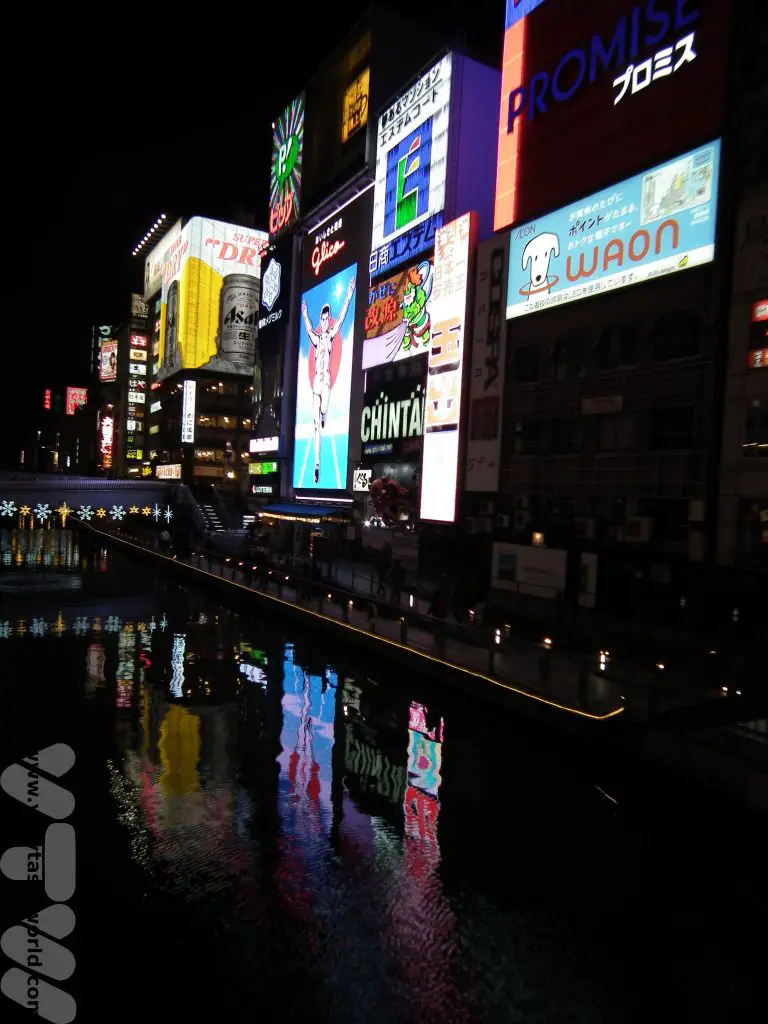
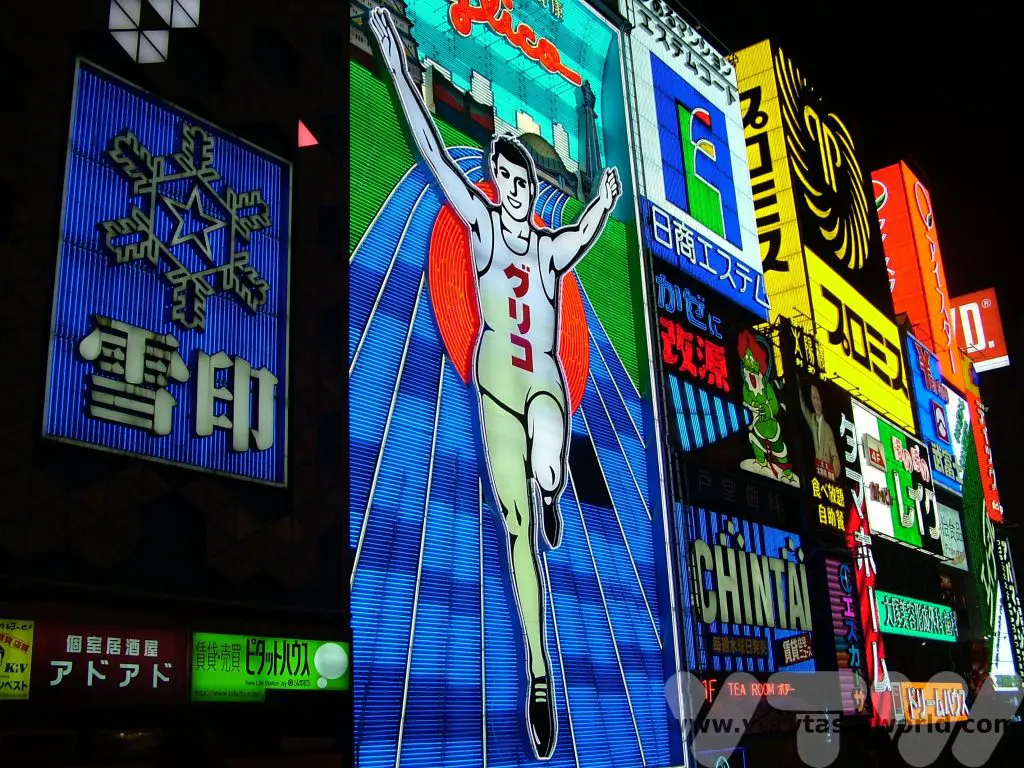
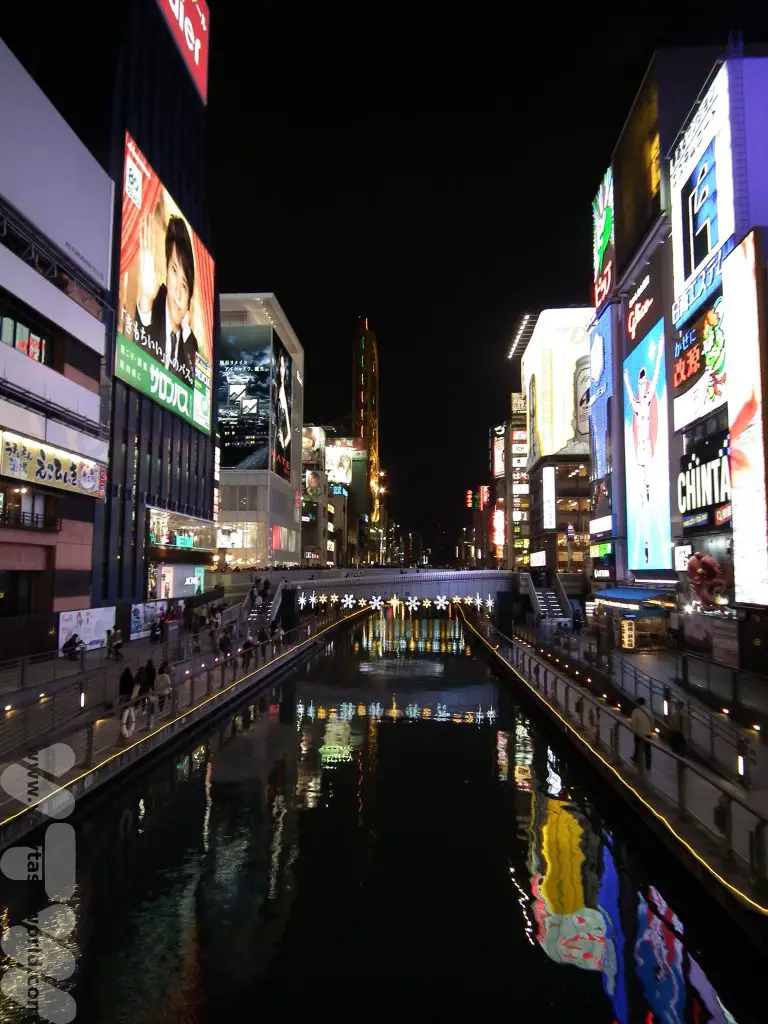
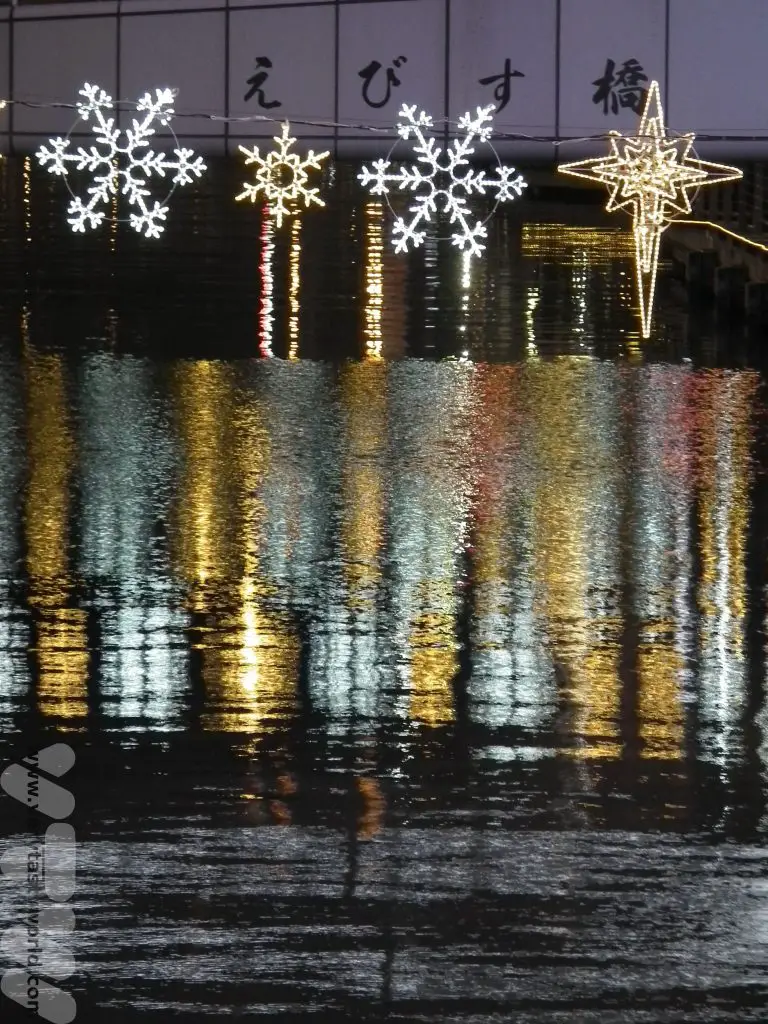
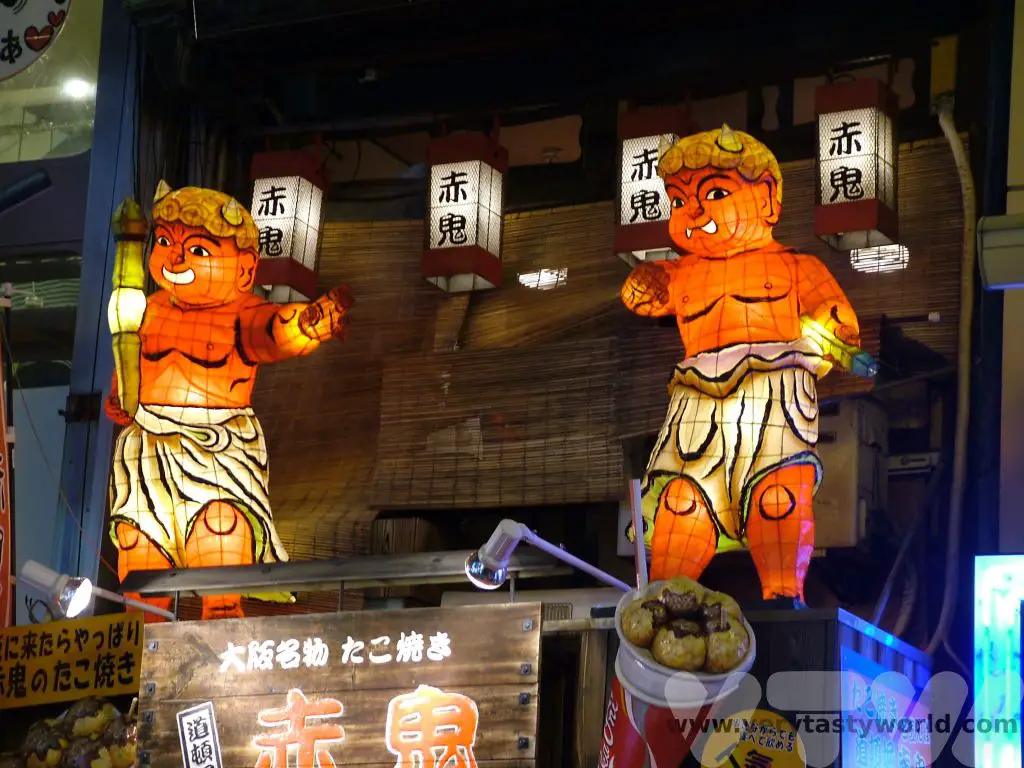
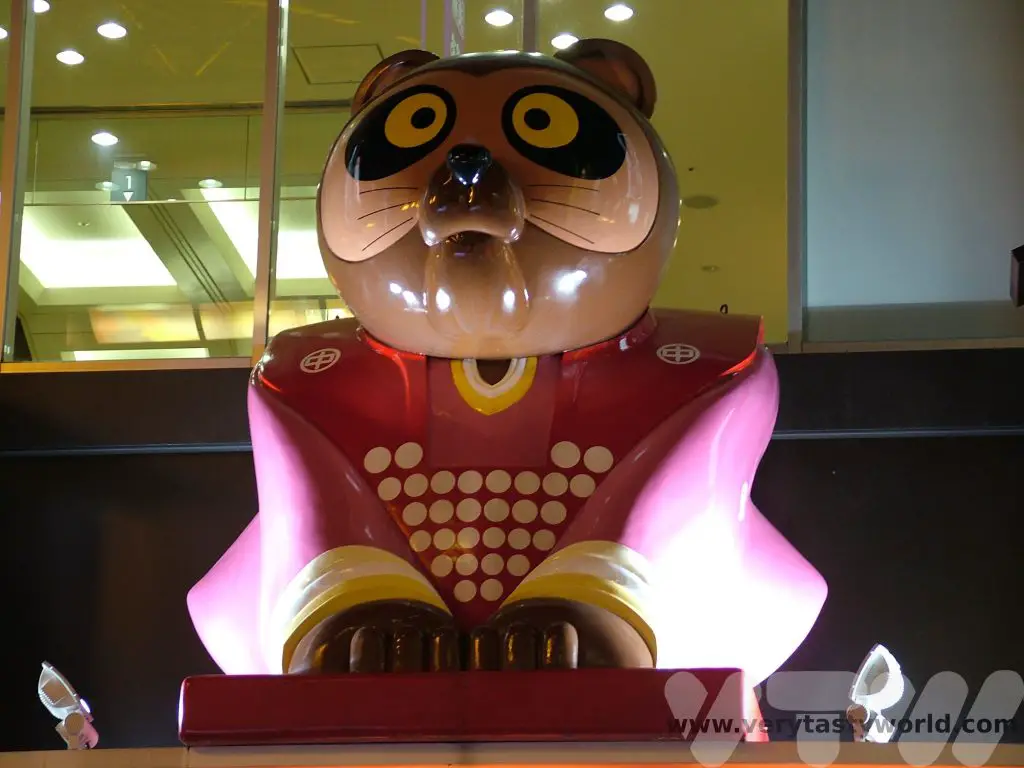
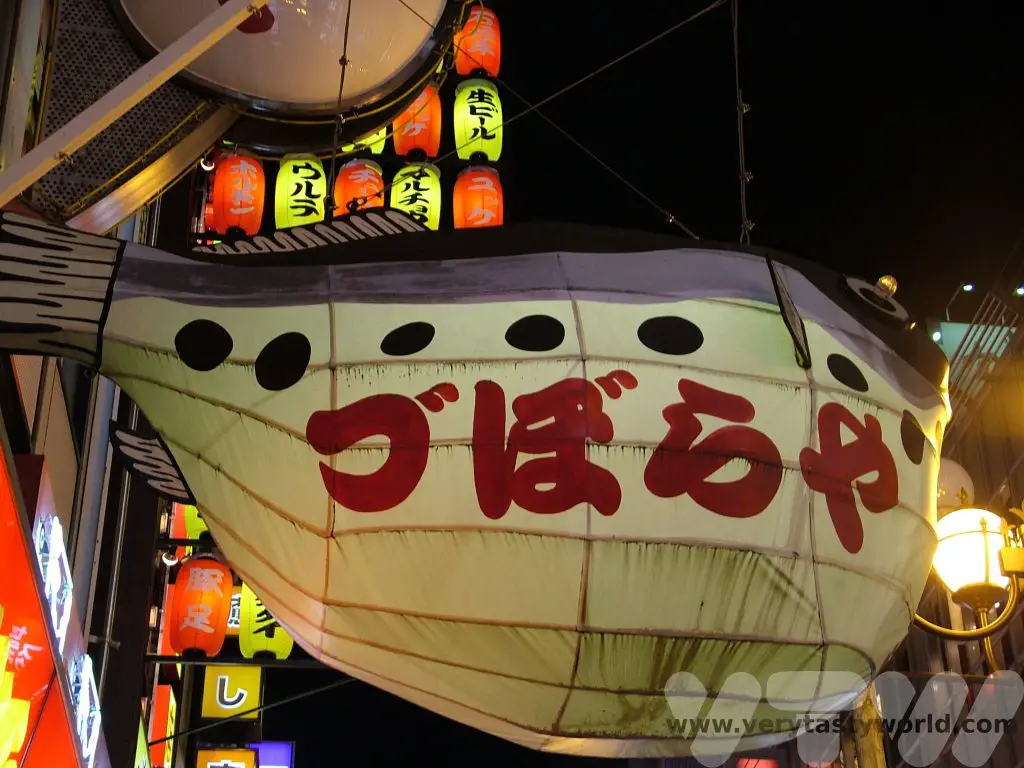
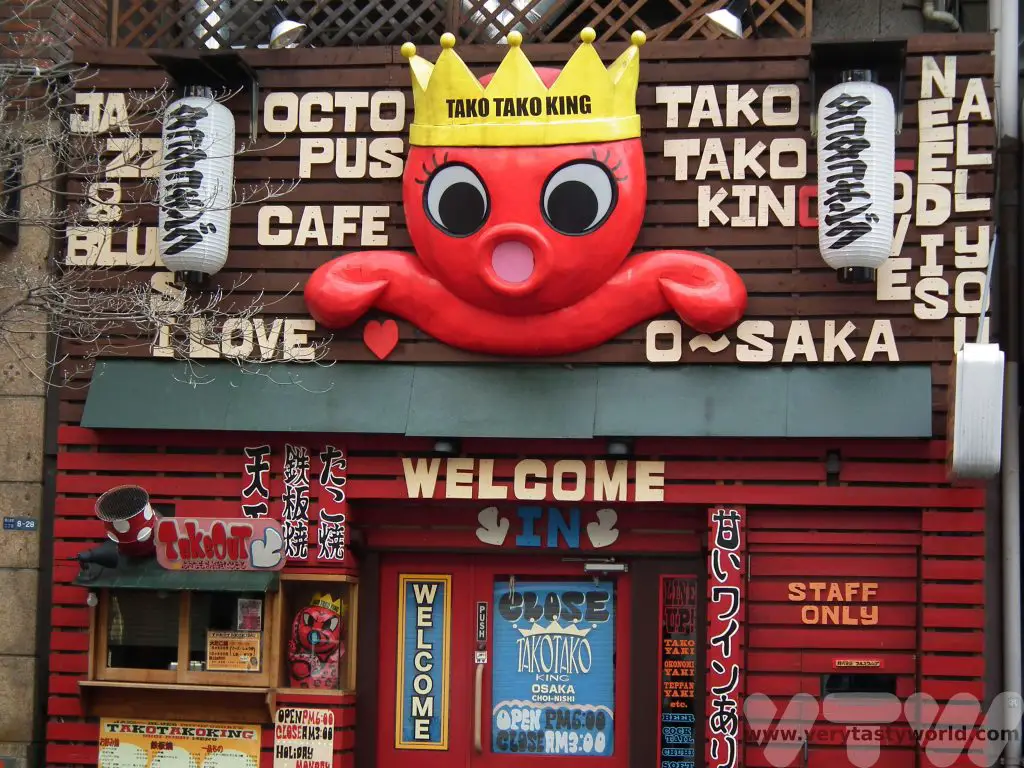
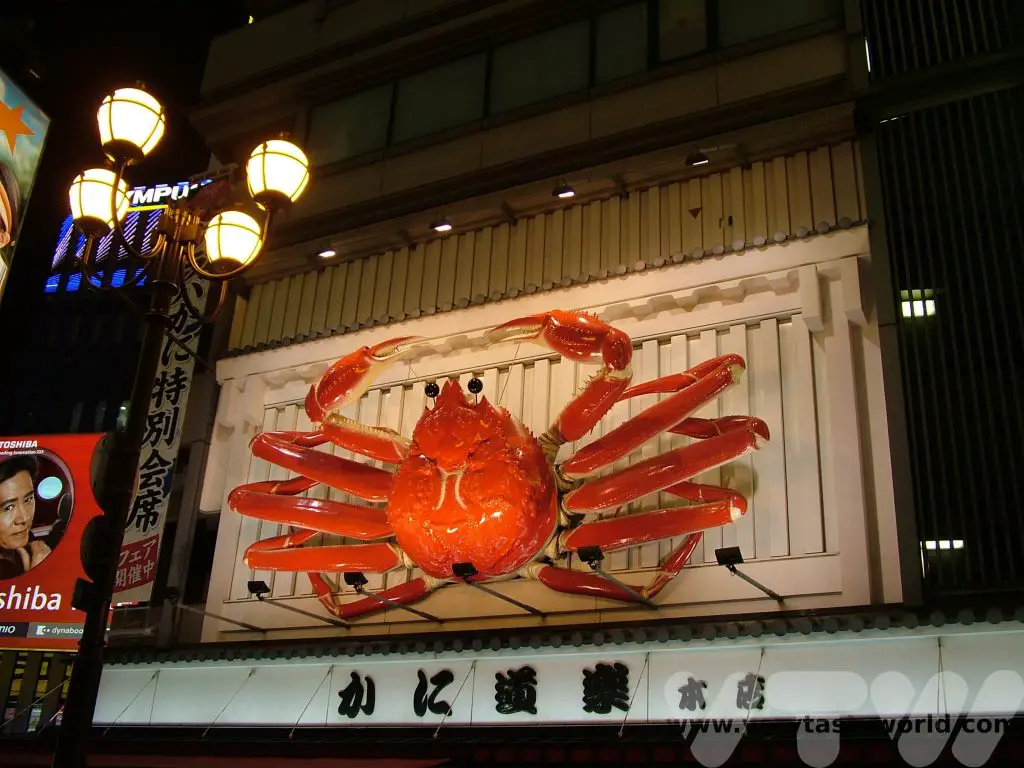
Okonomiyaki In Osaka
There are okonomiyaki restaurants all over Osaka (and indeed all over Japan). They offer a good, cheap eat, that is filling and fun. Part of this fun is that you will see your meal being cooked in front of you. In some restaurants they will even let you cook it yourself!
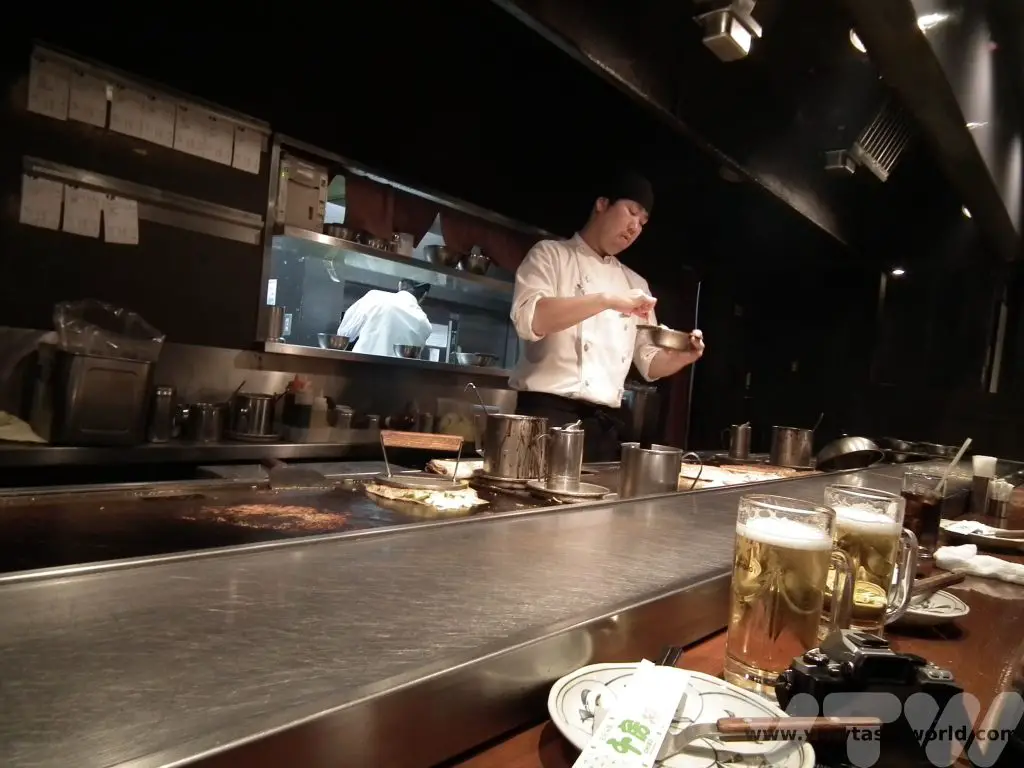
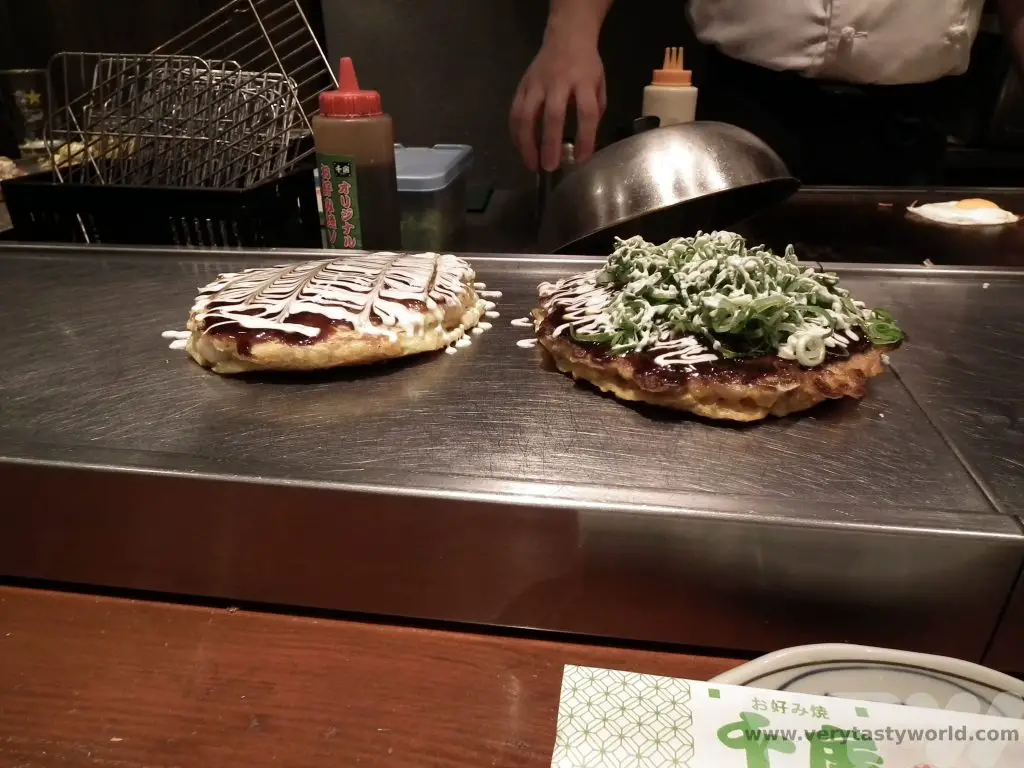
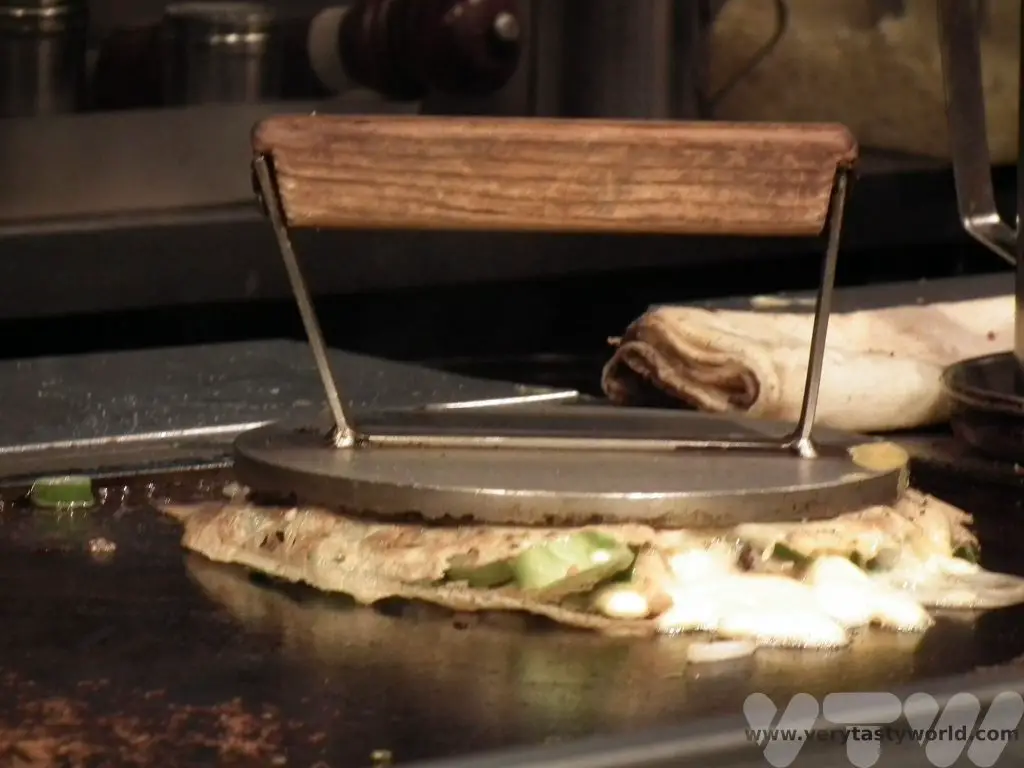
The term ‘okonomiyaki’ actually derives from ‘okonomi’ – favourites, ‘yaki’ – grilled. There are three basic elements to the dish:
The pancake base which comprises flour, eggs, dashi (stock), yam powder (optional) and cabbage. The fabulous Osaka all-female pop-punk band Shonen Knife, who have been touring since the early 1980s and are still going strong, love okonomiyaki and have a recipe for it in their Shonen Knife Land book. Naoko, the founding member of the band, recommends a cabbage cutting technique: ”Finely chop the cabbage. It should be in small square pieces maybe about 3mm long.It would take a lot of time and be a lot of trouble if you use a ruler to measure the pieces, so it’s OK to just guess.”
Fabulous Fillings
The filling can basically be anything you like – that’s where the ‘okonomi’ comes into its own. Favourite fillings can include sliced pork or beef, shrimp, squid, konnyaku (a gelatin textured food, also known as Devil’s Tongue) and vegetarians may enjoy pretty much any veg they can think of. Spicy fermented Korean kimchi is great if you decide that there isn’t enough cabbage in the dish already.
The topping is the piece de resistance which adds to both the deliciousness and the sheer joy of okonomiyaki. When asked what topping you would like, we recommend asking for EVERYTHING! Okonomiyaki sauce is a tangy brown sauce (a little like the UK’s HP Sauce), creamy Japanese mayo, chilli sauce for those who like it hot, sprinkles of dried seaweed called aonori, and katsuobushi which are dried & smoked Bonito flakes that wave delightfully in the heat of the pancake. The chefs will go out of their way to make it look stunning as well.
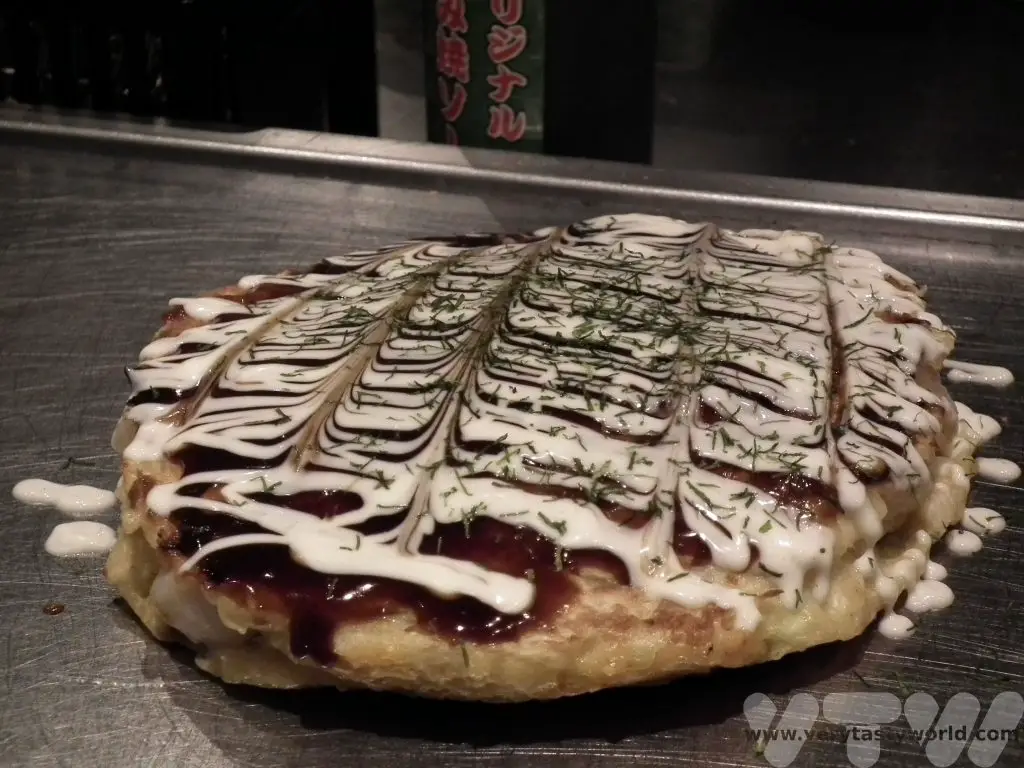
Oh, and there’s also the option of a fried egg!
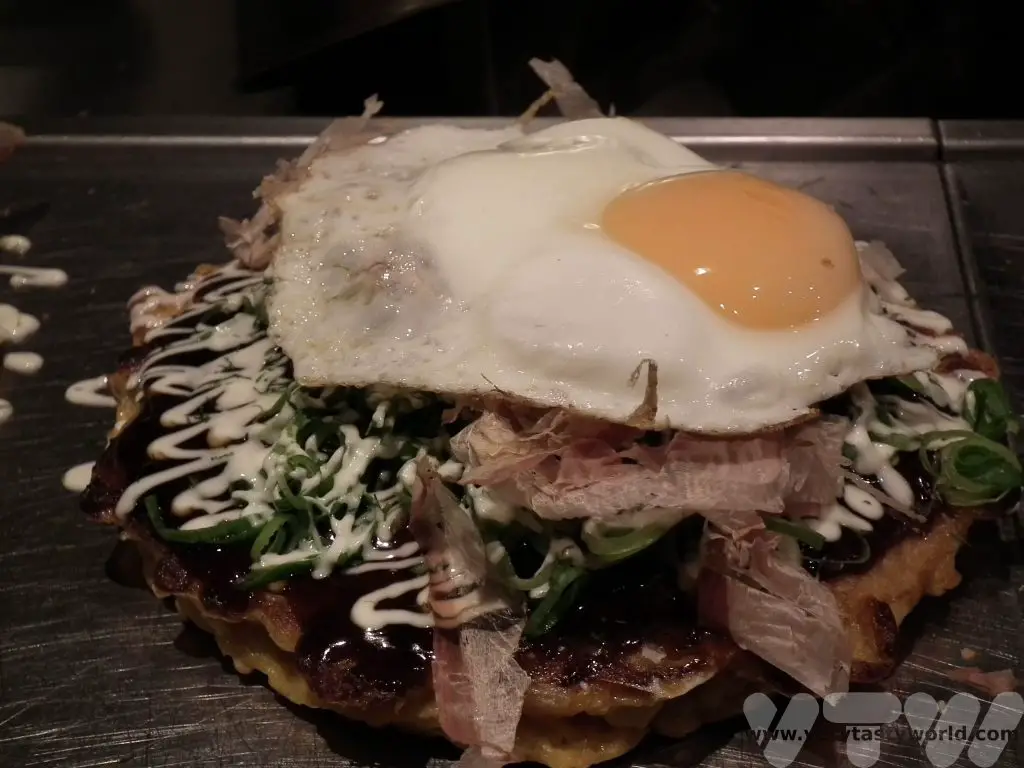
Osaka okonomiyaki is a dish that somehow manages to be both humble and decadent. It’s pretty easy to make at home to
Related Posts You May Enjoy

- Recipe: Simmered Shiitake Mushrooms

- How to Use Public Transport in Japan

- RECIPE Oyakodon Donburi

- Planning a Trip to Japan

- The Makanai: Cooking for the Maiko House

- Setsubun Food – Bean Throwing Day

- The Gassho Farmhouses of Rural Japan

- Recipe: Japanese Simmered Pork Belly – Buta no Kakuni

- RECIPE: How to Make Umeboshi

